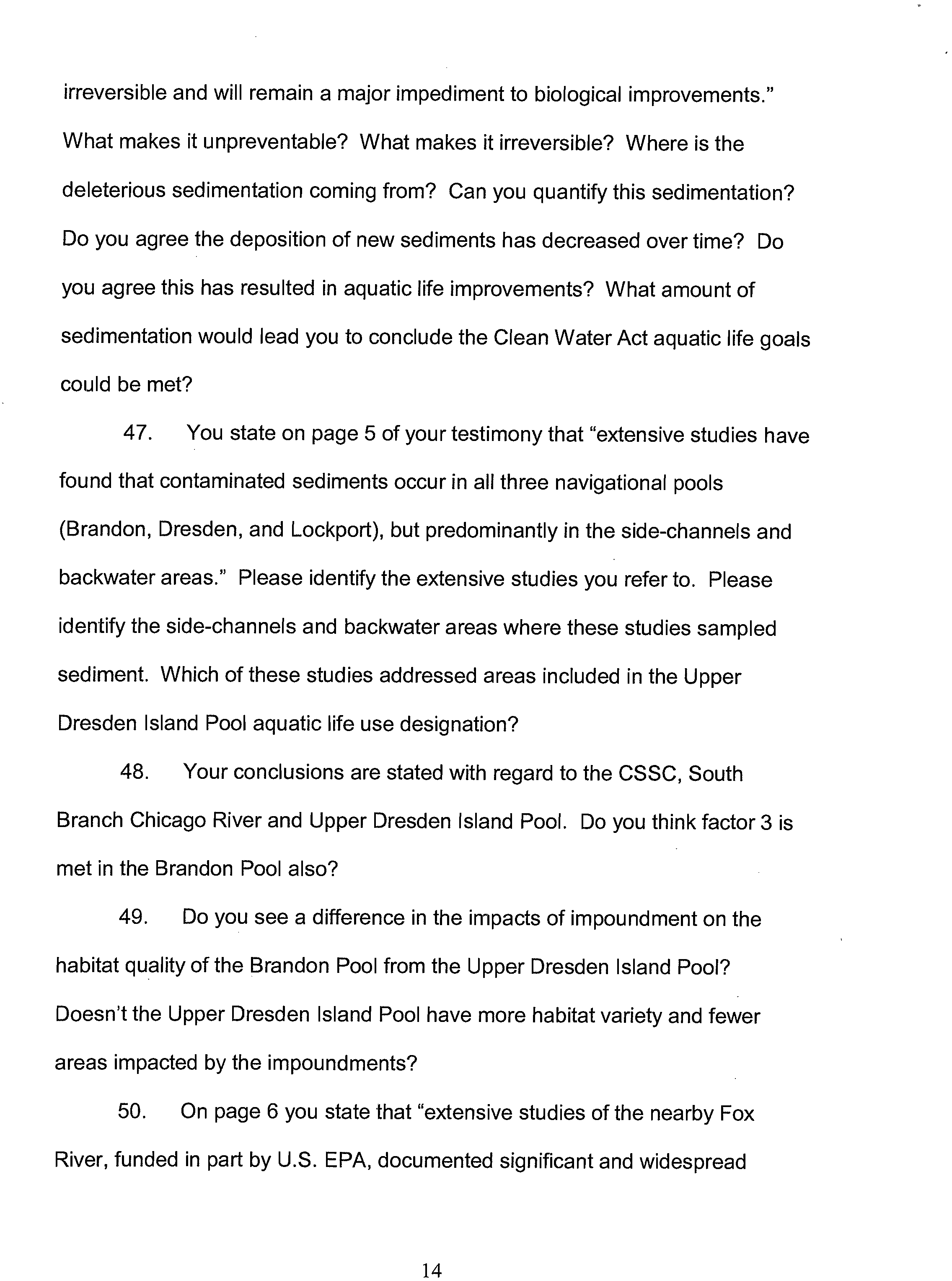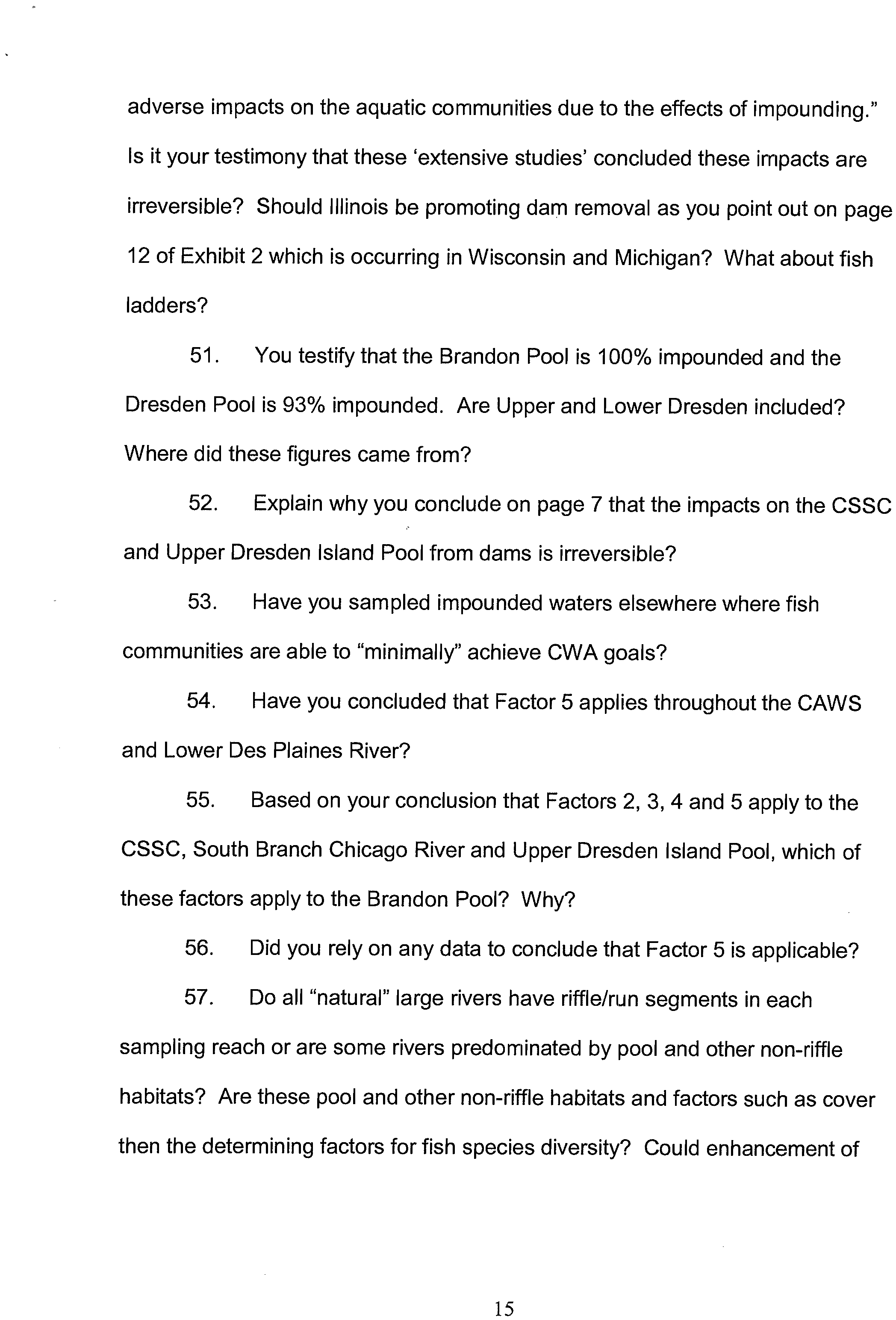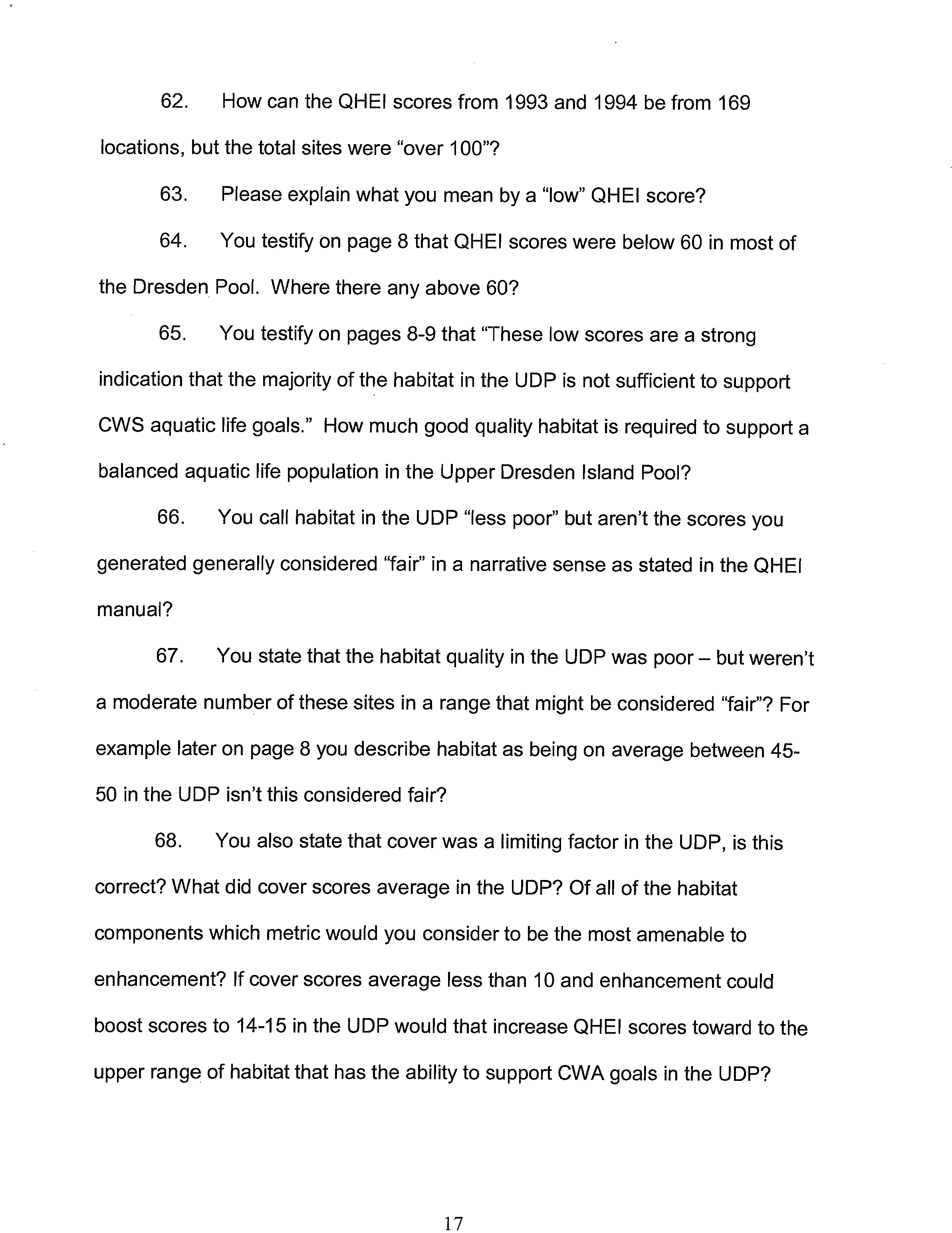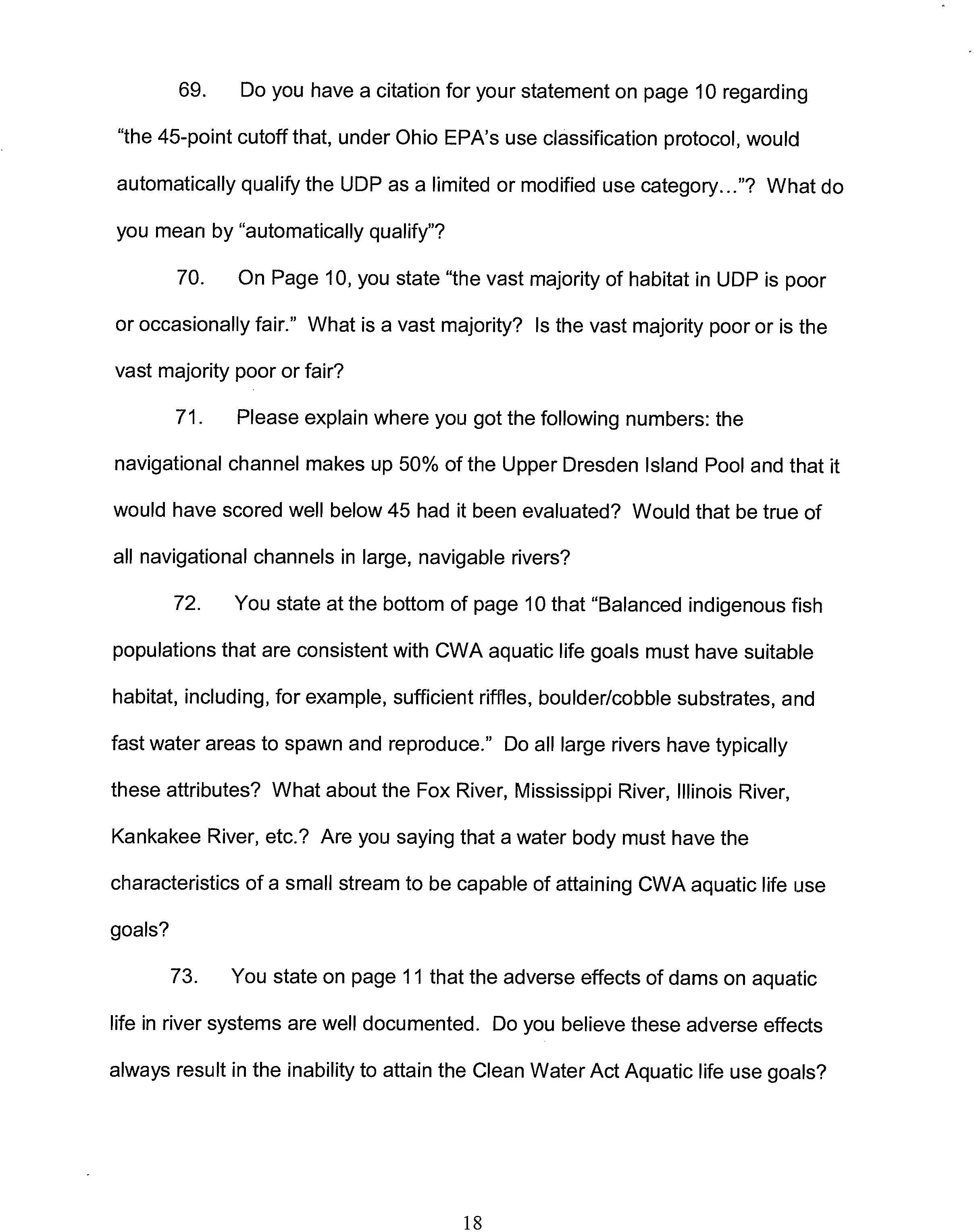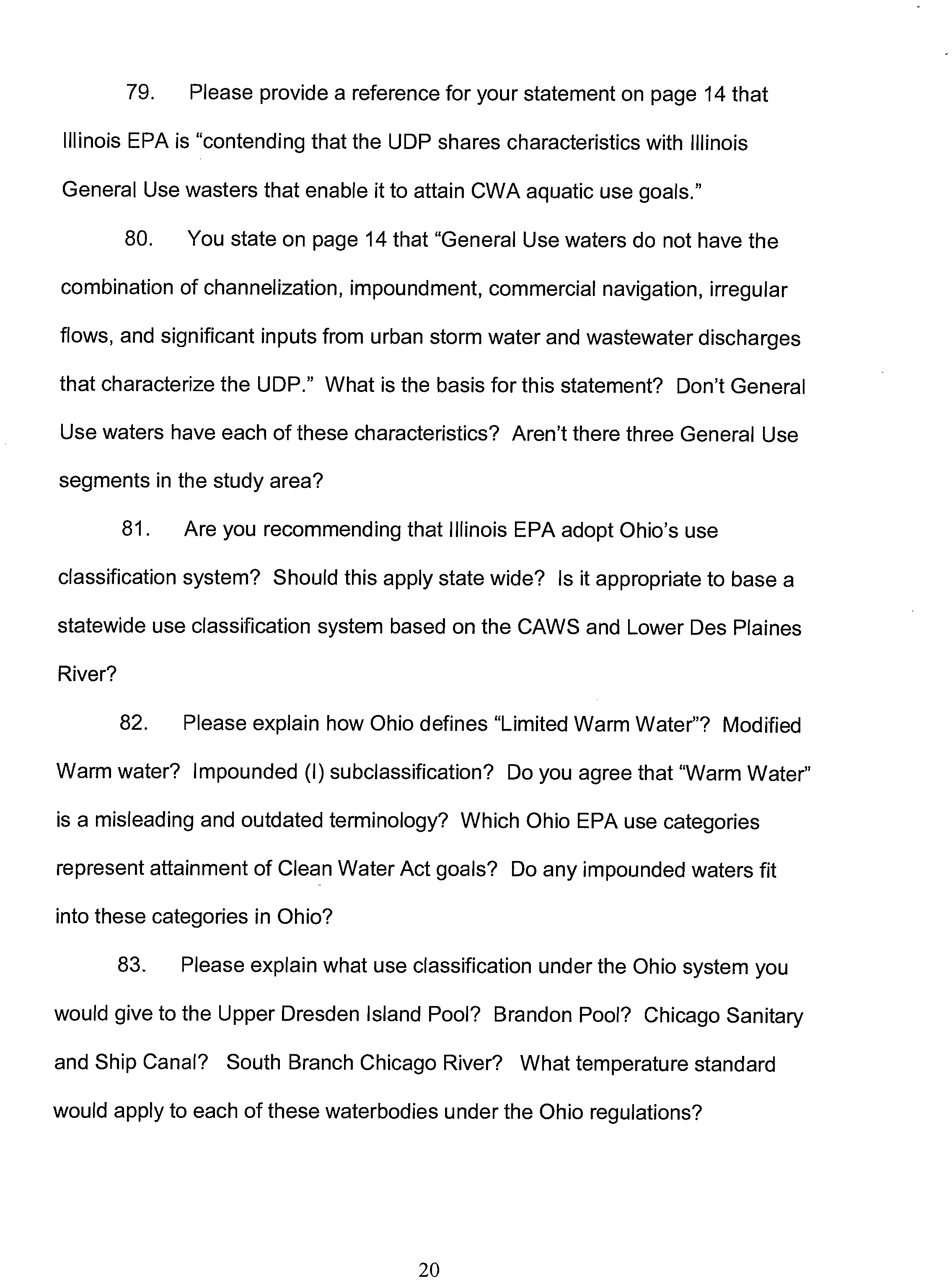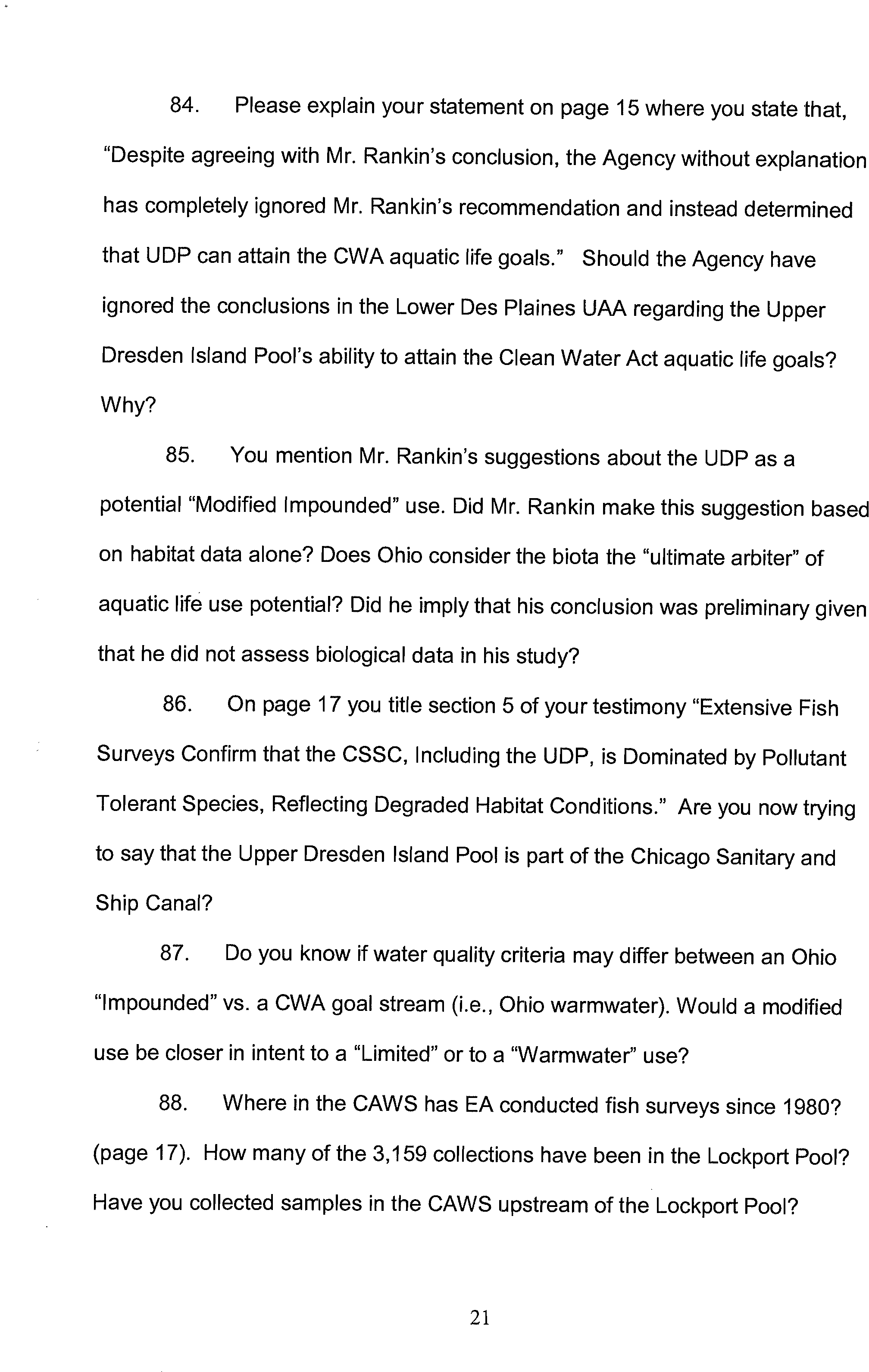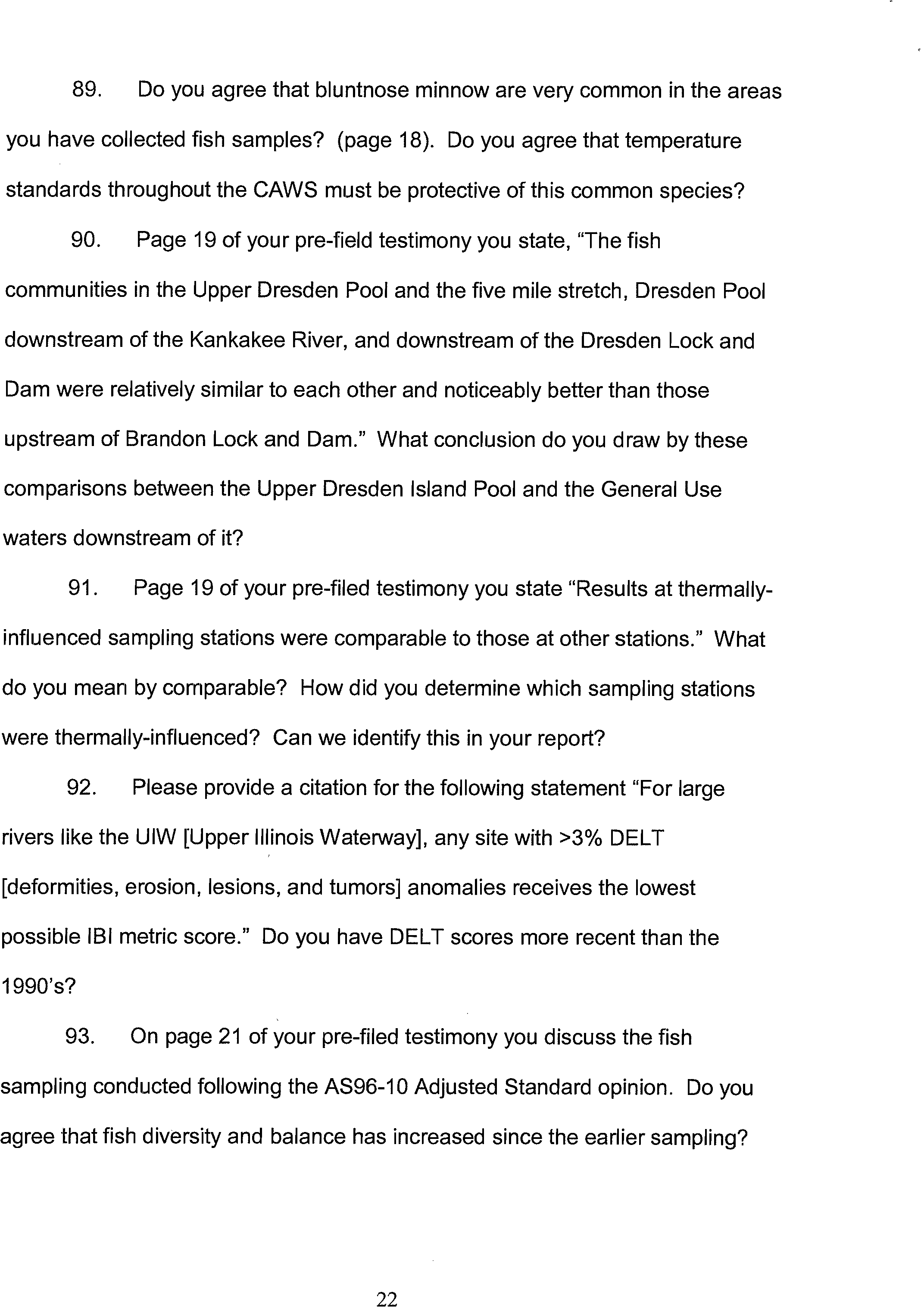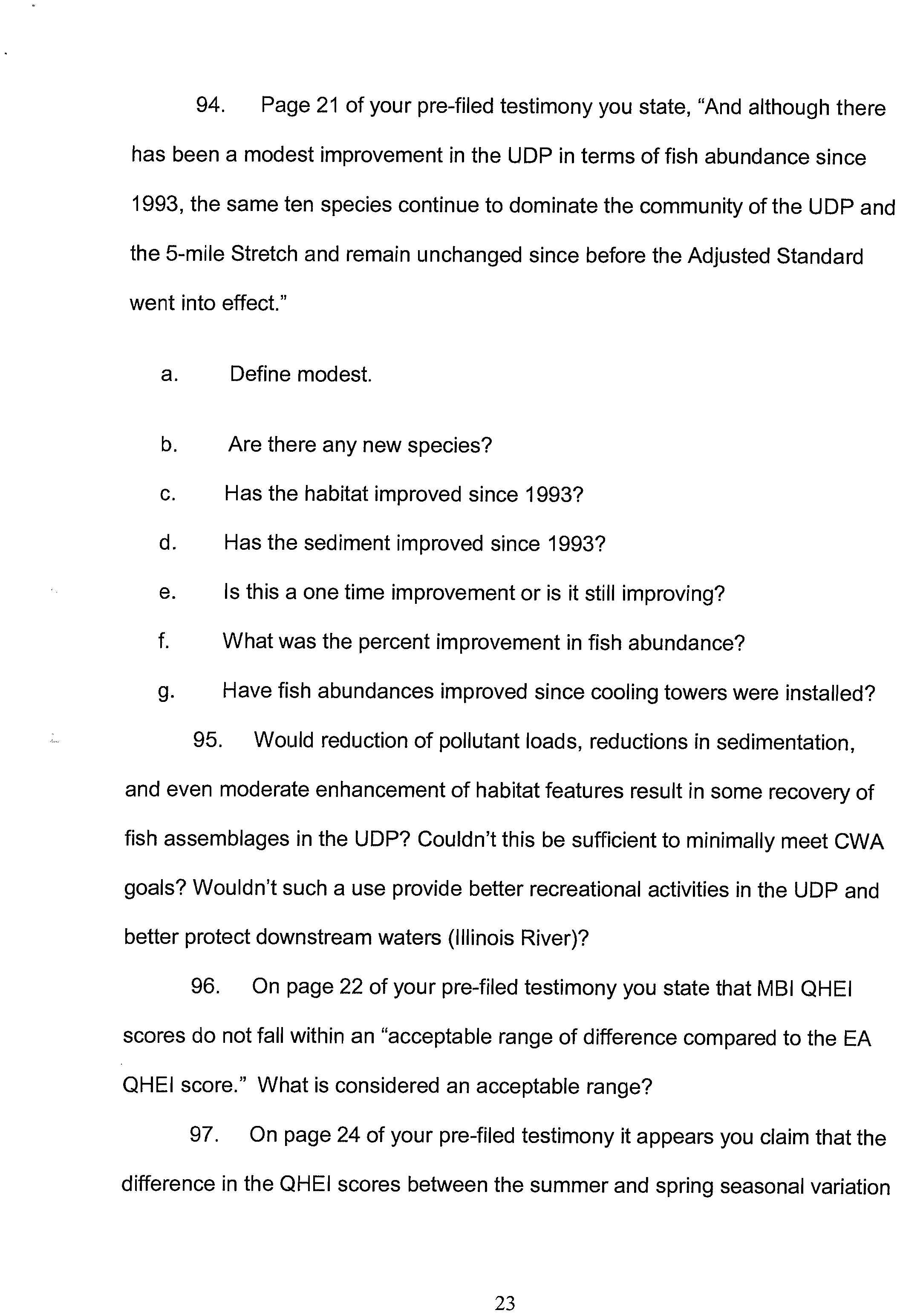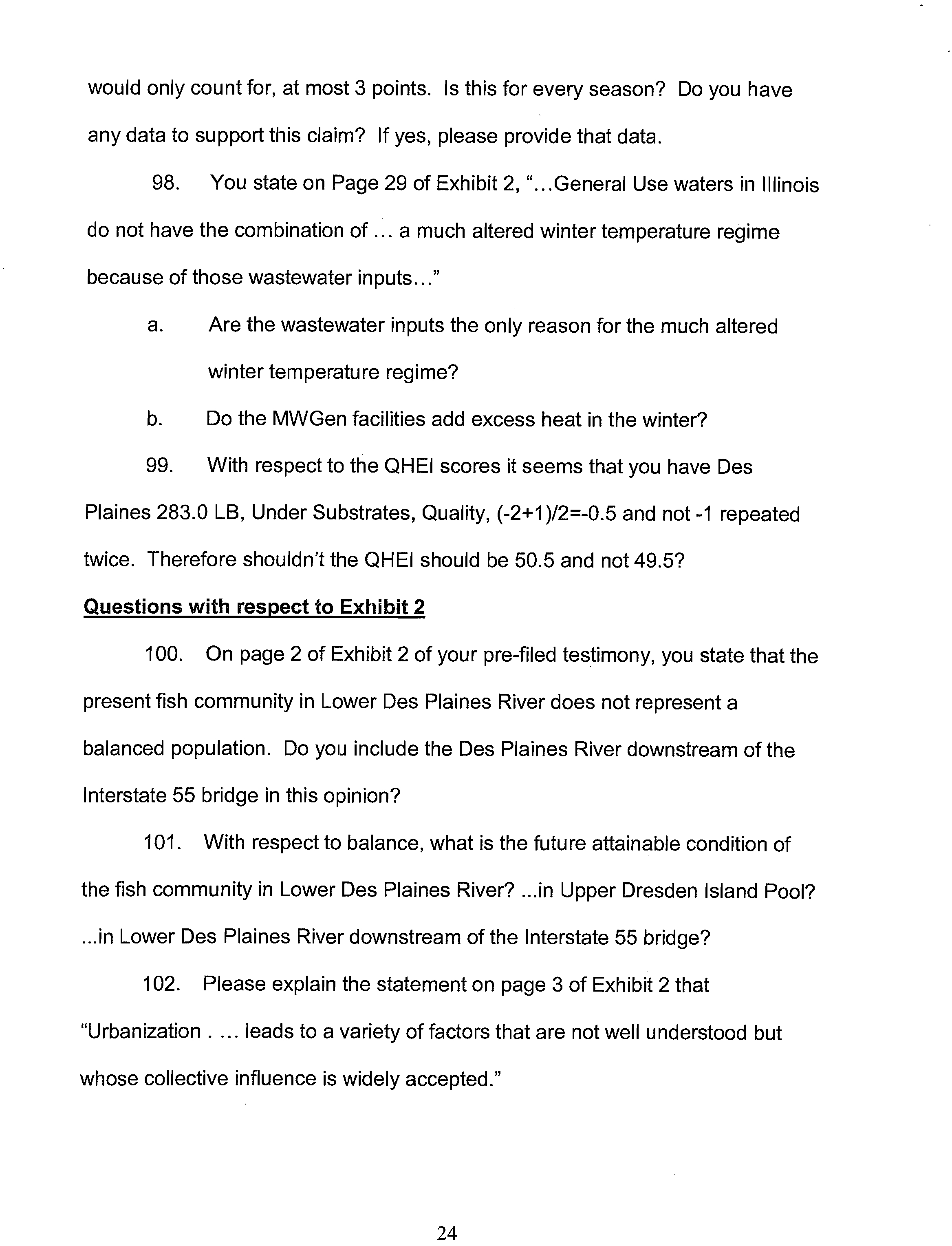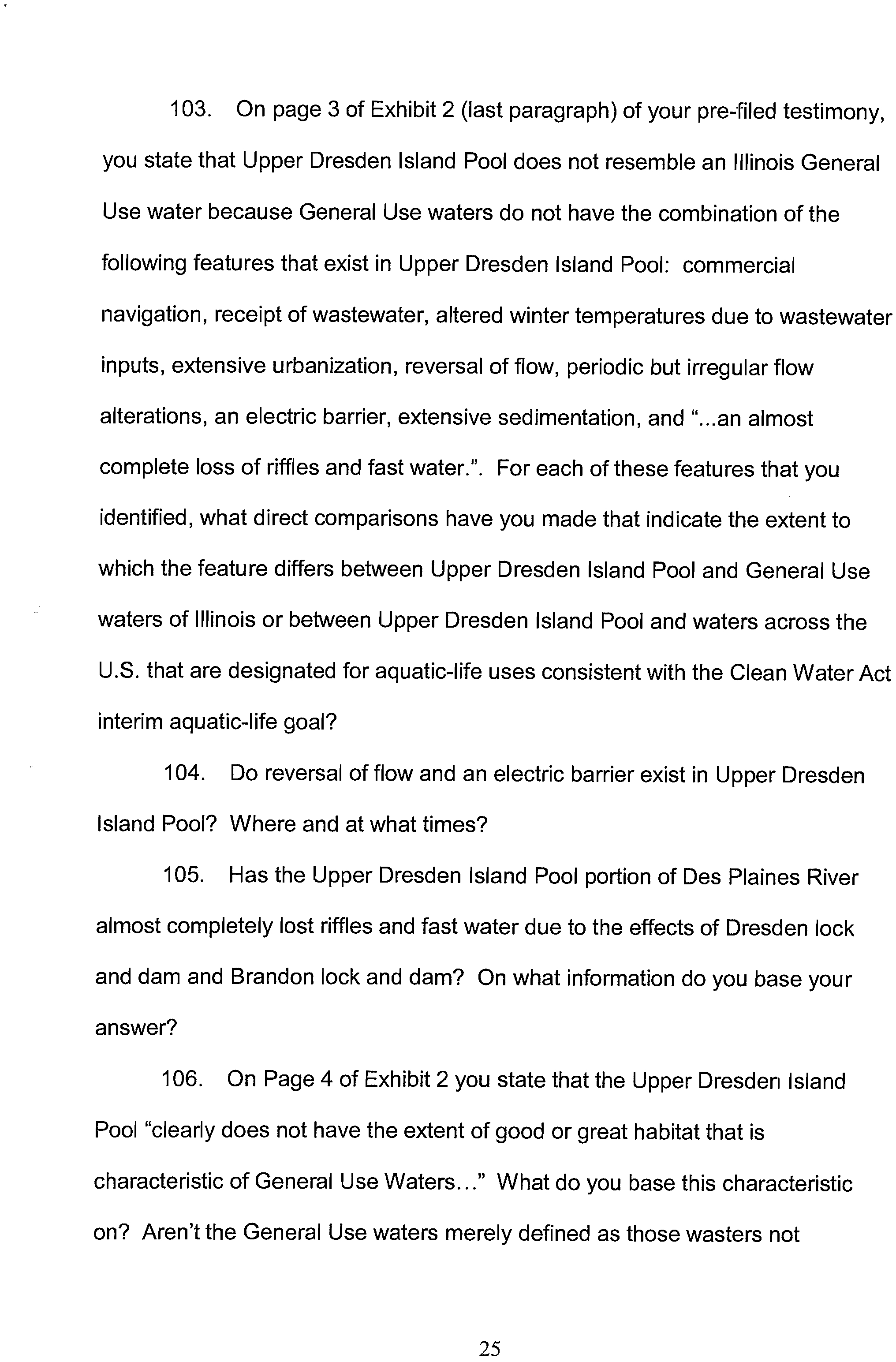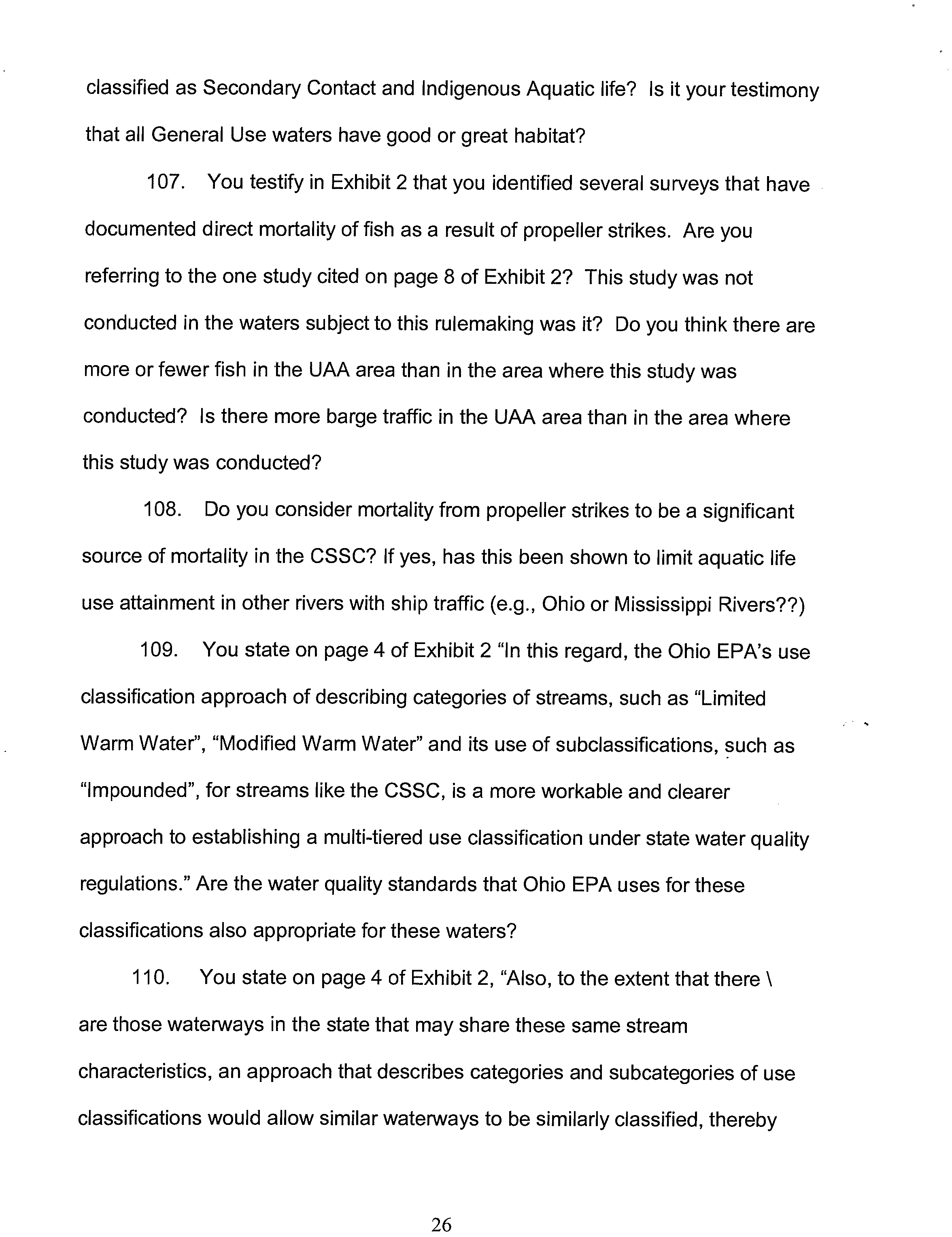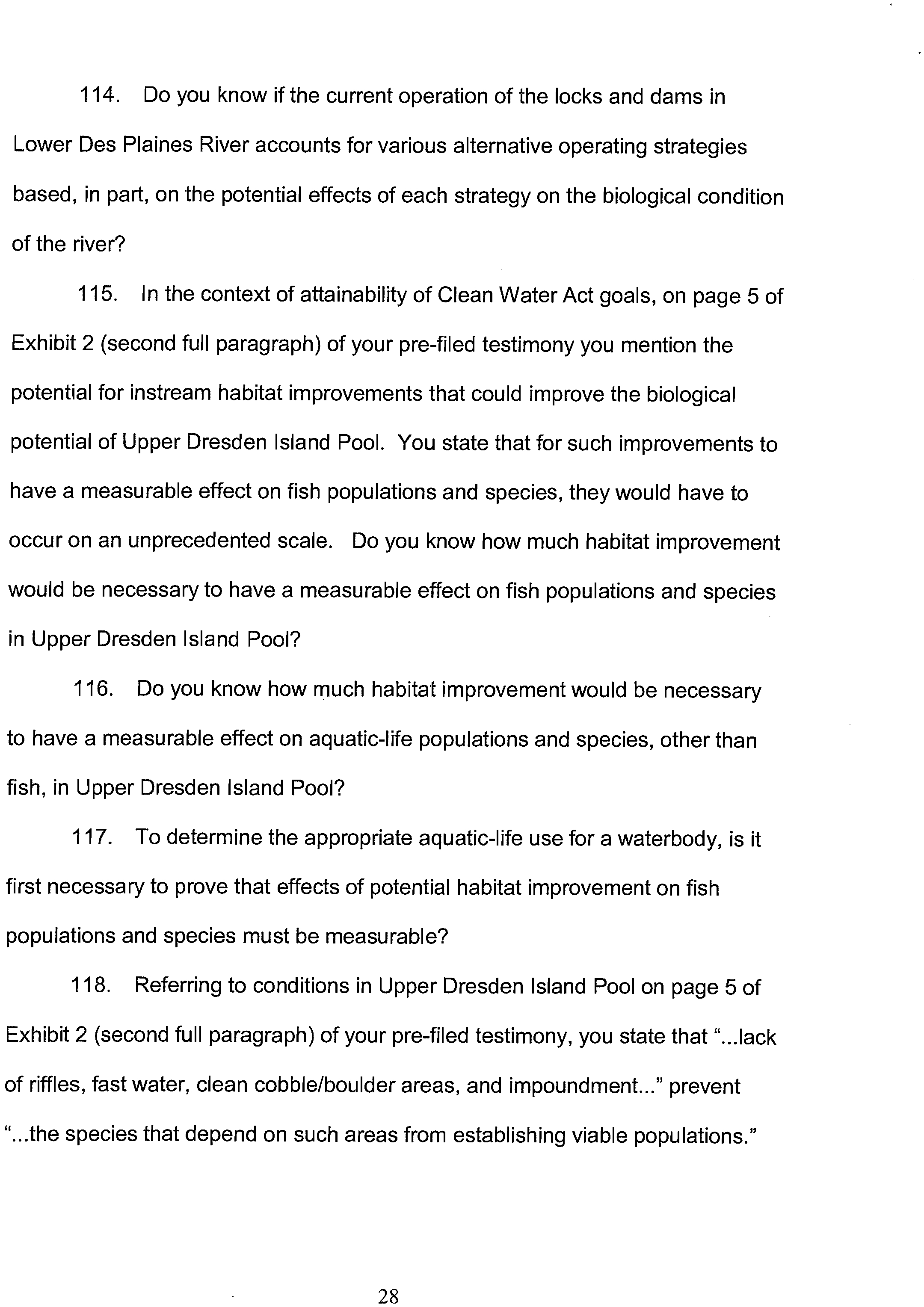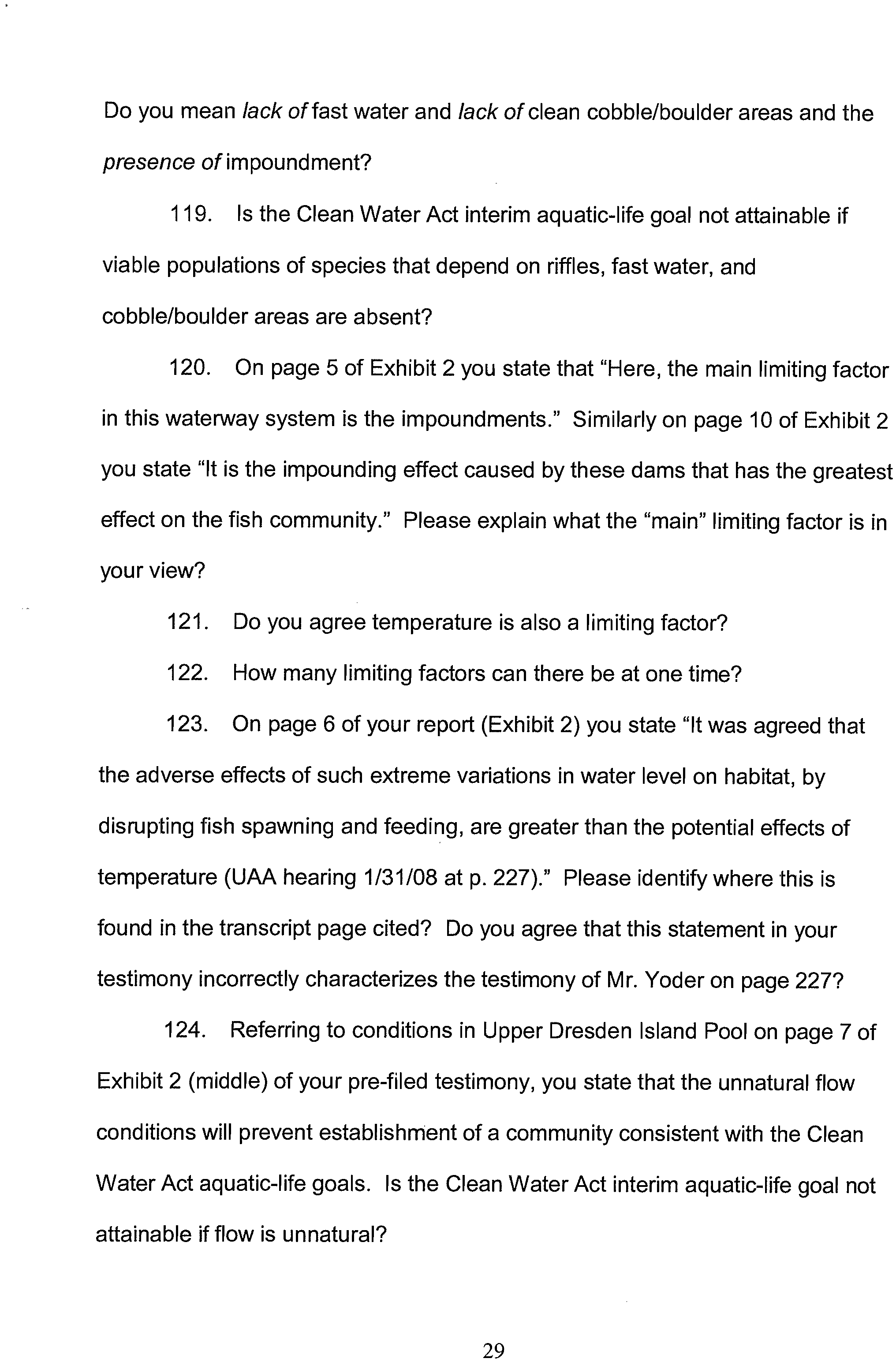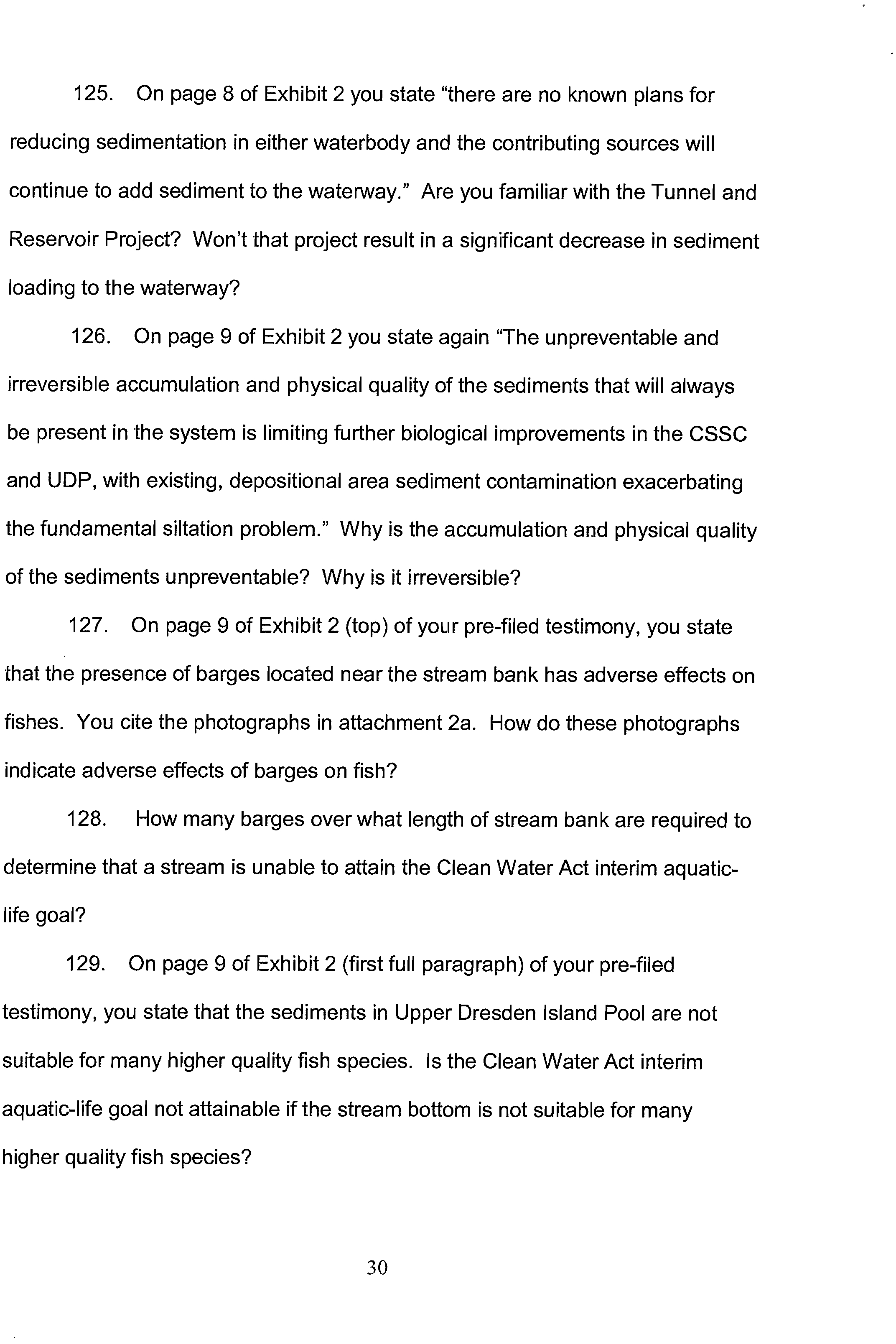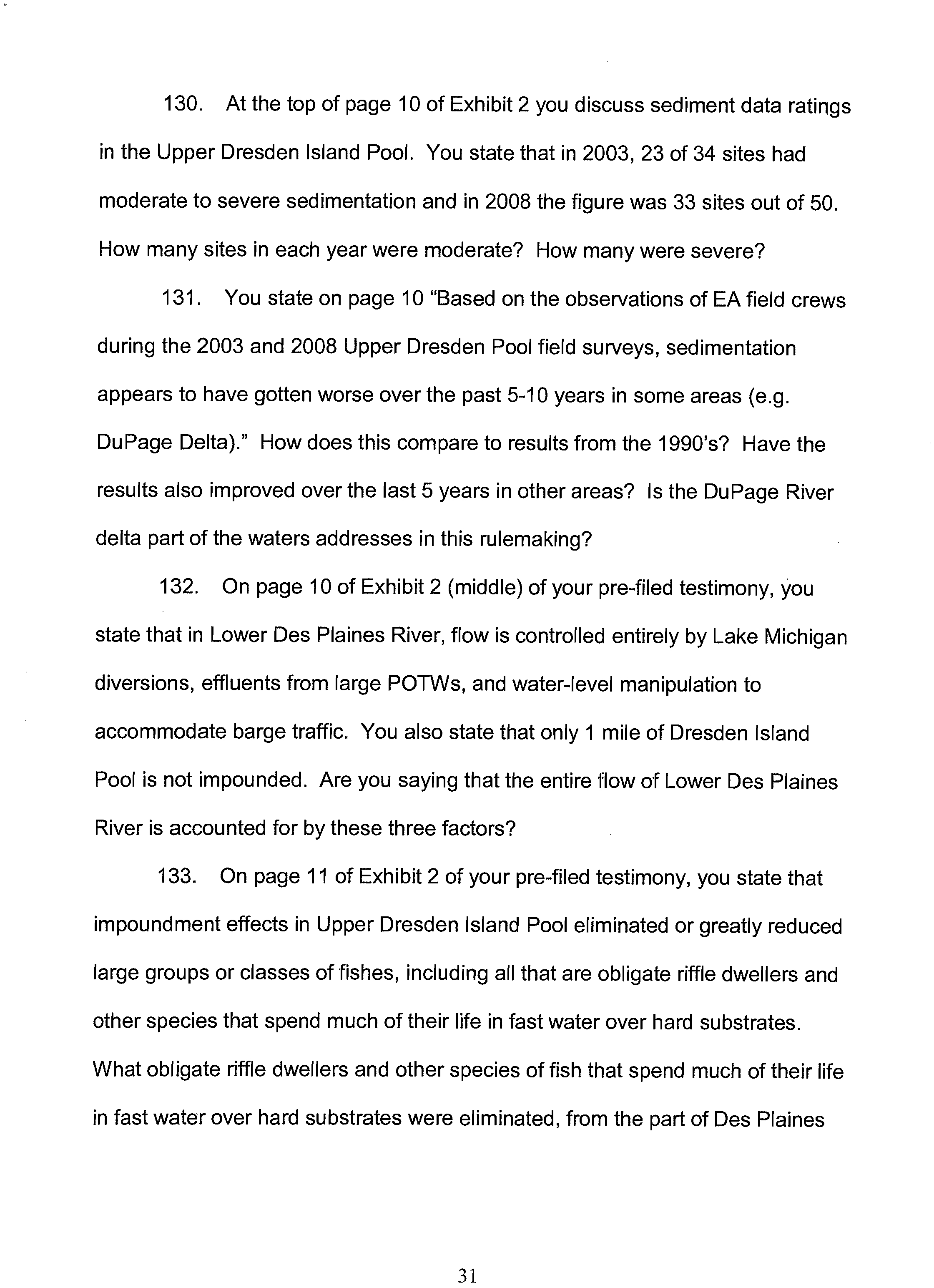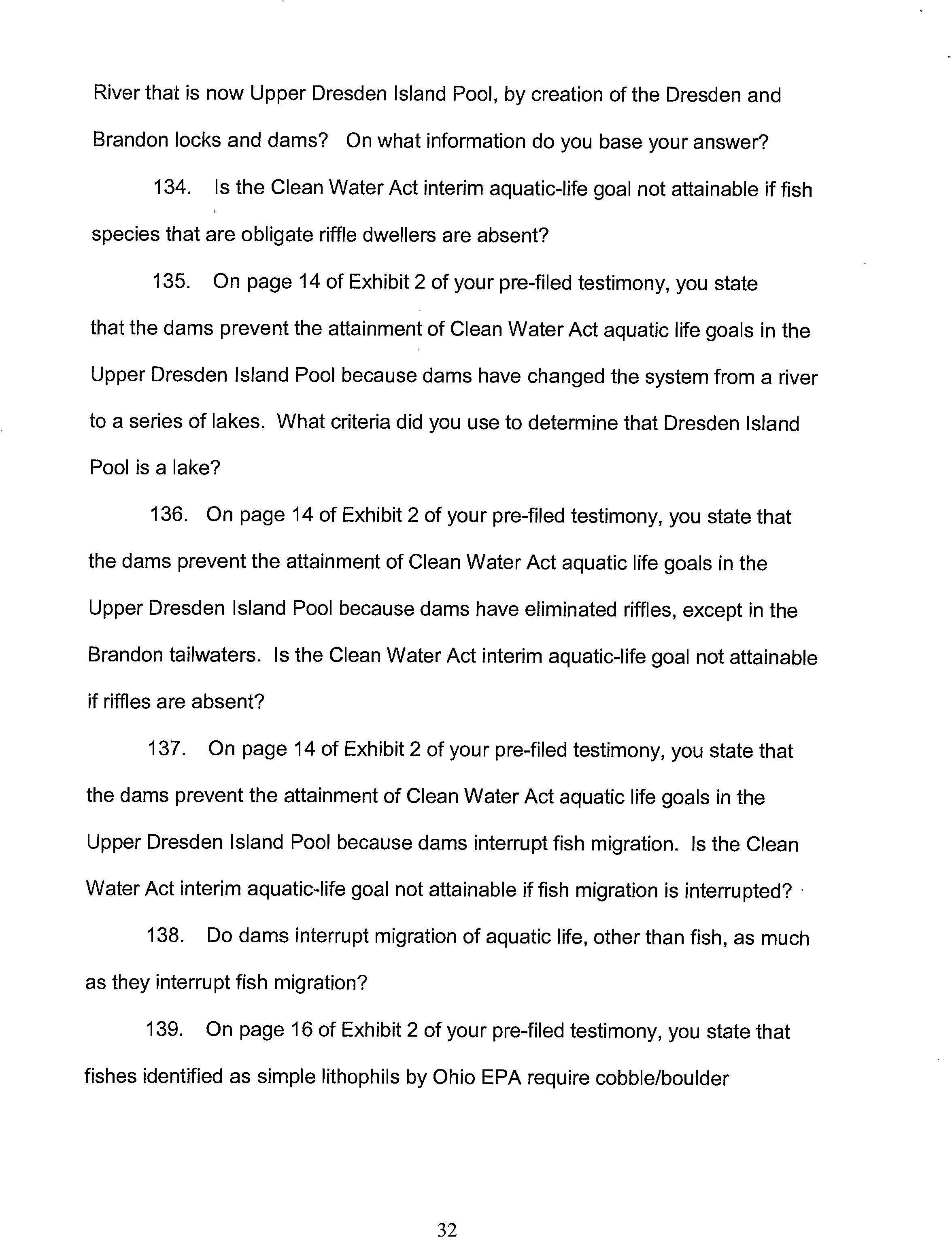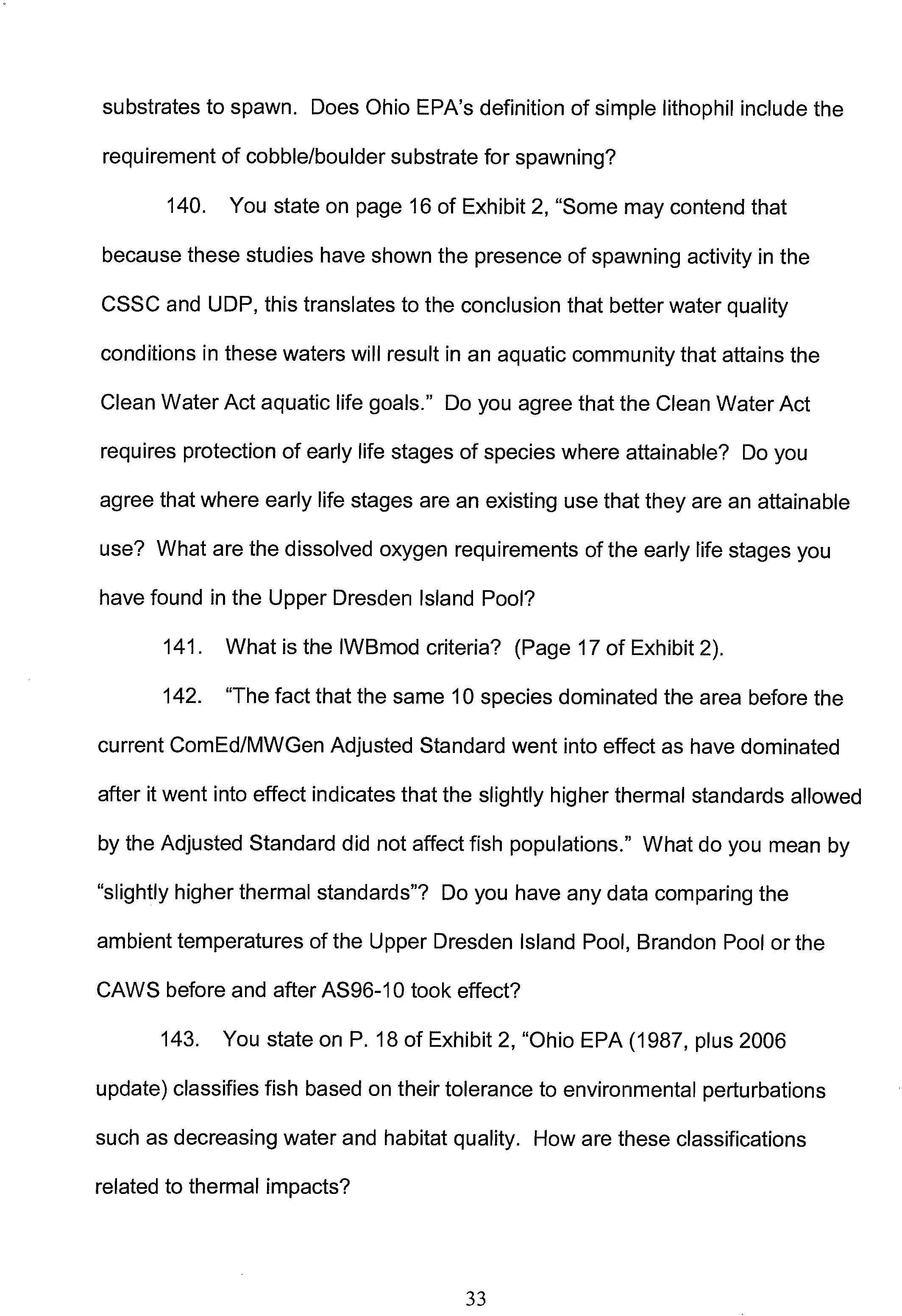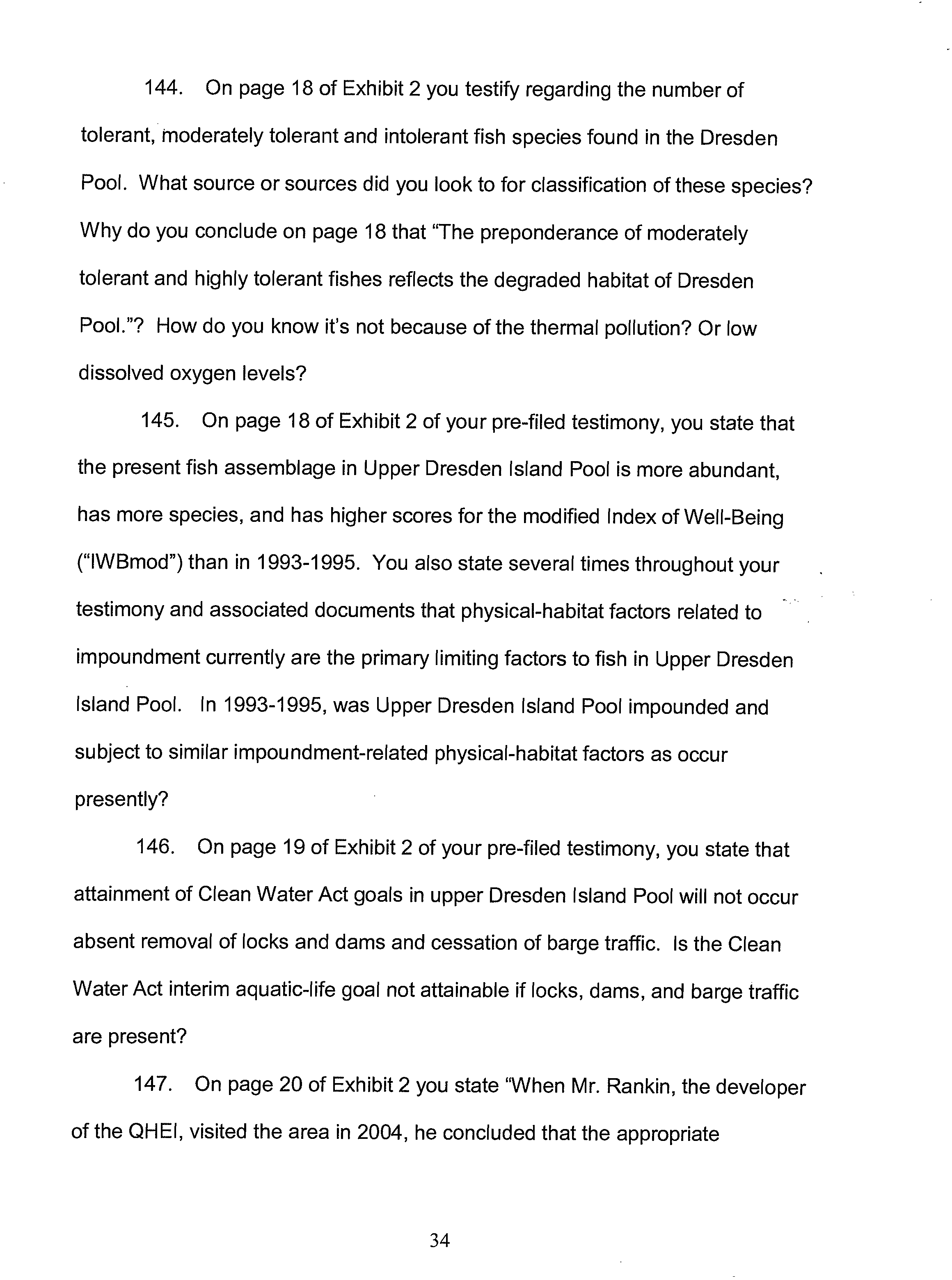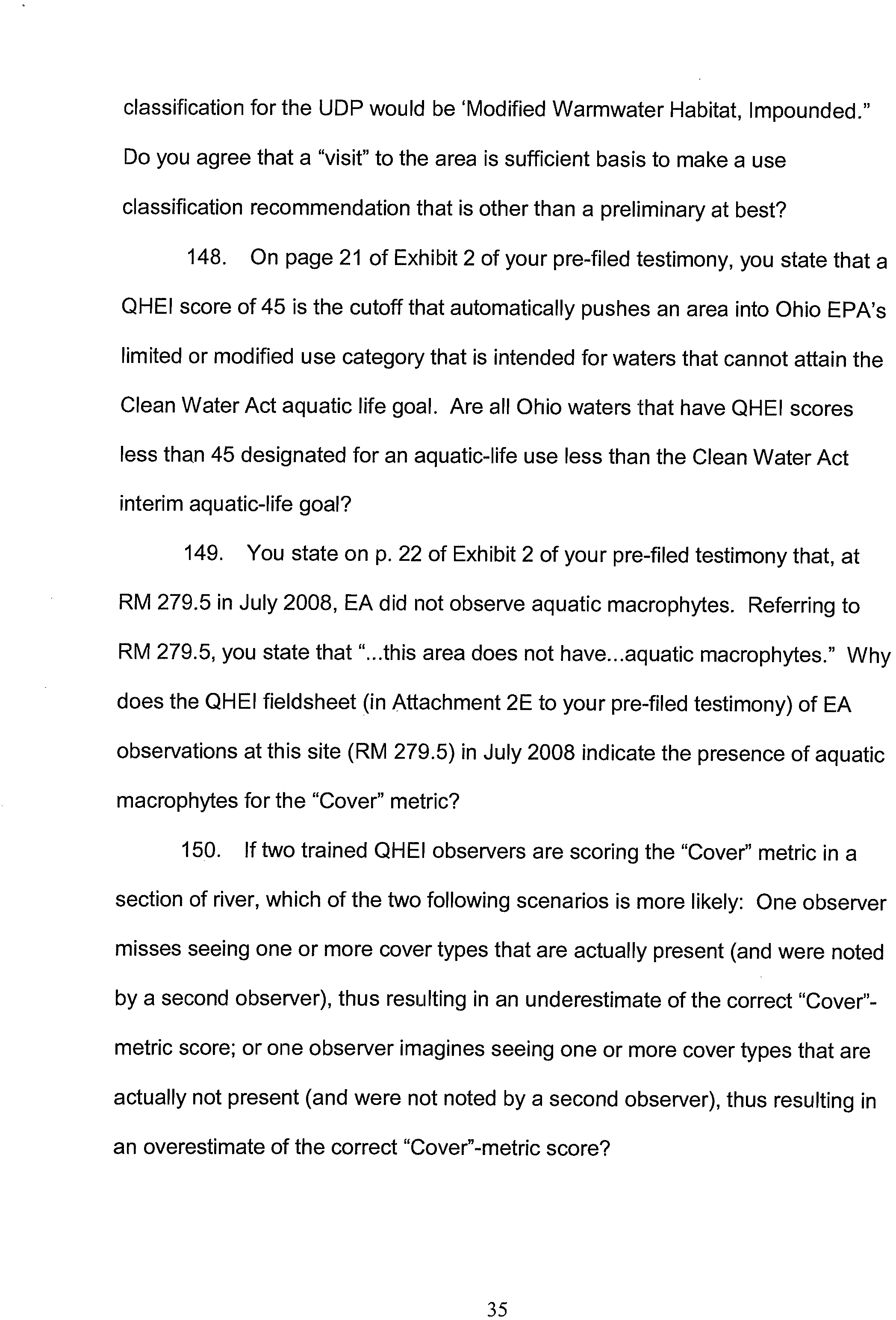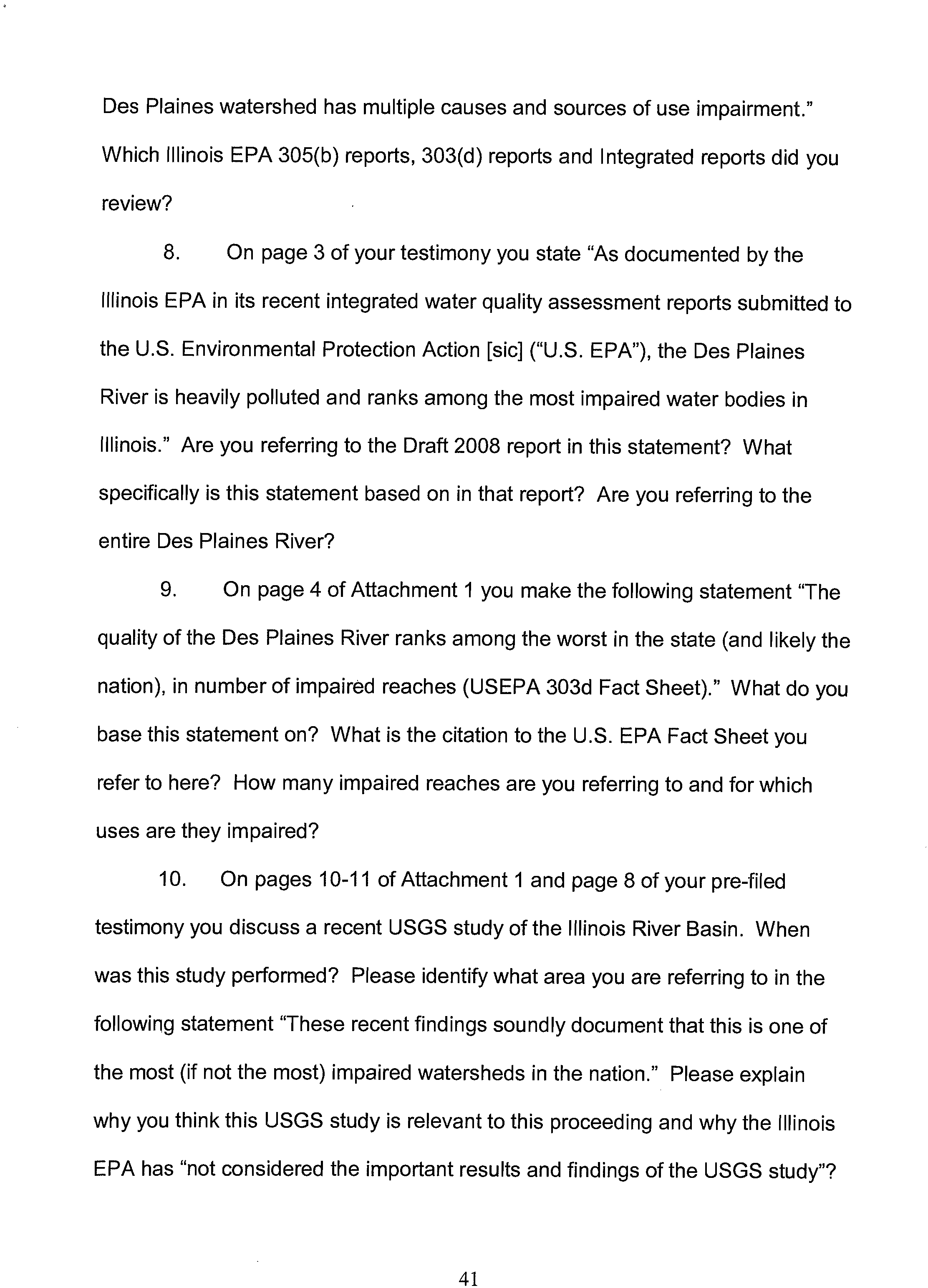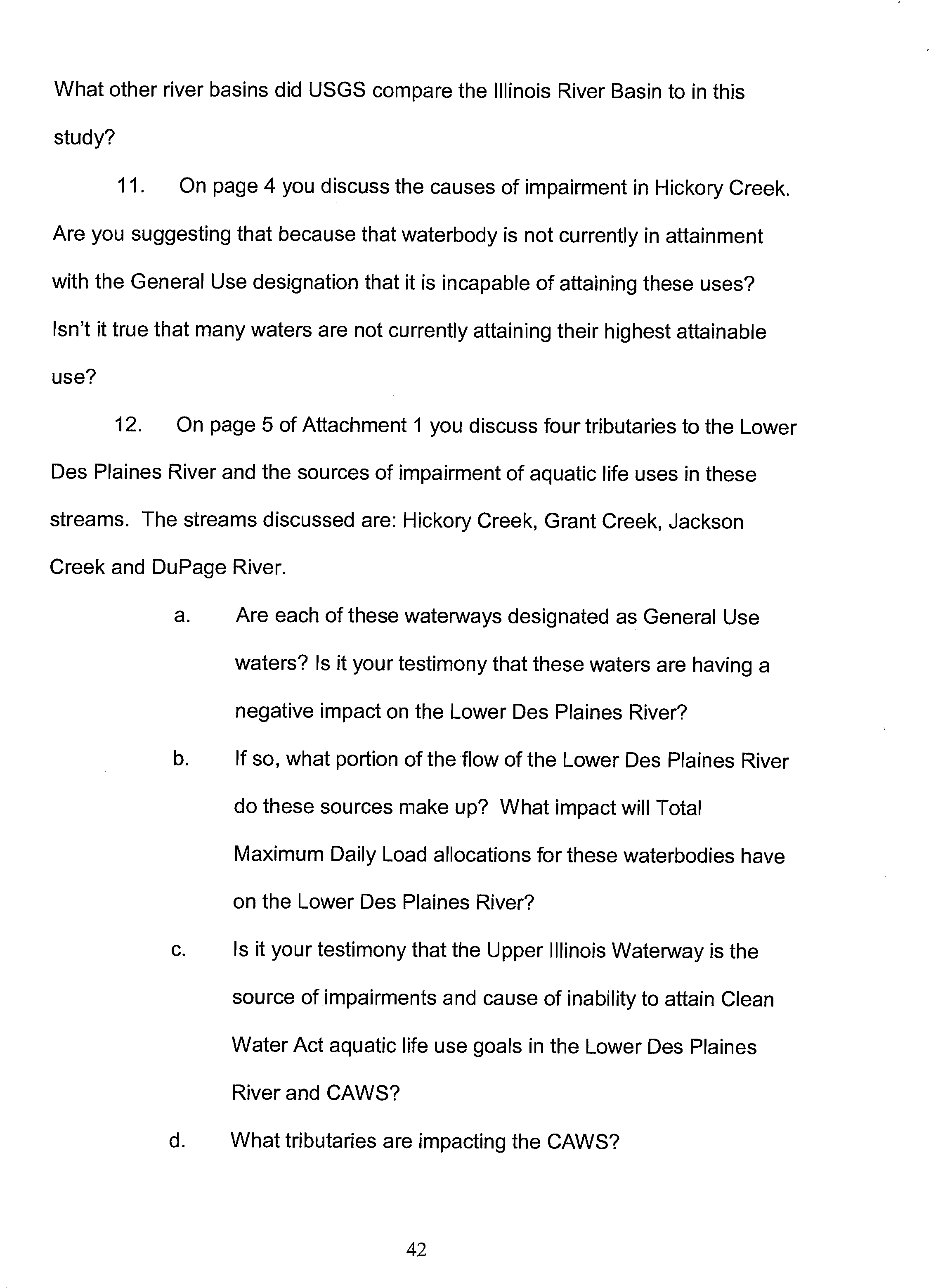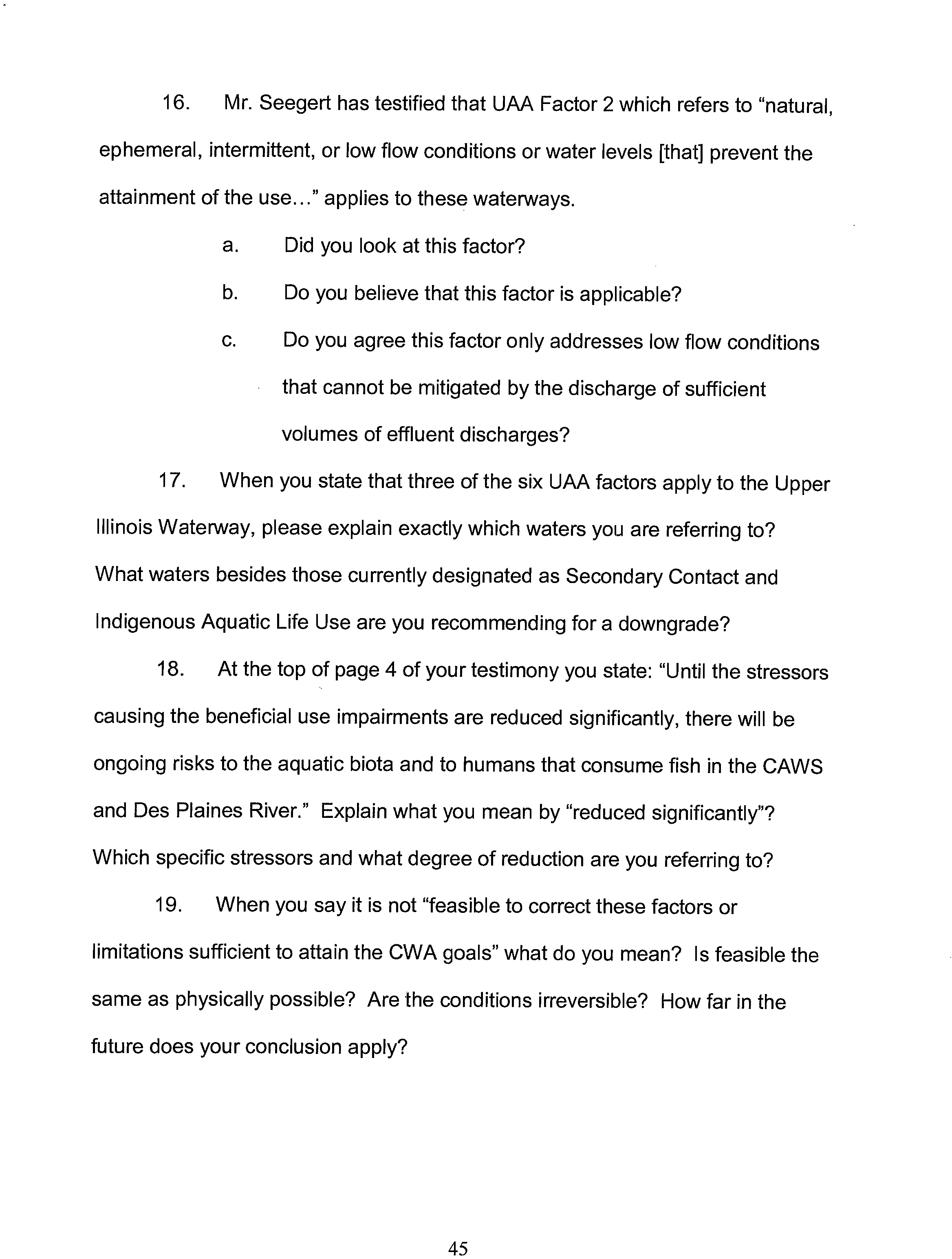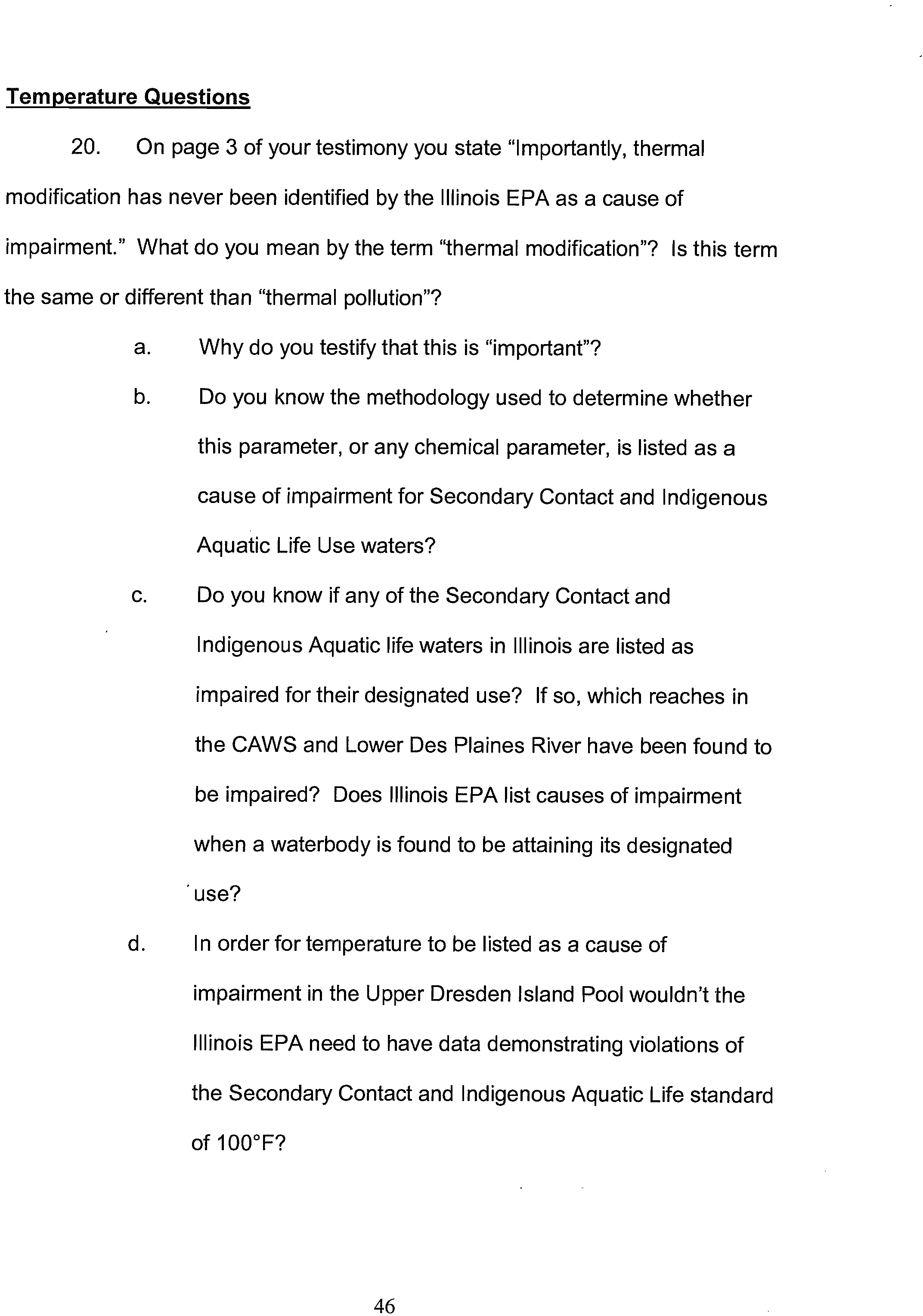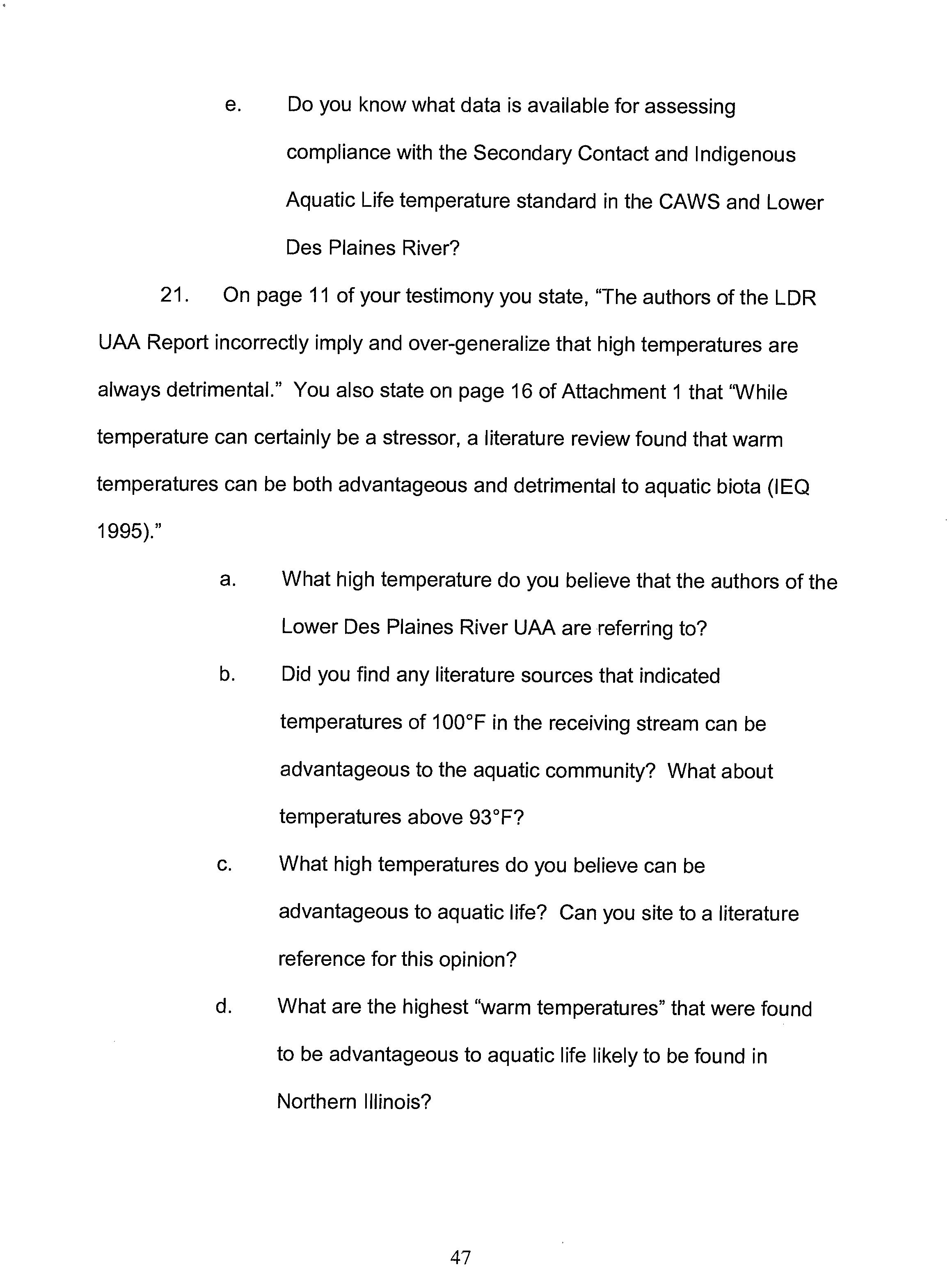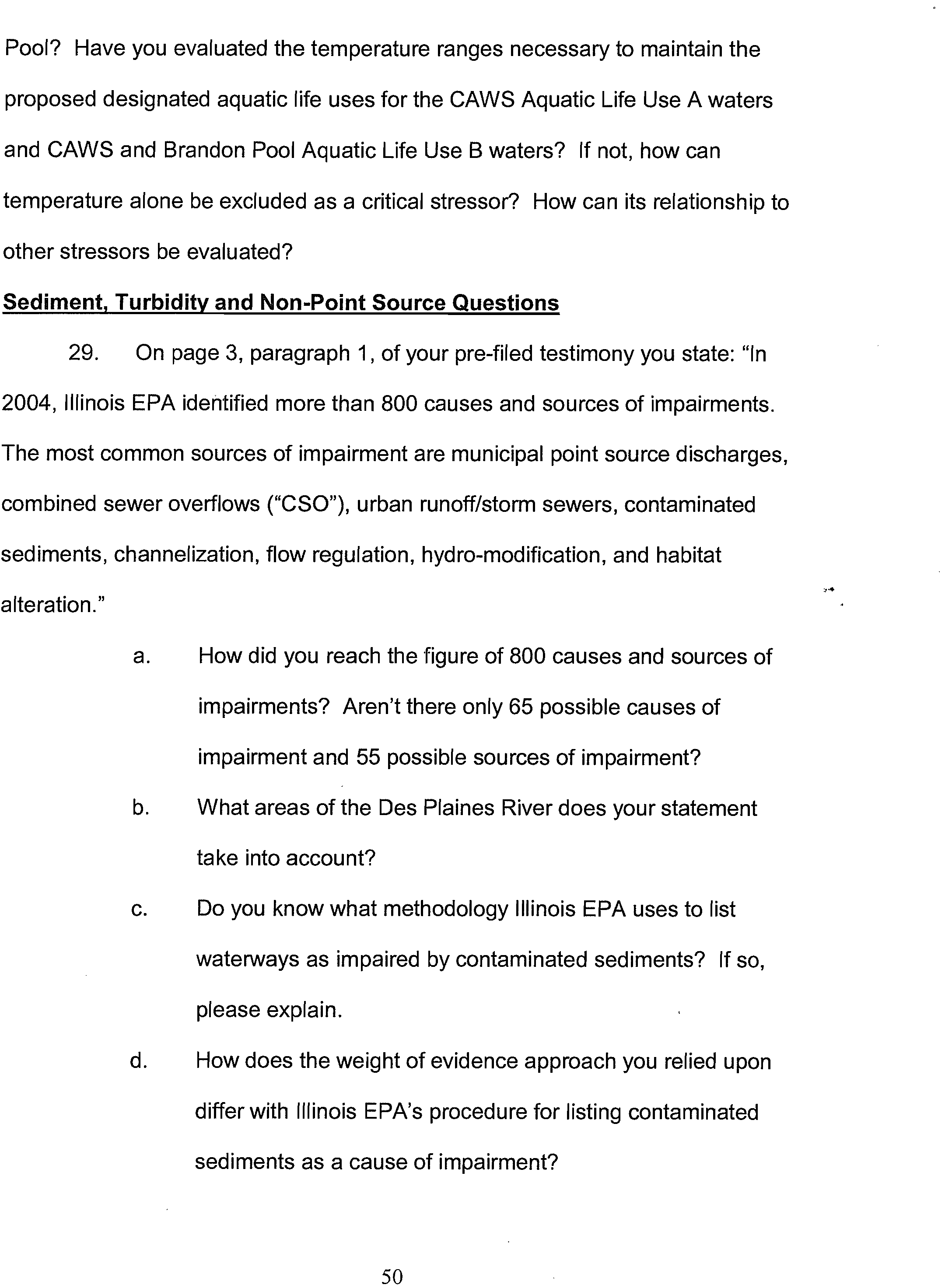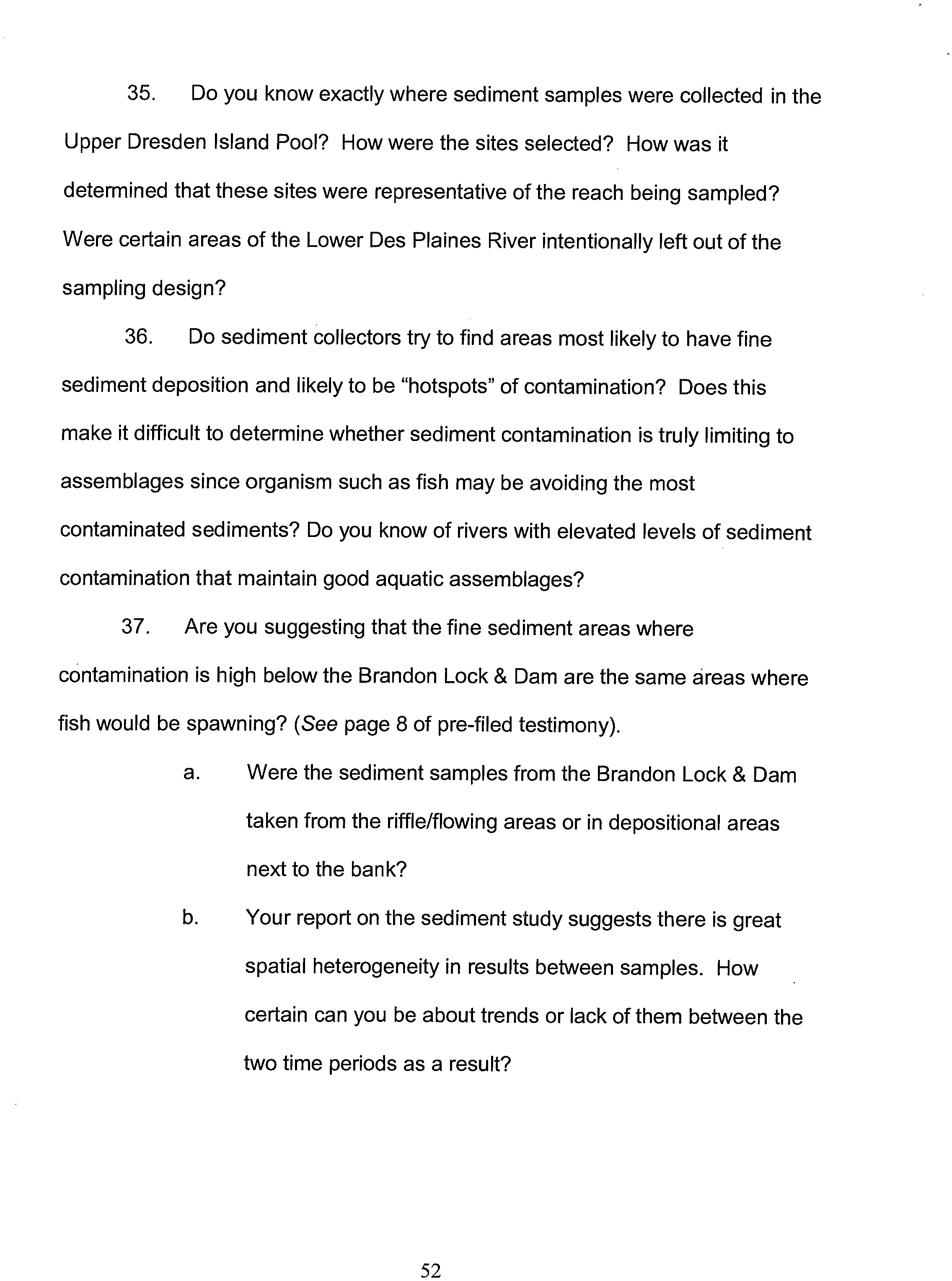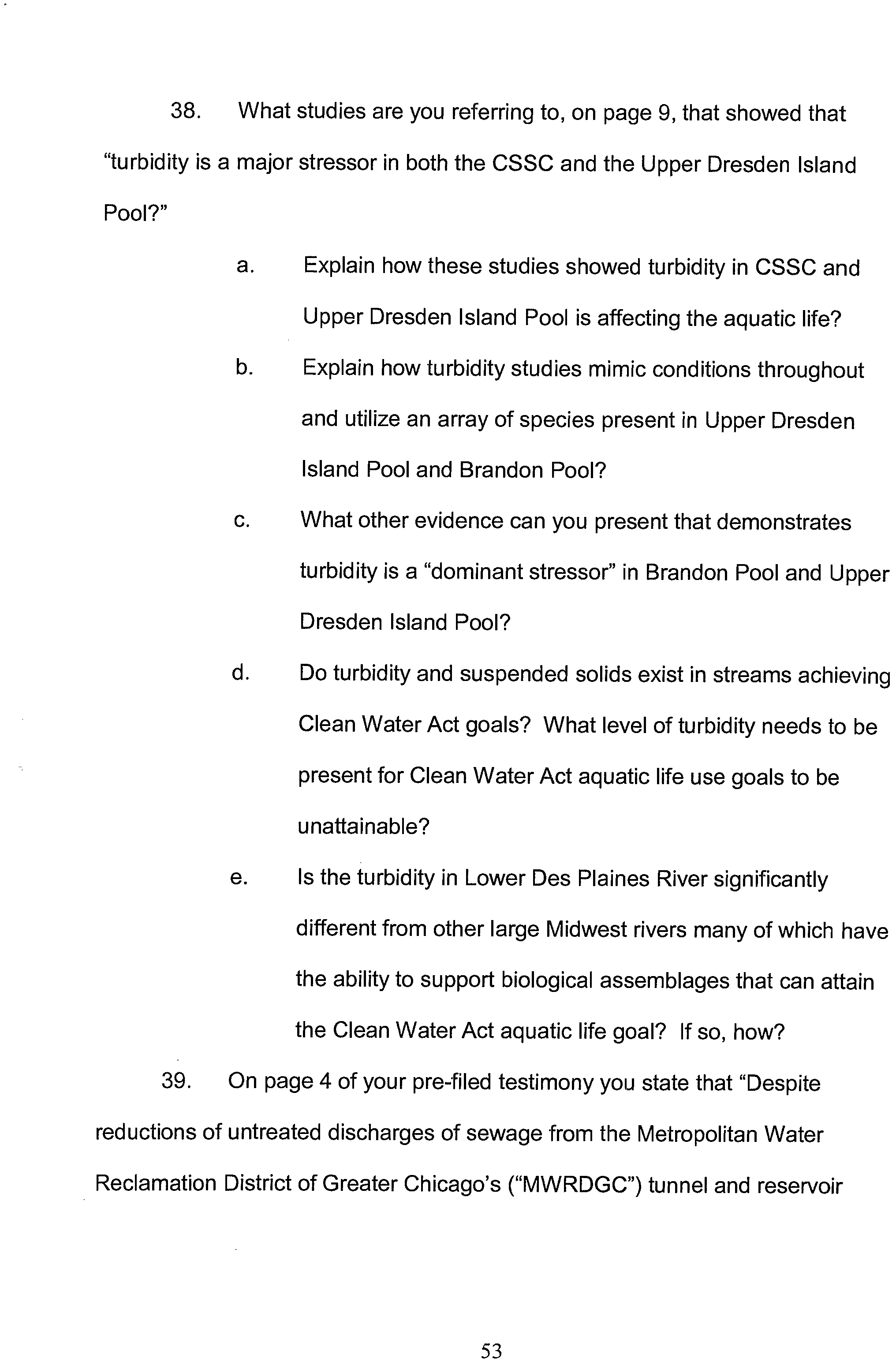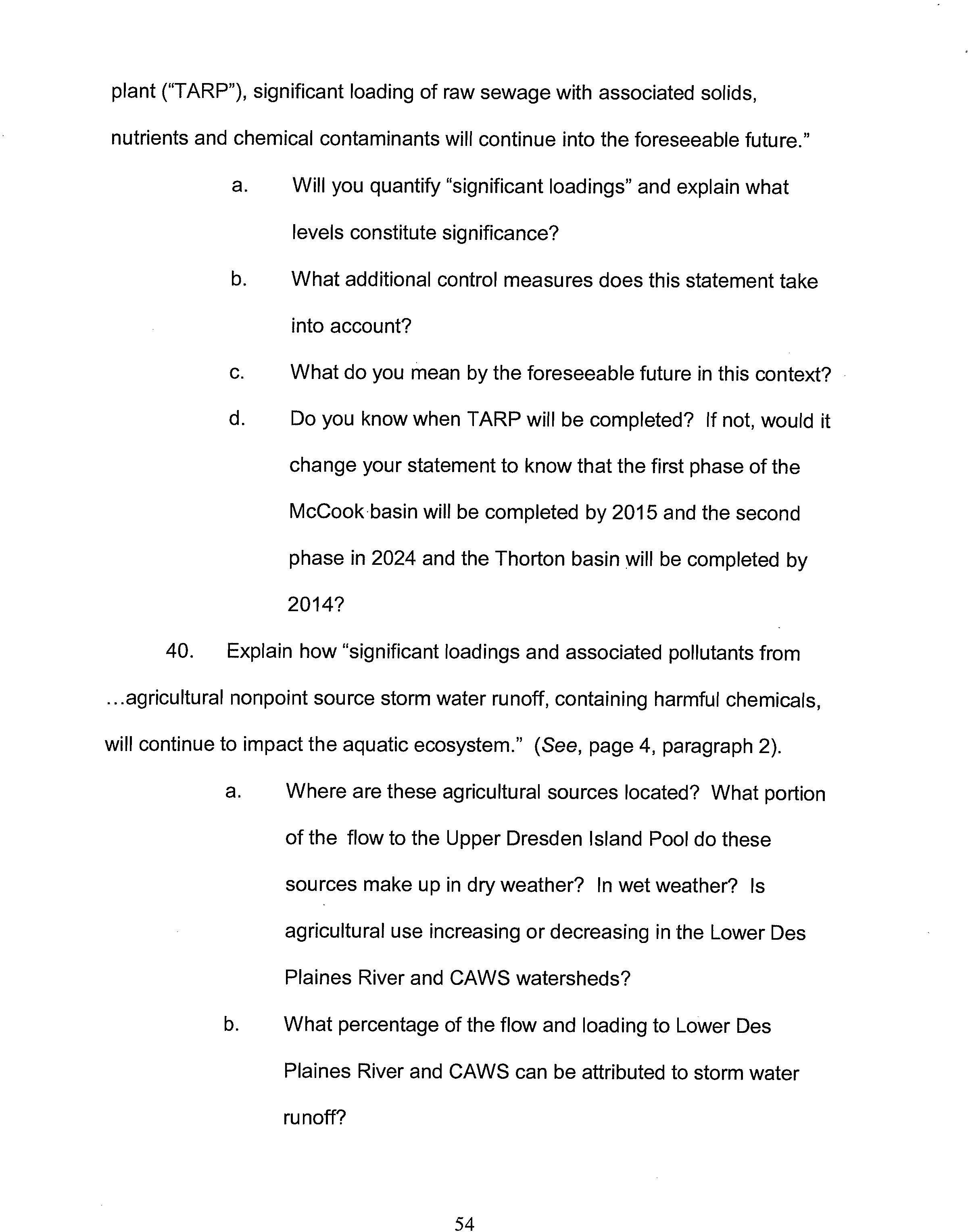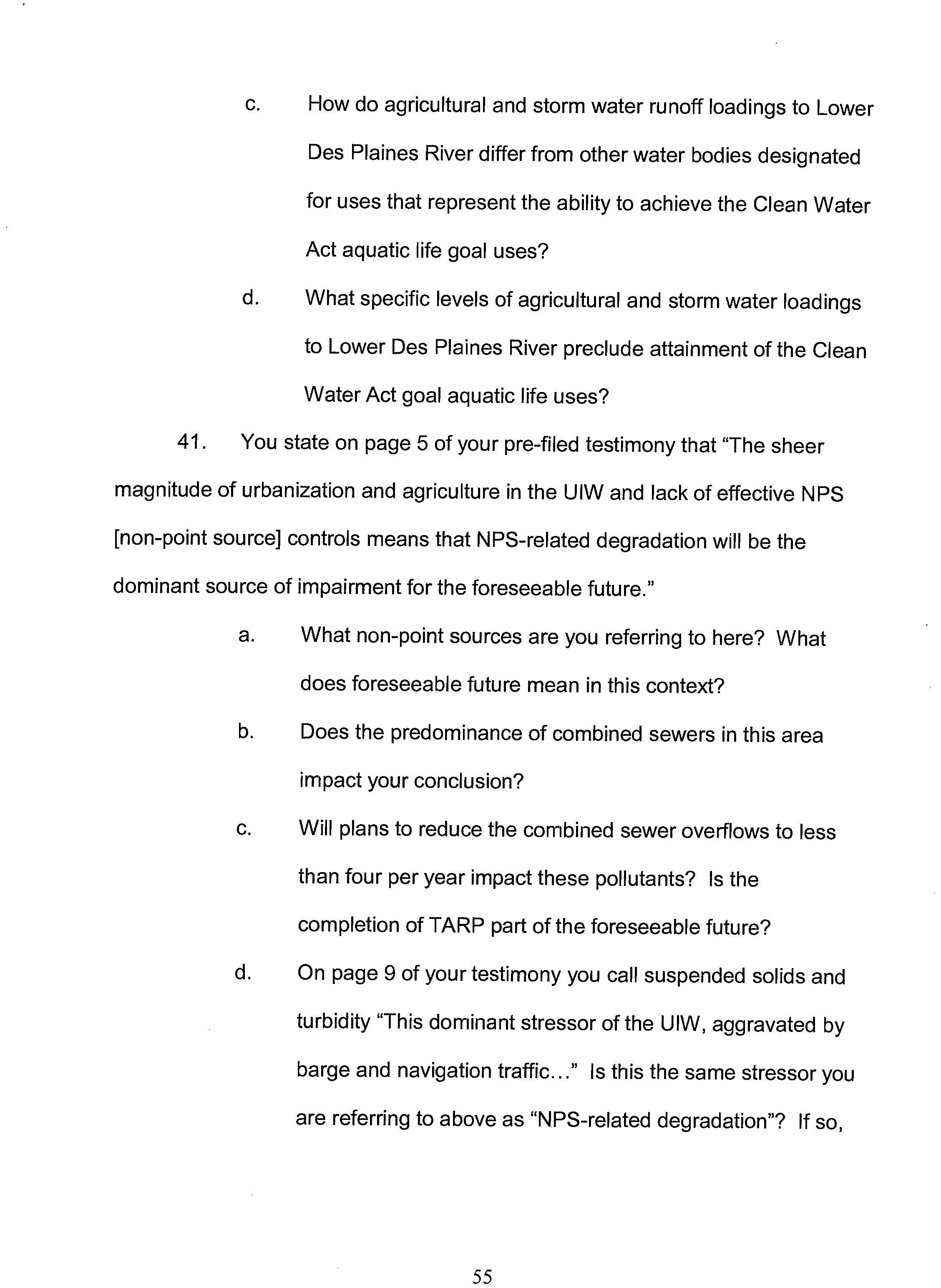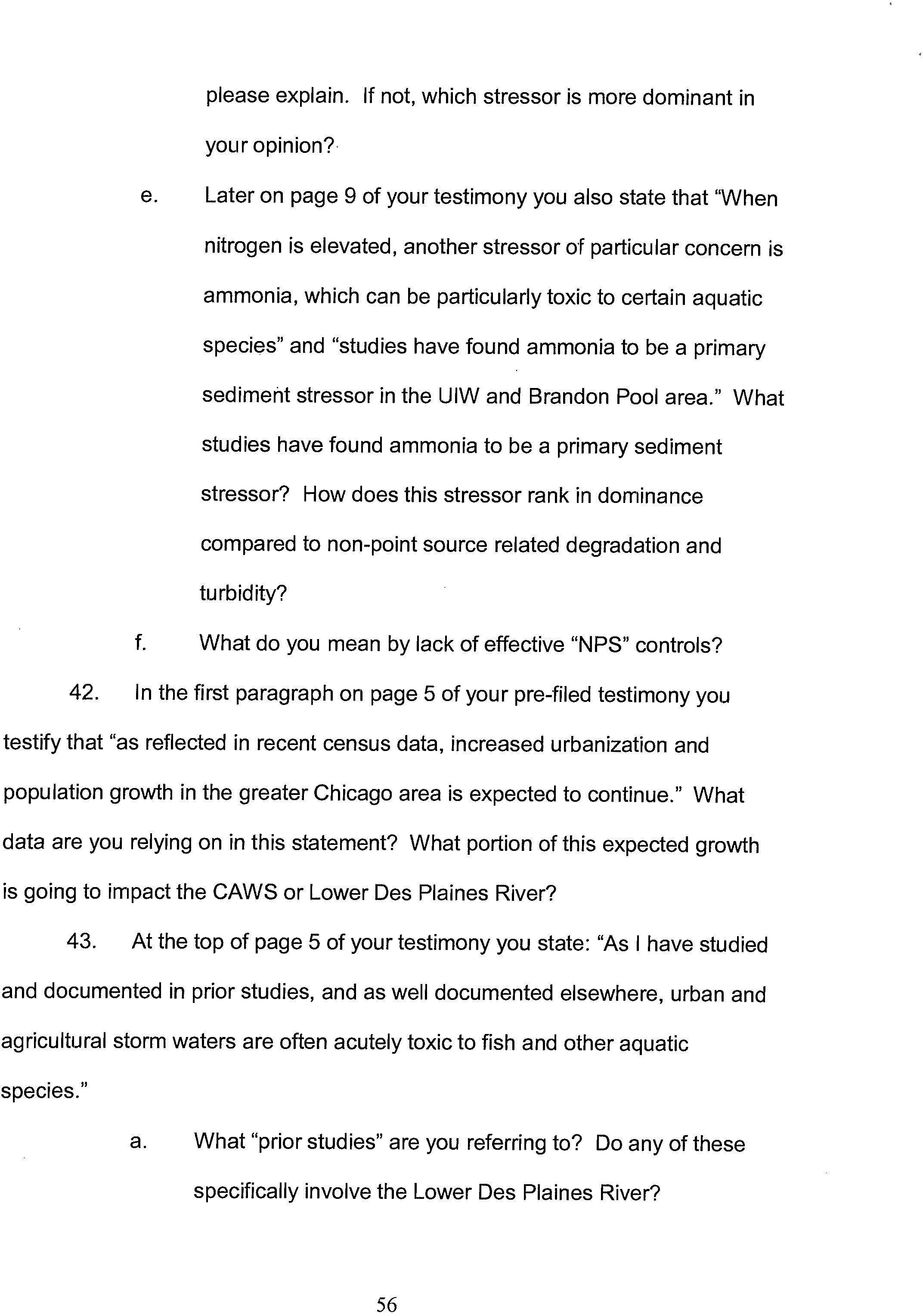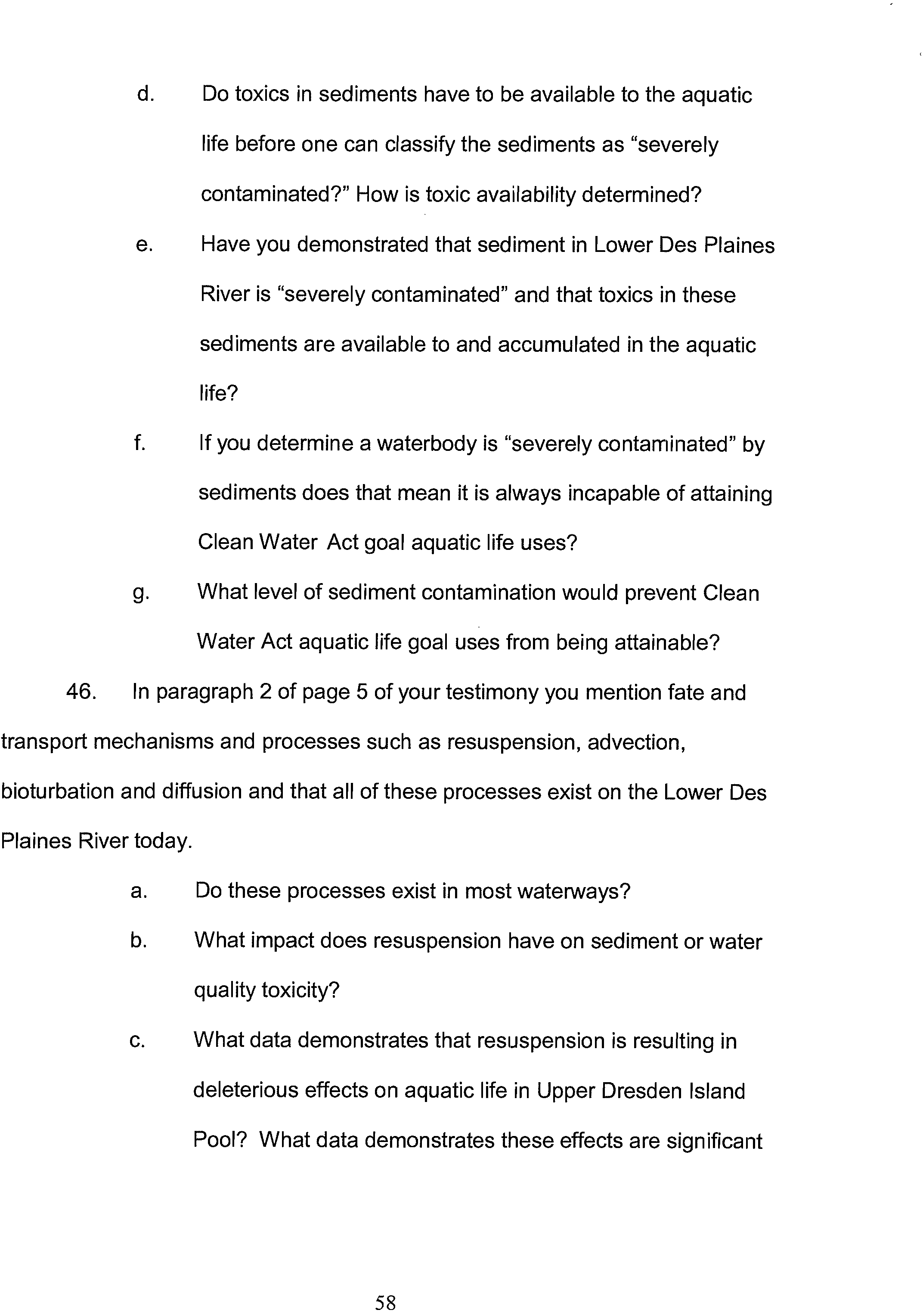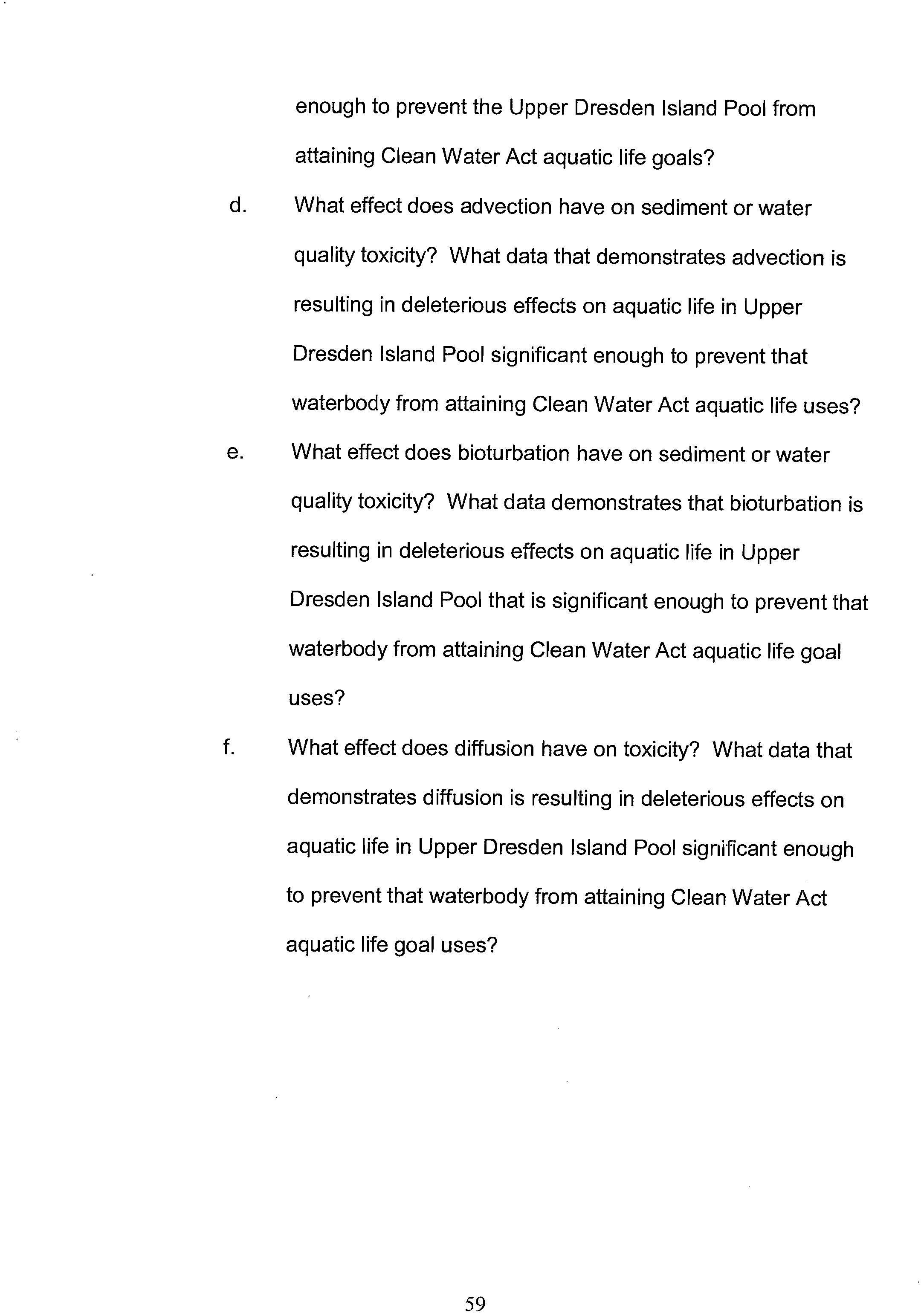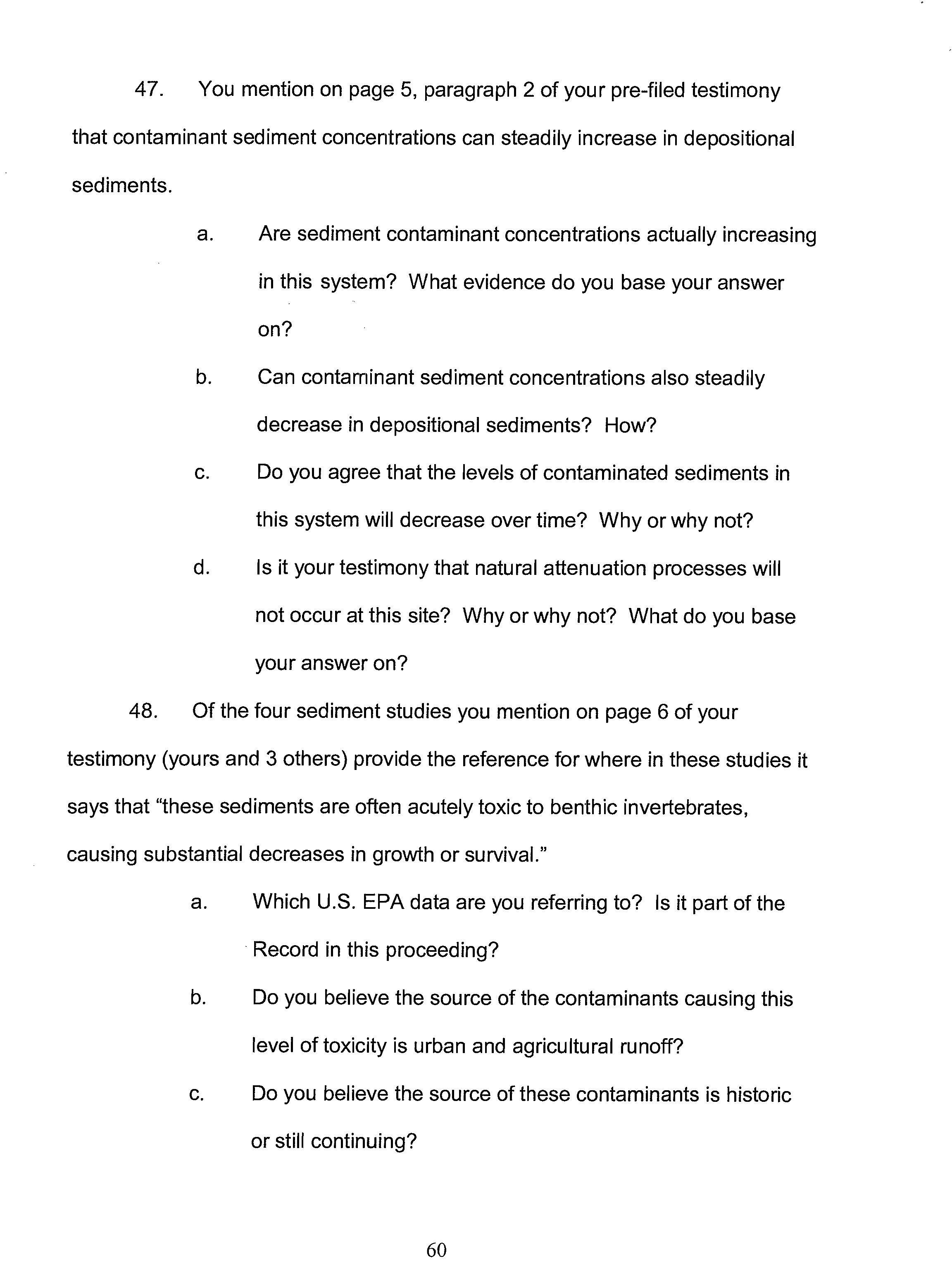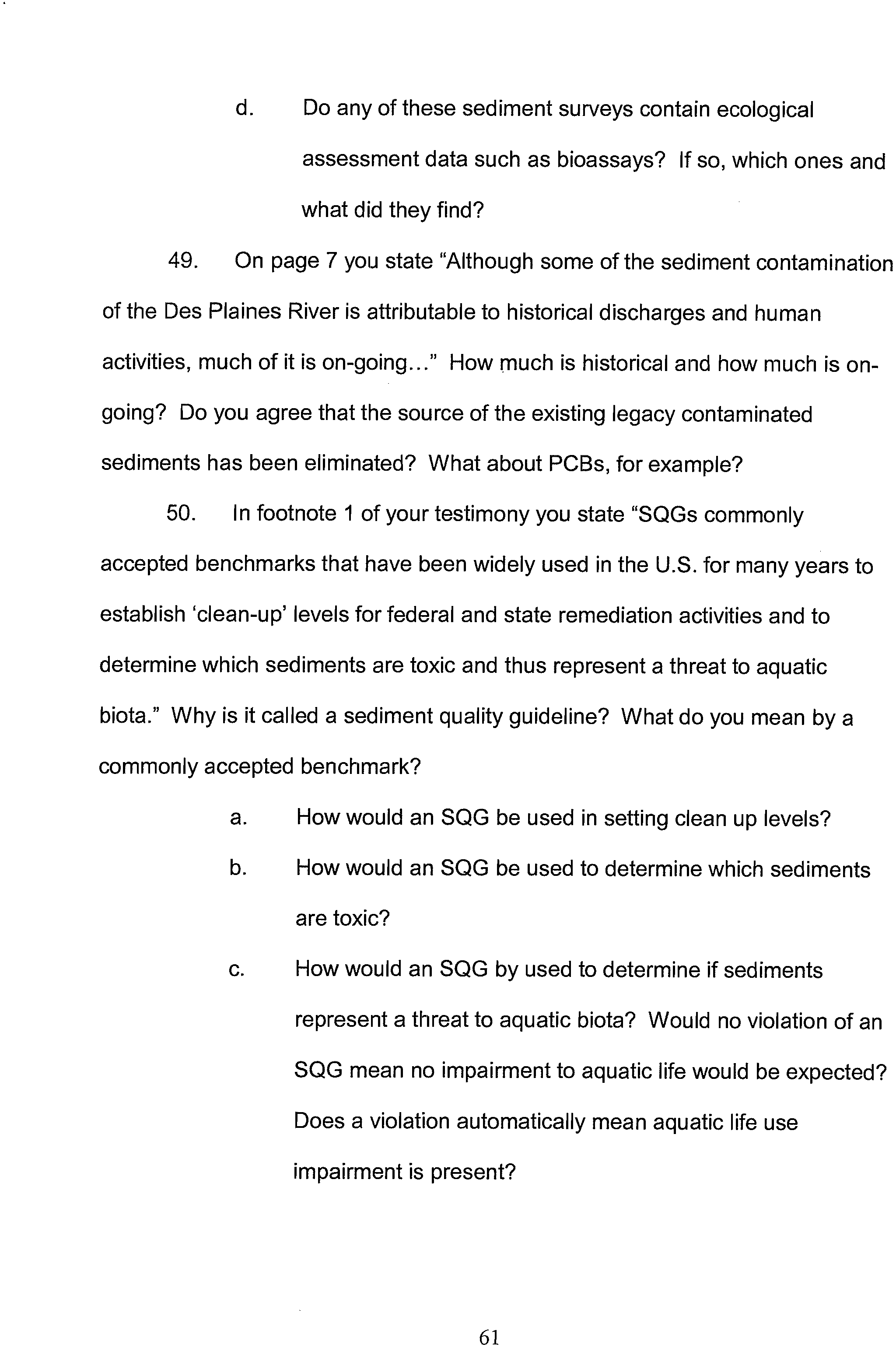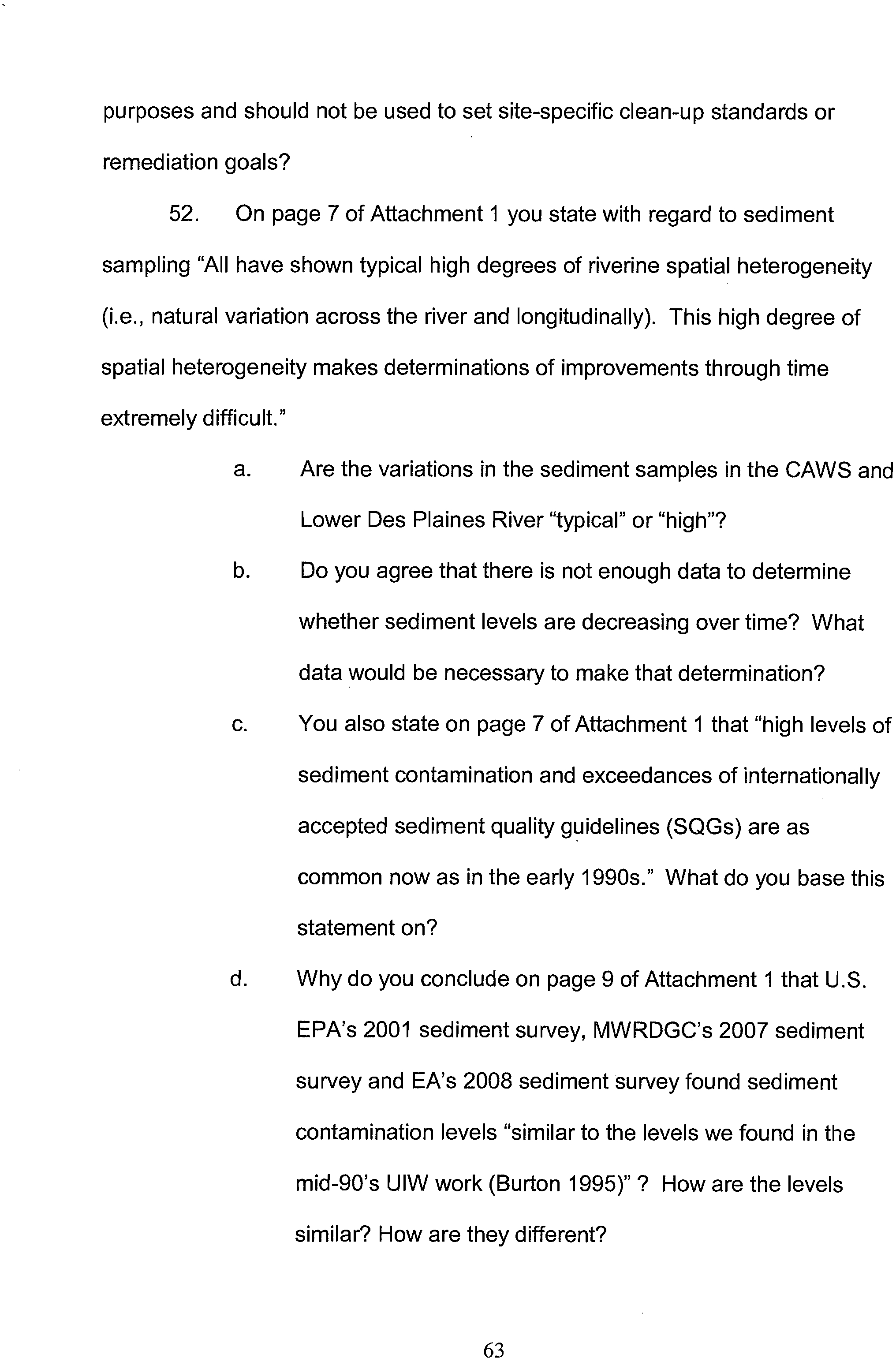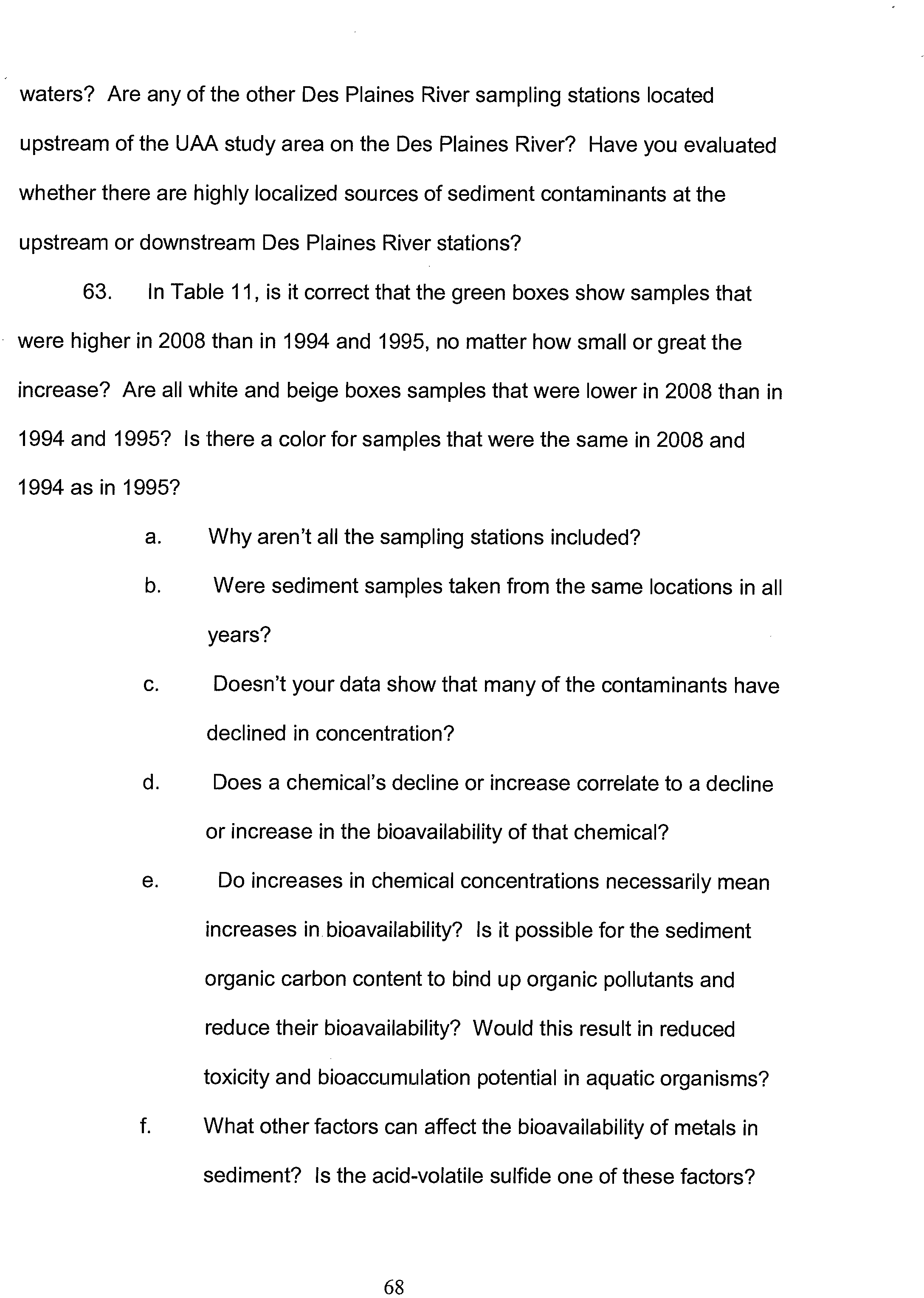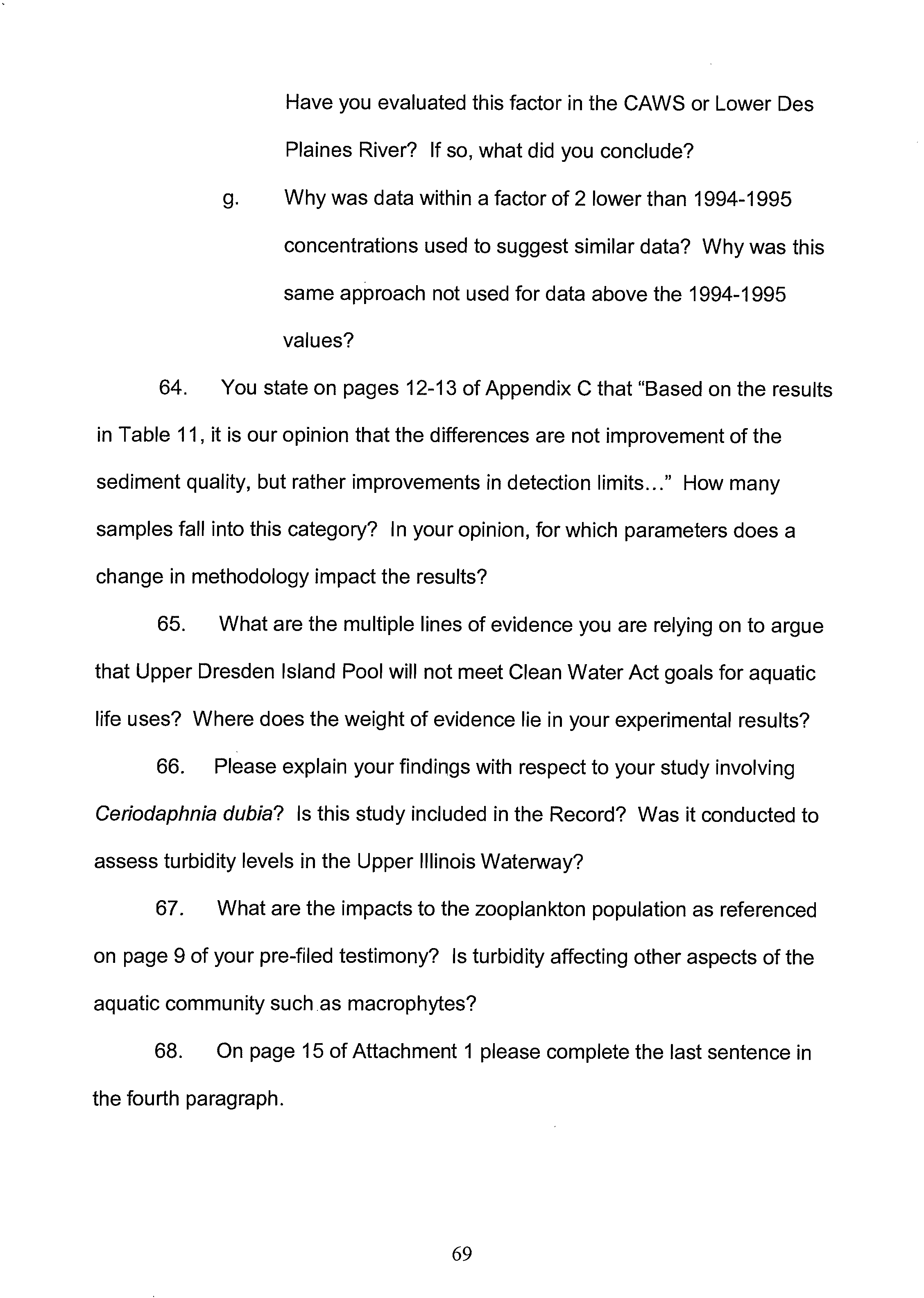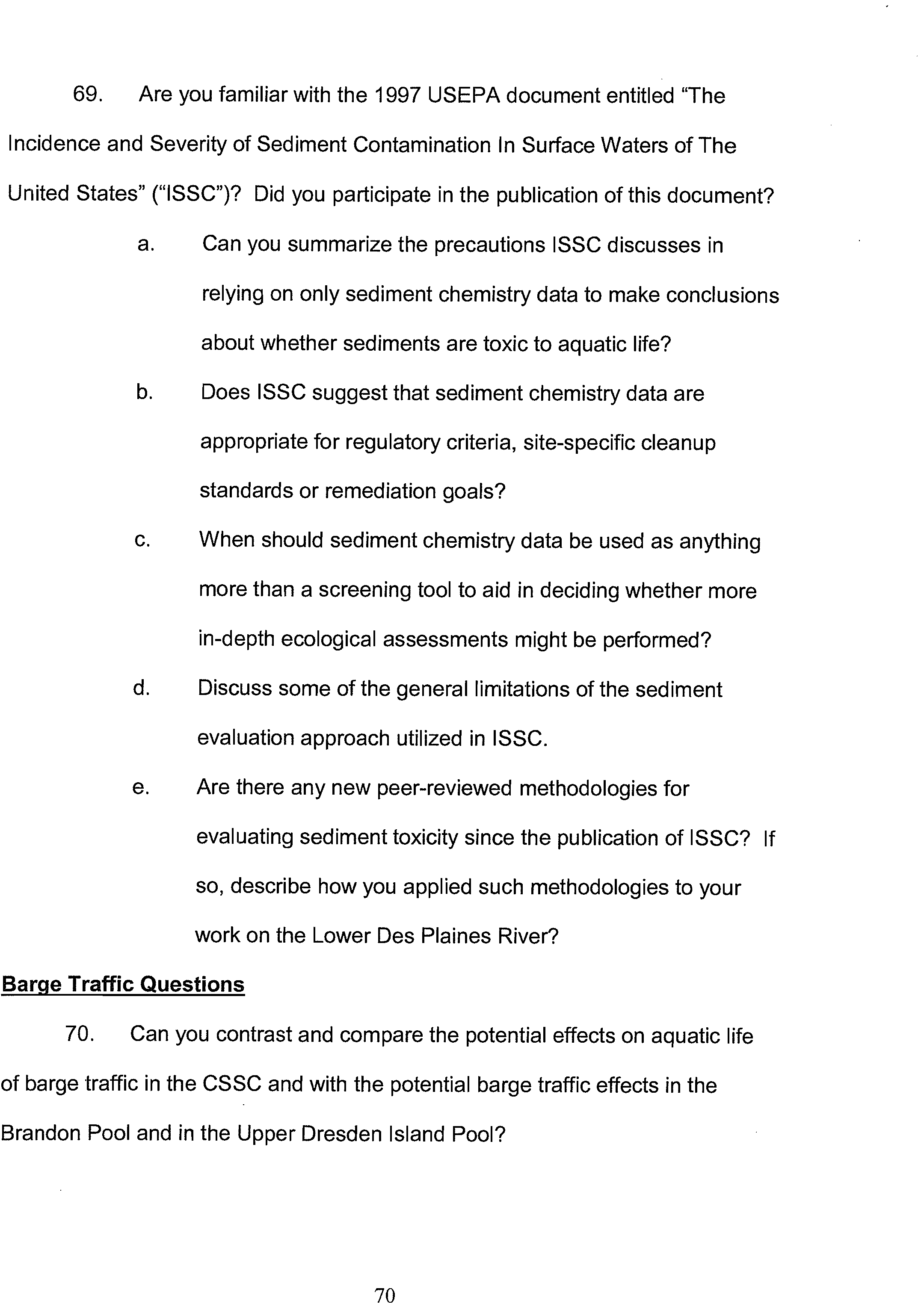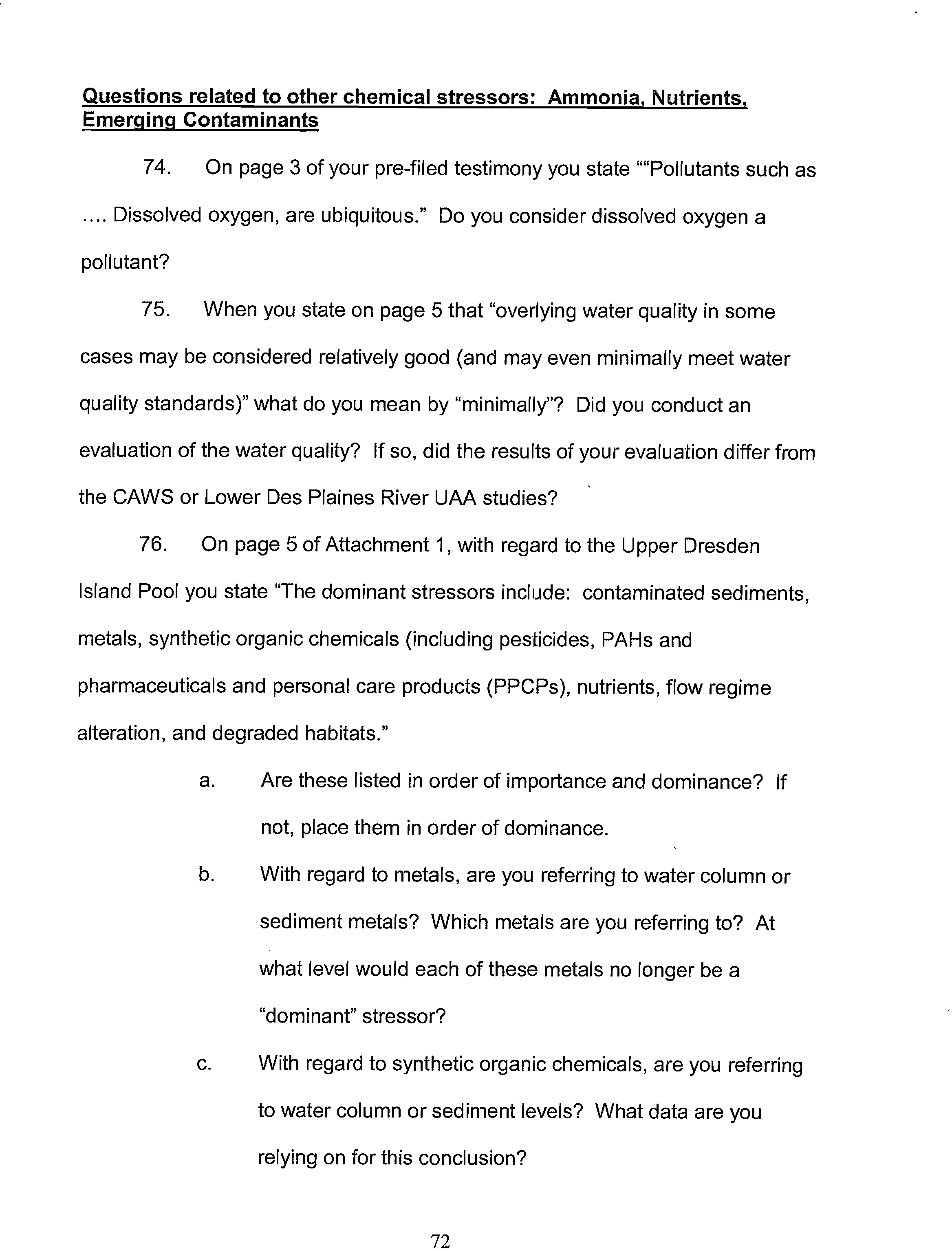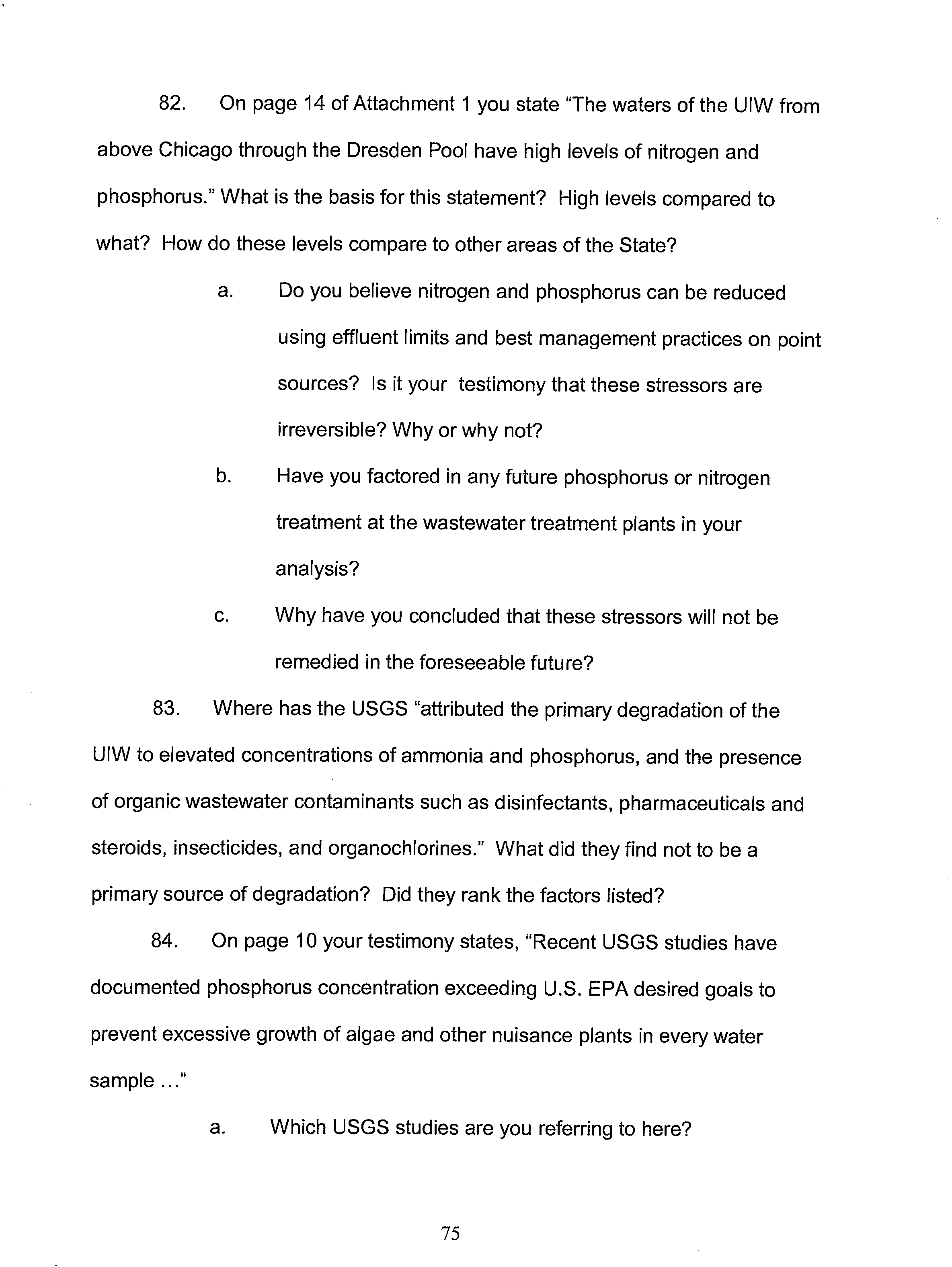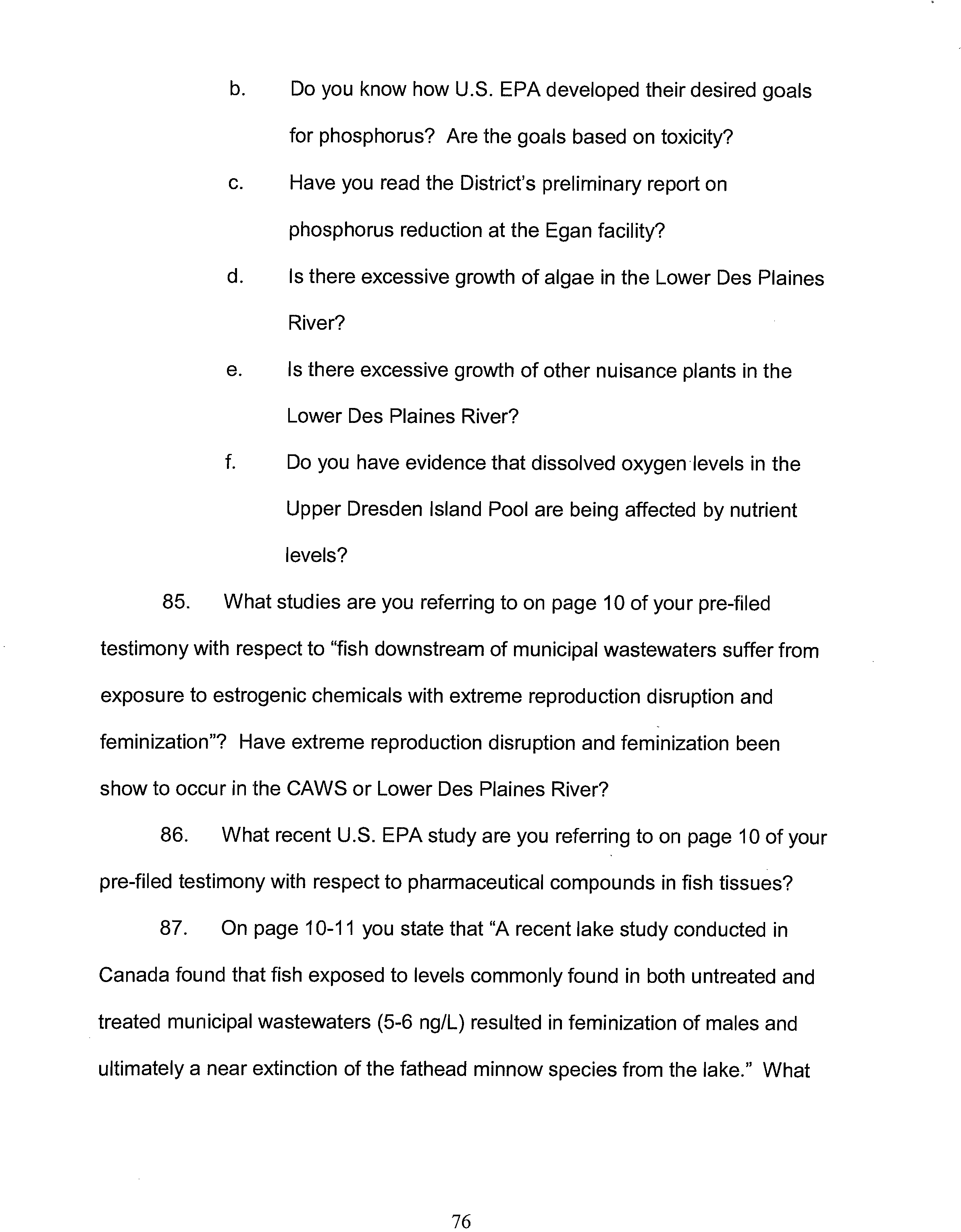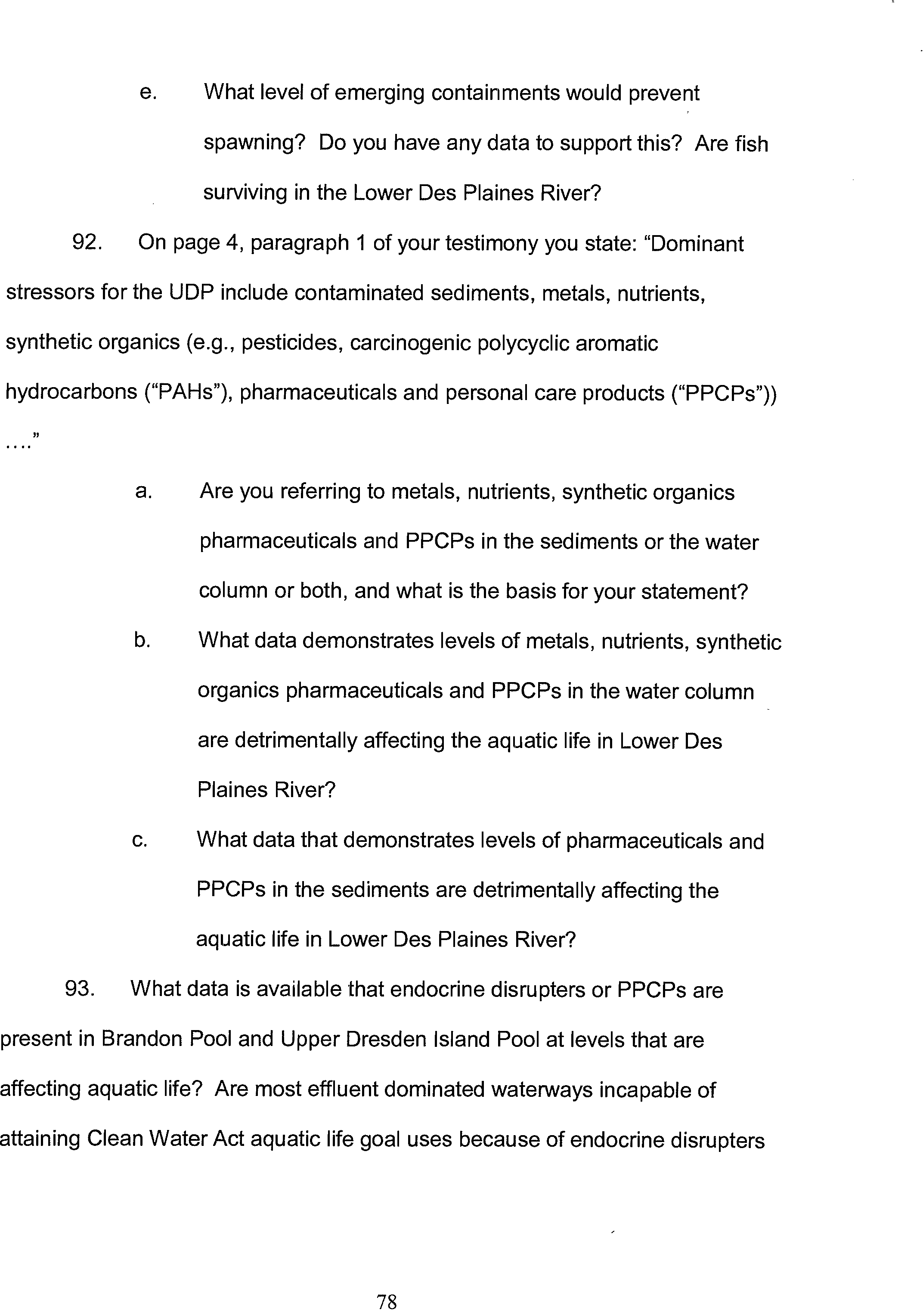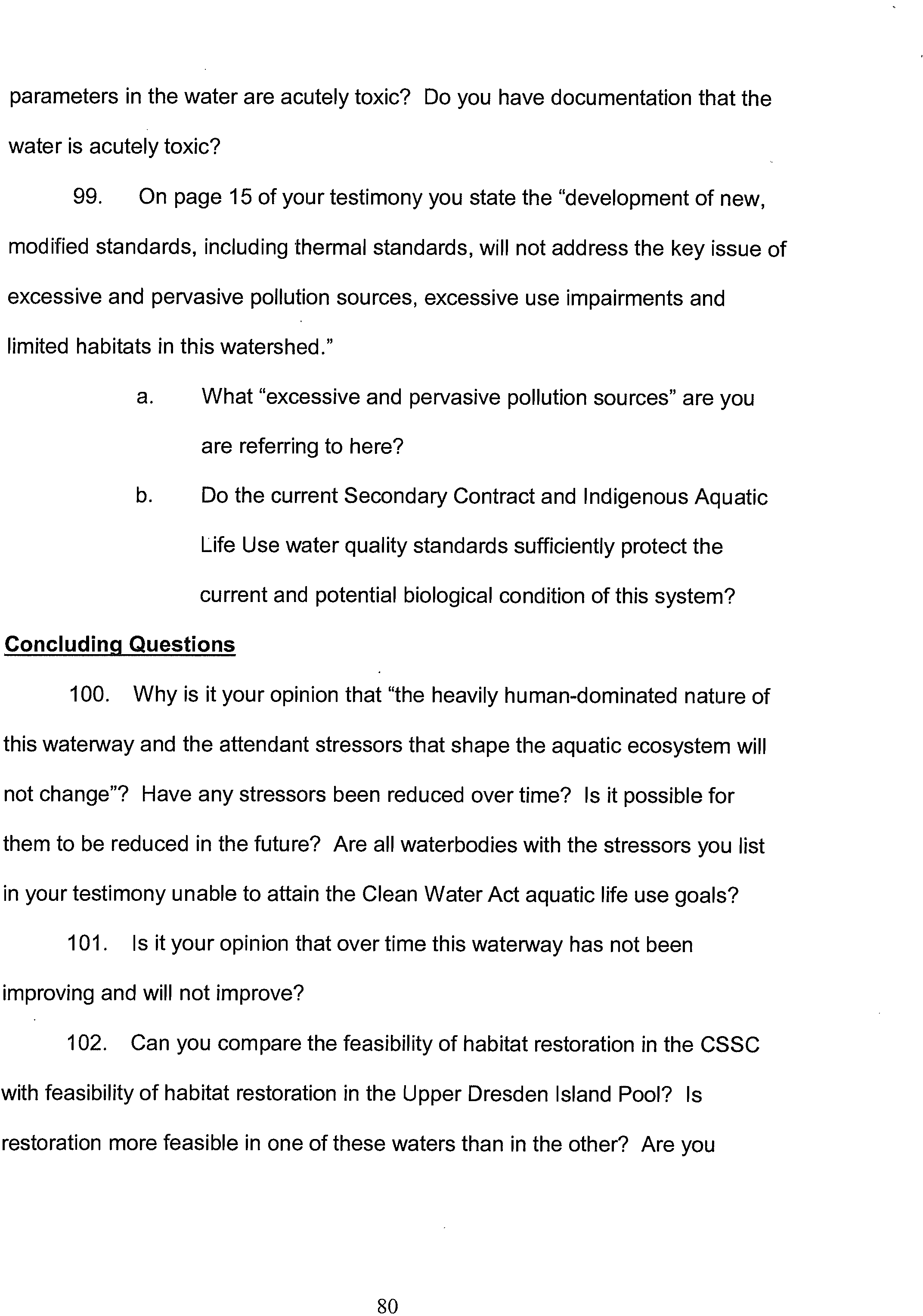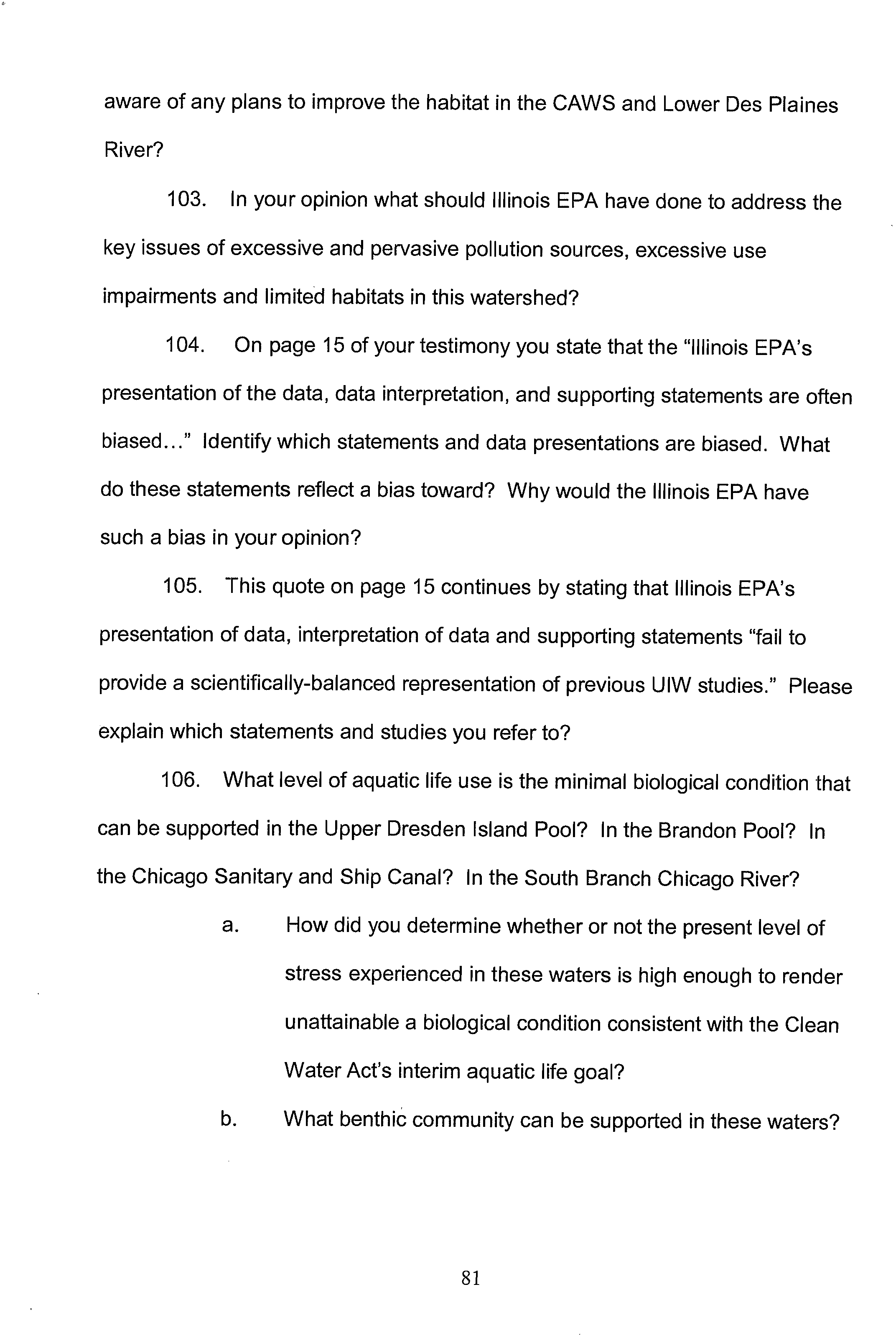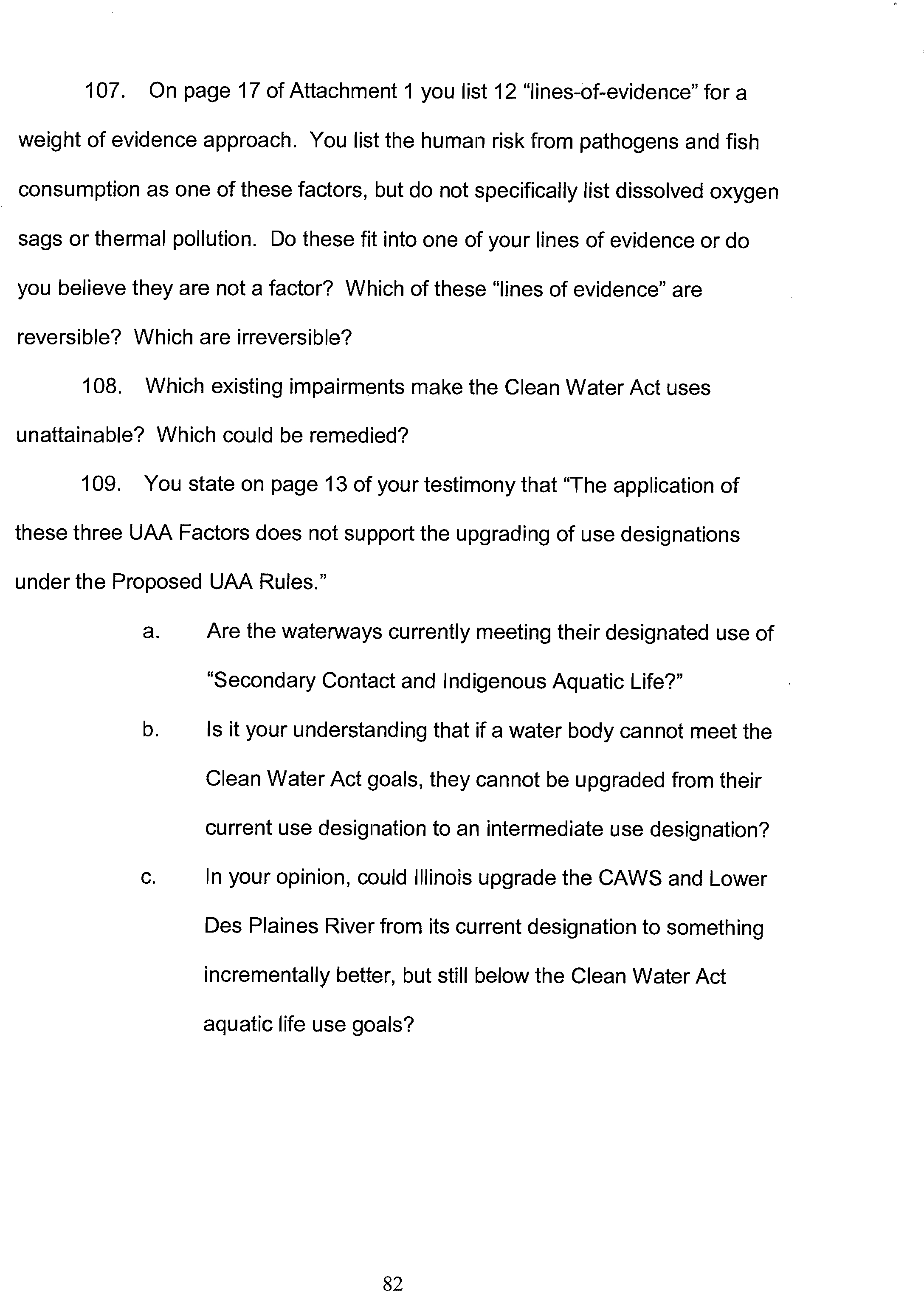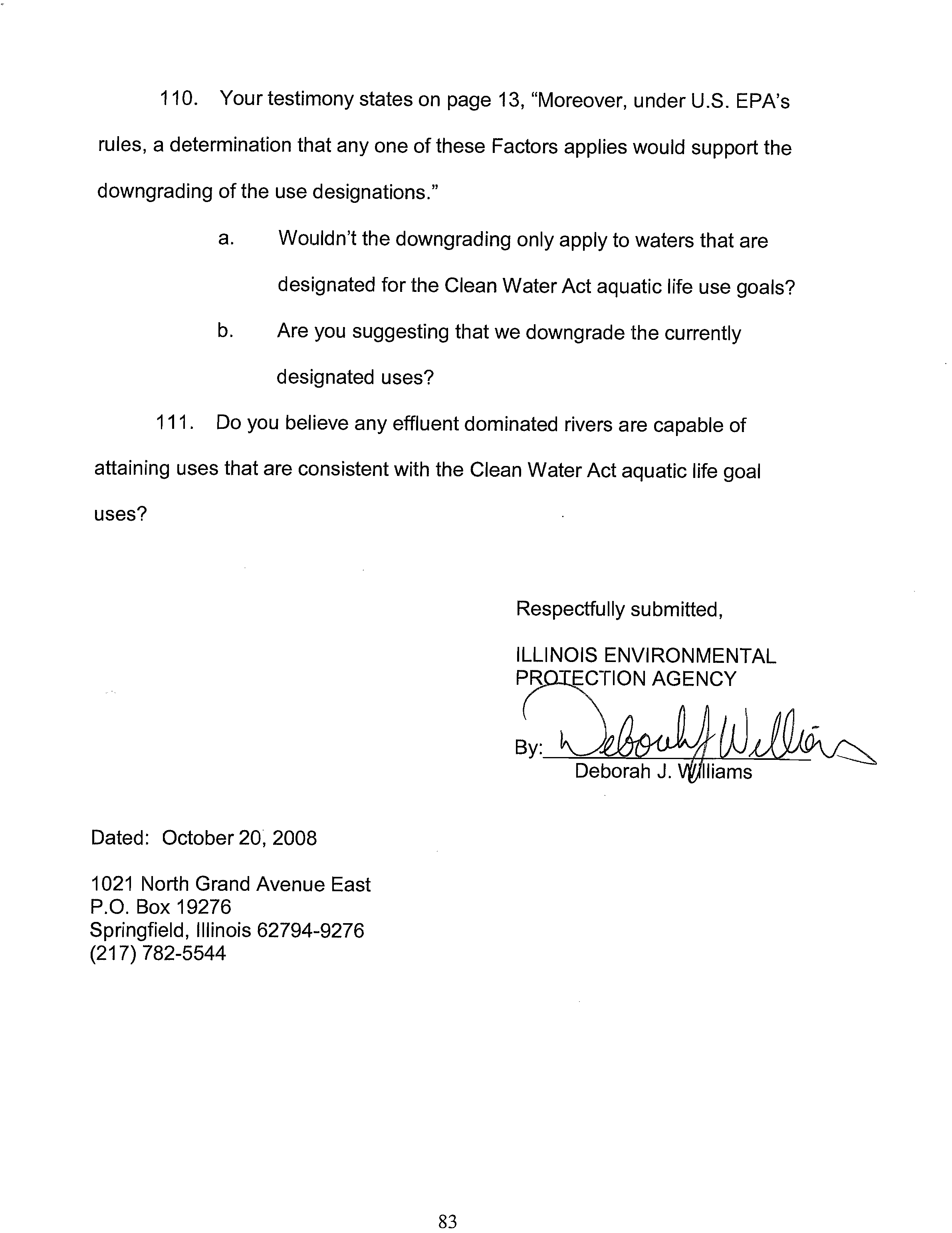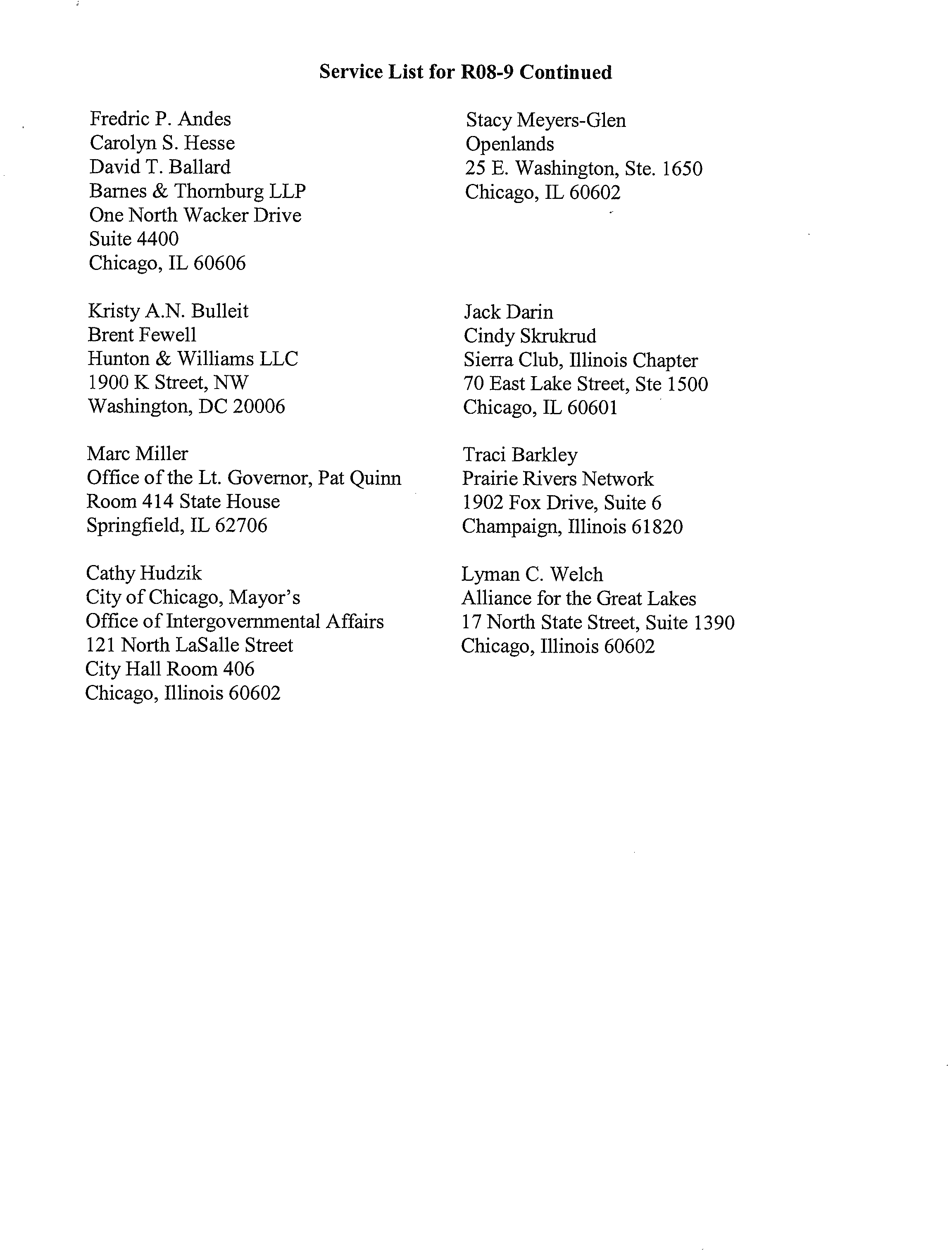BEFORE
THE
ILLINOIS
POLLUTION
CONTROL
BOARD
iN
THE
MATTER
OF:
)
)
WATER
QUALITY
STANDARDS
AND
)
EFFLUENT
LIMITATIONS
FOR
THE
)
R08-09
CHICAGO
AREA
WATERWAY
SYSTEM
)
(Rulemaking
-
Water)
AND THE
LOWER
DES
PLAINES
RIVER:
)
PROPOSED
AMENDMENTS
TO
35111.
)
Adm.
Code
Parts
301,
302,
303
and
304
)
NOTICE
OF
FILING
To:
John
Therriault,
Clerk
CLERK
1)
Marie
Tipsord,
Hearing
Officer
CE
James
R Thompson
Center
2
‘?jp
Illinois
Pollution
Control
Board
ST
100
West
Randolph
Street, Suite
11-500
Poiitdo
1LLINOIS
Chicago,
Illinois
60601
Oard
SEE
ATTACHED
SERVICE
LIST
PLEASE
TAKE
NOTICE that
I have
filed
today
with
the
Illinois
Pollution
Control Board
Illinois
EPA’s
Pre-Filed
Questions
for
Midwest
Generation
Witnesses,
a
copy
of
which
is
herewith
served
upon
you.
ILLINOIS
ENVIRONMENTAL
PROTECTION
AGENCY
BZiV44
Dated:
October
20,
2008
Deborah
J.
‘iJfliams
1021
North
Grand
Avenue
East
Assistant
Cou’fisel
P.O. Box
19276
Springfield,
Illinois
62794-9276
(217)
782-5544
THIS
FILING
IS
SUMBITTED
ON
RECYCLED
PAPER
BEFORE
THE
ILLINOIS
POLLUTION
CONTROL
BOARD
IN
THE MATTER
OF:
)
)
WATER
QUALITY
STANDARDS
AND
)
EFFLUENT
LIMITATIONS
FOR THE
)
R08-09
F
CHICAGO
AREA
WATERWAY
SYSTEM
)
(Rulemaki4
AND
THE
LOWER
DES
PLAINES
RIVER:
)
PROPOSEDAMENDMENTSTO35III
)
OC
Adm.
Code Parts
301,
302,
303
and
304
)
STATE
OFIL.LIN
POIILJtjofl
Contr
ILLINOIS
EPA’S
PRE-FILED
QUESTIONS
FOR
MIDWEST
GENERAT
ar
WITNESSES
The
Illinois Environmental
Protection
Agency
(“Illinois
EPA”
or
“Agency”),
by
and
through
its
attorneys,
herby
submits
its
pre-filed
questions
for
Midwest
Generation
Witnesses
in
the
above-captioned
maffer.
The
Agency
reserves
the
right
to
ask
additional
follow-up
as
necessary.
Questions
for Julia
Wozniak
1.
In
your
pre-filed
testimony
you
state
that
part
of
the
responsibilities
of
your
position
at
Midwest
Generation
include
“modeling
the
complex
thermo
hydrodynamics
of
power
plant
and
waterway
interactions”
and
“overseeing
thermal
compliance
monitoring
and
developing
and
running
complex
models
that
are
used
to
optimize
station
loads
during
critical
generation
periods,
while
maintaining environmental
compliance.”
Please
explain
your role
in
these
activities.
What training
have
you
received
related
to
modeling
of
thermo
hydrodynamics?
2.
You
refer
to
the
Joliet
Stations
on
the
study
area
as
Joliet
6 and
Joliet 7
&
8.
Please
explain
the
numbering
system
for
the
Joliet
facilities.
1
3.
Which reaches
of the
CAWS
do
the Fisk,
Crawford
and
Will
County
stations
discharge
to?
Which
reaches
do
they
impact?
4.
Please
identify
the
other
2
Midwest
Generation
generating
stations
in
Illinois.
What
type
of cooling
is utilized
at these
2 stations
and
the
Western
Pennsylvania
station?
5.
Why
were
cooling
towers
installed
in 1999
at the
Joliet
7 &
8
facilities?
6.
Explain
how
“The
towers
are
also
used
to
meet
near-field
thermal
standards
during
critical
low
flow
periods
that
occur
in the
Dresden
Pool.
(See
pages
4-5).
What
happens
at
the
other
facilities
during
these
periods?
7.
Who
developed
the
thermal
models
used?
What
are
the
inputs
of
the
model
and
what
data
are
they
obtained
from?
How
are
the
results
of
these
models
tested
against
real
world
conditions?
8.
Where
is
the
26
acre
mixing
zone
applicable
to the
Midwest
Generation’s
CAWS
and
Lower
Des
Plaines
River
facilities
found?
How
is
compliance with
the
Secondary Contact
temperature
limits
measured?
9.
Page
4,
paragraph
2,
of
your
pre-filed
testimony
states,
“Unit
6
The
design
maximum
temperature
rise
in the
circulating
water
is
approximately
10.7°F
...
Units
7&8
... The
design maximum
temperature
rise
in the
circulating
cooling
water
is
approximately
12.4°F.”
Does
this
take
into
account
the
cooling
towers?
Why
are
these
numbers
different
from
the
Board
opinion
AS
96-10,
page
3,
last paragraph, which
states
“The
station
has
two
thermal
discharges
to
2
the
Des
Plaines
River;
...
The
maximum
design
temperature
rise
in
the
circulating
cooling
water
is
approximately
9.4°F.”?
10.
Page
4, paragraph
3
of
your
pre-filed
testimony
you
state,
“The
cooling
towers
for
Units
7&8
were
voluntarily
installed
in
1999
at
a
cost
of
approximates
$23,000,000...”
In
the
AS96-10,
Corn
Ed
determined
the
cost
of
cooling towers
to be
$68
million.
Why
the
discrepancy
in
the
cost?
Why
the
change
of
position
in installing
cooling towers
after
you
told
the
Board
it
was
not
economical?
11.
AS
96-10,
March
16,
2000,
page
4,
last
paragraph
states,
“Based upon
the
assurances
of
CornEd
and
Midwest
that
the
management
and
operation
of
the
Generating
Stations
will
continue
unchanged...”
Did
deregulation
change the
operation
of
the
Generating
Station?
12.
You
state
on
page
6 of
your
pre-filed
testimony
“In
1996,
IEPA
did
not
view
the
thermal
discharges
as
limiting
aquatic
diversity
in
the
receiving
waters.” Which
receiving
waters
are
you
referring
to
in this
statement?
13.
You
also
state
on
page
6 of
your
pre-filed
testimony
“the
Agency
ultimately
concluded
as
part
of
the
AS
96-10
proceeding
that
the cost
of
providing
this
cooling
was
not
economically
reasonable....”
Did
you
think
the
cost
of
$23
million
in
1999
to
voluntarily
provide
cooling
at
the
Joliet
7 &
8
units
was
economically
reasonable?
Did
Midwest
Generation
notify
the
Board
of
its
plans
to
install
these
cooling
towers
during
the
Adjusted
Standard
proceedings?
14.
Is
there
anything
in the
Agency’s
proposal
to the
Board
that
would
impact
the
language
of
Midwest
Generation’s
regulatory
relief
at the
1-55
bridge?
3
15.
On page
9 of
your
pre-filed
testimony
you
state
“Through
subsequent studies
and
modeling
efforts,
MWGen
determined
that the
Joliet
facilities
(and
not
the
three
CAWS
stations)
had
the
greatest
influence
on
water
temperature
at the
1-55
Bridge.
Therefore,
efforts
by
MWGen
to maintain
thermal
compliance
at
the
1-55
bridge
revolve
mostly
around
the
operations
at
the
Joliet
facilities.”
Are
there
any activities
at
the
CAWS
facilities
that
are
used
to
regulate
temperature
at
the
1-55
bridge
or
is
this exclusively
done
by
the
Joliet
stations?
16.
You
testify
on page
12
of
your
pre-filed
testimony
that
“The
model
has
been
field-verified and
has
been
shown
to
be
accurate
within
2°F
(assuming
that
model
input
parameters
are
also
accurate).”
What
happens
to
the
accuracy
when
model
inputs
are not
accurate?
17.
Please
explain
what
your
mean
when
you
state
on
page
12 of
your
pre-filed
testimony
that
“the
model
has been
field-verified”?
18.
What
values
are
used
in
the
model
for
intake
and
ambient
water
temperatures?
19.
If the
model
can
be
off
by
2°F
when
the
inputs
are
accurate
and
more
than
2°F
when
those
inputs
are
inaccurate,
how
is Midwest
Generation
certain
that
violations
of
the
Secondary
Contract
temperature
standards
have
not
occurred? What
about
the
1-55
Bridge
Adjusted
temperature
standard?
20.
You
state
on
page
14 of
your
pre-filed
testimony,
“It
was
not
until
January 2007,
when
IEPA
issued
its
draft
UAA
proposal
that
MWGen
became
aware
of the
intended
thermal
water
quality
standard
values
for the
Lower
Des
Plaines
River.”
Weren’t
two
alternative
thermal
limits
submittal
to
the
4
stakeholders
for
review
in
January
2007? Wasn’t
one
of
the
alternatives
submitted
to
the
stakeholders
drafted
by
Midwest
Generation?
21.
You
also
state
on
page
14
of
your
pre-filed
testimony
that,
“The
IEPA
meetings
on
March
20
and
22,
2007,
were
the
first
public
forum
in
which
the
proposed thermal
standards
were
publicly discussed.”
Did
Midwest
Generation
meet
privately
with
Illinois
EPA
to discuss
their
concerns
with
the
thermal
report
prepared
by
Mr.
Yoder?
22.
Do you
believe
the
heat
from
the
Midwest
Generation
facilities
is
having
any
impact
on
the
aquatic
life
in the
CAWS
and
Lower
Des
Plaines
River?
23.
What
experience
and
first
hand
observations
through
the
UIW
studies
helped
you
formulate
your
conclusion
that
the
Adjusted
Standards
provide
an
adequate
level
of protection
for
the
aquatic
community
below
1-55
and
provide
a
more
representative
normal, seasonal
fluctuation
that
either
the
Secondary
Contact
or the
General
Use
numeric
standard?
24.
What
UIW
studies
are
you
referring
to
in
your
pre-filed
testimony?
25.
Please
explain
why
it
is
more
often
than
not
that
Adjusted
Standard’s
compliance
needs
that
dictate
unit
deratings
and
the
use
of
cooling
towers?
26. Specifically
what
data
and
information
are
you
referring
to
on
page
15 of
your
pre-filed testimony?
5
Pre-filed
questions
for
Greg Seegert
1.
Please
explain
your
“extensive
experience”
with
the
waters
that
are
part
of
the
Illinois
EPA’s
proposal.
2.
Please
explain
how
you
are
defining
the CAWS
waters
and
the
Lower
Des
Plaines
River.
3.
How
long has
EA been
employed
by
Midwest
Generation?
4.
When
were
you
hired
by
Midwest
Generation
to
specifically
review
Illinois
EPA’s
regulatory
proposal?
5.
What
do
you
mean
when
you say
that
you
have
been
“engaged
by
Midwest
Generation to review
and
analyze
information
and
data
to
assess
the
use
designation
issues
relating
to
aquatic
life
goals
for
the CAWS
and
Lower
Des
Plaines
River
...“?
6.
In your
opinion
how
has the
Illinois
EPA
failed
to
adequately
consider
and assess
the
unique
aspects
of
the
CSSC
and Upper
Dresden
Island
Pool
in
determining
whether
these
water
bodies
are capable
of
aftaining
CWA
aquatic
life
goals?
7.
What
would
you
have
done
differently
from the
Agency
when
looking
at
the CSSC
and
the Upper
Dresden
Island
Pool?
Is this
reflected
in
the
report
attached
to
your
pre-filed
testimony?
8.
What
do
you
mean
when you
say
“balanced
population”?
9.
What
are
the
“limiting
physical
and biological
conditions
of
these
waters”?
6
10.
How
did you
go
about
assessing
the
potential
applicability
of
the
UAA
factors
(excluding
Factor
6)
to
the
CSSC
and
Lower
Des
Plaines
River
with
respect
to
aquatic
life
uses?
II.
Did
you
in
essence
attempt
to
redo
the
UAAs
done
for
these
waters?
Have
you
performed
or
participated
in
other
UAAs?
12.
You
testify
on
page
2 of
your
pre-filed
testimony
that
one
of
your
tasks
for
Midwest
Generation
was
to
conduct
“a review
of
the
aquatic
habitat
suitability
for
the
CSSC
and
Upper
Dresden
Island
Pool
(“UDP”)
directly
relevant
to
Illinois
EPA’s
Proposed
UAA
rules...”
You
also
title
Exhibit
2
to
your
testimony
Report
on
the
Aguatic
Life
Use
Attainability
Analysis
for
the
South
Branch
of
the
Chicago
River,
the
Chicago
Sanitary
and
Ship
Canal
and
the
Upper
Dresden
Island
Pool.
Why
do
you
not
mention
the
Brandon
Pool
as
part
of
this
analysis?
a.
Please
define
the
starting
and
ending
point
of
the CSSC.
b.
Please
define
the
starting
and
ending
point
of the
UDP.
c.
Did
you
review
the
aquatic
habitat
suitability
for
the
Brandon
Pool?
d.
Are
your
conclusions
on
the
Brandon
Pool
included
with
your
testimony?
13.
Page
2,
states,
“Due
to
the
limiting
physical
and
biological
conditions
of
these
water
bodies
(conditions
wholly
unrelated
to
thermal
discharges),
the
present
fish
community
in the
CSSC
and
the
UDP
is
limited
in
diversity
and
quality
and
does
not
represent
a balanced
population.
Therefore,
it
is
my
professional
opinion,
based
on
extensive
experience
and
firsthand
knowledge
of
these
waters,
that
the
limiting
conditions
adversely
affecting
them
7
preclude
the
attainment
of
CWA aquatic
life goals.”
Did
you
purposely
exclude
the
Brandon
Pool?
14.
Based on
your understanding
of the
Agency’s
proposal:
Is
the
South
Branch of
the
Chicago
River
expected
to meet
the CWA
aquatic
life
goals?
Is
the Chicago
Sanitary
& Ship
Canal expected
to
meet
the
CWA
aquatic life
goals?
Is
Brandon Pool
expected
to
meet the
CWA
aquatic life
goals?
Is Upper
Dresden
Island Pool
expected
to meet
the
CWA aquatic
life goals?
15.
What is
a limiting
“biological
condition”
as you use
that
term
on
page
2
of your
pre-filed
testimony?
16.
Why
do you conclude
that
the
‘limiting
physical and
biological
conditions
of
these
water bodies”
are
“wholly
unrelated
to thermal
discharges.”
See page
2
of
pre-filed
testimony.
17.
On
page
2 of your
pre-filed
testimony
you
state “Under
U.S.
EPA’s
rules,
the existence
of any
one of the
six UAA
factors
alone
is sufficient
to
demonstrate
that
a
water
body
is not capable
of meeting
CWA aquatic
life
use
goals.”
a.
Is
it correct
that
you
analyzed
5 of
the
6
UAA
factors
and found
4
of
them
applicable
to the CSSC,
South
Branch
Chicago
River
and
Upper
Dresden
Island
Pool?
b.
Do
you agree
that there
is
no requirement
in
U.S.
EPA’s
rules
to
examine
all
6
factors?
c.
Do you
know if Midwest
Generation
has
asked
someone
else
to
perform
a
Factor
6
analysis?
8
d.
Explain
why
Factor
I was
found
to
be
not
applicable.
e.
Explain
in
more
detail
how
you
think the
“natural,
ephemeral,
intermittent
or low
flow
conditions
or water
levels
prevent
attainment
of
the
use?”
Aren’t
the
issues
that
you
raise
under
Factor
2
more
appropriately
reflected
in
Factors
3
or
4?
You
discuss
high
flow conditions
and
their
impact
on
the
aquatic
life.
How
is
this
relevant
to
a Factor
2
analysis?
f.
You
also
state
on
pages
2
and
3
of
Exhibit
2
“Peak
flows,
in
particular,
adversely
affect
certain
fish...”
Explain
where
Factor
2
addresses
high
flow
conditions.
g.
You
state
on
page
3
of
your
pre-filed
testimony
that
“Similarly,
low
flow
regulation,
which
is
controlled
by
the
U.S.
Army
Corps
of
Engineers
in
anticipation
of flooding,
can
also
adversely
affect
fish
by
exposing fish
nests
and
eggs
to
ambient
air
and
causing
stranding
in
shallow areas,
which
leads
to
increased
predation
on
fish.”
Please
provide
an
example
of
this
phenomenon
on
the
CAWS
or
Lower
Des
Plaines
River.
h.
Can
you
compare
environmental
flow
characteristics
in
the
CAWS
with
that
of
other
regulated
rivers
in the
Midwest?
Have
you
examined
specific
variables
of
flow
(e.g.,
The
Nature
Conservancy
IHA
variables)
and
are
these
significantly
different
than
other
regulated
rivers
that
perform
in
a
way
to
minimally
meet
CWA
objectives?
How
would
you
describe
the
gradient
of flow
conditions
9
as you
pass
from
the
CSSC
to
the
UDP?
Do
you
have
any
direct
evidence
of
nest
abandonment
or
nest
stranding
due
to
flow
variation
in
the
CSSC
or
UDP?
Are
variables
such
as flashiness
of
flow
less
severe
in large
vs. small
waterways
because
of
volume?
18.
In describing
the
applicability
of
factor
2 you
only
reference
conditions
in the
CAWS.
Is
it your
testimony
that
factor
2
is
applicable
to
the
Lower
Des
Plaines
River
also?
19.
Please
explain
how
high
flow
affects
aquatic
life?
And
for low
flow?
20.
Do
you
have
data,
from
the waters
addressed
in this
rulemaking,
showing
that these
flows
adversely
affect
fish
by
causing
nest
abandonment
and
displacement
of
recently
hatched
fish
and
by
causing
sediment
deposition
that
buries
and
suffocate
eggs?
21.
How
high
does
the
flow
need
to
be
to
cause
these
problems?
22.
How
low
does
the
flow
need
to be
to
cause
these
problems?
23.
Do
you
have
any
data,
from
the
waters
addressed
in
this
rulemaking,
showing
that
“barges
produce
wakes
or
waves
that
push
water
into
the backwater
channels,
causing
rapid
changes
in the
water
levels
and
stirring
up
harmful
sediment”?
24.
What
“extensive
studies”
are
you
referring
to
on
p.
4 of
your
pre
filed
testimony
with
respect
to sediments?
25.
What
“higher
quality
fish”
are
you
referring
to
on
P.
4
of your
pre
filed
testimony?
10
26.
How
did
you
come
to
the
conclusion
reached
on
P.
4
of your
pre
filed testimony
that
the
removal
of
one
limiting
factor,
such
as
sediments
would
not
improve
aquatic habitat?
How
many
factors
would
need
to
be
eliminated
before
one
sees improvements
in
aquatic
habitat?
27.
What
areas
were
sampled
in
2003
that
helped
you
come
to
the
conclusion
that
sedimentation
was
moderate
to
severe
in
70%
of
the
area
where
QHEI
scores were
assessed?
28.
What
was
the
percentage
of
sedimentation
that
was
moderate
or
severe
for
2008?
29.
What
“extensive
studies”
are
you
referring
to
on
P.
5 of
your
pre
filed
testimony
with
respect
to
contaminated
sediments?
30.
Do
you
know
why
contaminated
sediments
are
predominantly
found
in the
side-channels
and
backwater
areas?
31.
It
is your
professional
opinion
that
the
sediments
will
not
improve
in
these waters?
32.
On
P.
8
of
your
pre-filed
testimony
you
state
“most
experts
conclude
. .
.“,
what
experts would
disagree
with
Mr.
Rankin
that
streams
with
QHEI scores
60
or greater
are
generally
capable
of supporting
a
balanced
indigenous
fish
population
that
are
consistent
with
the
goals
of
the
Clean
Water
Act?
33.
Why
do
you
not
sample
the
navigational
channels?
34. How
are
you
defining
“viable
population”
as
used
on
p.
12
of
your
pre-filed testimony?
11
35.
Please
explain
your
conclusion
that
the
Upper
Dresden Island
Pool
has
far more
in common
with
Ohio’s
modified
warm
water
use
designation
than
with
Ohio’s
warm
water
use
designation.
36.
Besides
Midwest
Generation,
what
other
industrial facilities
has
EA
conducted
aquatic
studies
for?
37.
What
Ohio
streams
has
EA
reviewed
with
respect
to
use
attainment
and
non-attainment?
38.
You
testify
on
page
4
about
heavy
barge
traffic.
Are you
testifying
that
barge
traffic
is
a ‘protected
use’
or
a
‘limiting
factor’
to
aquatic
life
or
both?
a.
If barge
traffic
is a protected
use,
what
standards
are
necessary
to
protect
that
use?
b.
If
it
is
a
limiting
factor,
are you
saying
it is
a
human
caused
condition
or
source
of
pollution
pursuant
to UAA
factor
3?
If
so,
would
it cause
greater
environmental
harm
to
remove
this
factor
or
leave
it
in
place?
39.
Why
do
you
consider
sedimentation
in the
CAWS,
particularly
the
UDP,
“unpreventable”
and
“irreversible”?
Do
you
have
data
to support
this?
40.
You
mention
that
contaminated
sediments
exist
in
all
three
navigational pools;
do
you
have
evidence
that
more
recent
sediment
that
is
being
deposited is more
or
less contaminated?
Were
the
samples
collected
randomly
throughout the
pools
or
were
they
targeted
to
areas
of
depositional
sediment?
41.
You
testify
that
“the
fine,
silty,
and
organic
nature
of
sediments
in
the
CSSC
and
LDR
are
not
suitable
for
many
higher
quality
fish species
which
12
require
hard,
clean
substrate
for spawning
and
reproduction.”
Isn’t
it true
that
many
natural
waterbodies
have
this
same
condition
of
silty
sediments
not
suitable
for
certain
species of
fish?
42.
Please
define
“excess sediments”
as
you
use
that
term
near
the
bottom
of
page
4
of
your
testimony.
43.
You
state
on
page
4
of your
testimony
that
“Studies,
including
those
conducted
by
Mr.
Chris
Yoder,
have
documented
that
streams
in
highly
urbanized
areas
typically
do
not
achieve
CWA’s
‘fishable/swimmable’
goals
due
to
the
multiple
stressors
and
physical
limitations.”
Which
studies
are
you
referring
to?
Why
do
you
mention
Mr.
Yoder
specifically
here?
44.
Do
you
mean
to
indicate
the
urban
areas
have
a
harder
time
meeting CWA
recreational
use
goals?
45.
On
page
4-5
of
your
pre-filed
testimony
you
state,
“Even
the
removal
of
one
limiting factor,
such
as
sediments,
would
not
improve
aquatic
habitat,
as the
urban
nature of the
CAWS
and
the
many
sources
of
pollutants
would
continue
to
cause
additional
fine,
silty
sediments
to
be
deposited,
thus
preventing
the
improvement
of
aquatic
life
habitat.”
You
say
“such
as
sediments”,
so
does
your
conclusion
in
this
statement
apply
to
every
limiting
factor?
Is
“urban nature”
the
only
relevant
limiting
factor?
Do
you
mean
that
no
streams
in
urban
areas
are
capable
of meeting
Clean
Water
Act
aquatic
life
goals?
46.
Explain
your
statement
on
page
5
of
your
pre-filed
testimony
where
you
state
that
“Deleterious
sedimentation
in
the
CAWS
is
both
unpreventable
and
13
irreversible
and
will remain
a major
impediment
to
biological improvements.”
What
makes
it
unpreventable?
What
makes
it
irreversible?
Where
is the
deleterious
sedimentation
coming
from?
Can
you
quantify this
sedimentation?
Do
you
agree
the
deposition
of
new
sediments
has
decreased
over
time?
Do
you
agree
this
has
resulted
in aquatic
life
improvements?
What
amount
of
sedimentation
would
lead
you
to conclude
the
Clean
Water
Act
aquatic
life
goals
could
be
met?
47.
You
state
on
page
5
of
your
testimony
that
“extensive
studies
have
found
that
contaminated
sediments
occur
in
all three
navigational
pools
(Brandon, Dresden,
and
Lockport),
but
predominantly
in
the side-channels
and
backwater
areas.”
Please
identify
the
extensive
studies
you refer
to.
Please
identify
the
side-channels
and
backwater
areas
where
these
studies
sampled
sediment. Which
of
these
studies
addressed areas
included
in
the
Upper
Dresden Island
Pool
aquatic
life
use
designation?
48.
Your
conclusions
are
stated
with
regard
to
the
CSSC,
South
Branch
Chicago
River
and
Upper
Dresden
Island
Pool.
Do
you
think
factor
3
is
met
in
the
Brandon
Pool
also?
49.
Do
you
see
a difference
in
the
impacts
of impoundment
on
the
habitat
quality
of
the
Brandon
Pool
from
the
Upper
Dresden
Island
Pool?
Doesn’t
the
Upper
Dresden
Island
Pool
have
more
habitat
variety
and
fewer
areas
impacted
by
the impoundments?
50.
On
page
6 you
state
that
“extensive
studies
of the
nearby
Fox
River,
funded
in
part
by
U.S.
EPA,
documented
significant
and widespread
14
adverse
impacts
on
the
aquatic
communities
due
to
the
effects
of
impounding.”
Is
it
your
testimony
that
these
‘extensive
studies’
concluded
these
impacts
are
irreversible?
Should
Illinois
be
promoting
dam
removal
as
you
point
out
on
page
12
of
Exhibit
2 which
is
occurring
in Wisconsin
and
Michigan?
What
about
fish
ladders?
51.
You
testify
that
the Brandon
Pool
is
100%
impounded
and
the
Dresden
Pool
is
93%
impounded.
Are
Upper
and
Lower
Dresden
included?
Where
did
these
figures
came
from?
52.
Explain
why
you
conclude
on
page
7 that
the
impacts
on the
CSSC
and
Upper
Dresden
Island
Pool
from
dams
is
irreversible?
53.
Have
you
sampled
impounded
waters
elsewhere
where
fish
communities
are
able
to
“minimally”
achieve
CWA
goals?
54.
Have
you
concluded
that
Factor
5
applies
throughout
the
CAWS
and
Lower
Des
Plaines
River?
55.
Based
on your
conclusion
that
Factors
2,
3,
4
and
5
apply
to
the
CSSC,
South
Branch
Chicago
River
and
Upper
Dresden
Island
Pool,
which
of
these
factors
apply
to
the
Brandon
Pool?
Why?
56.
Did
you
rely
on
any
data
to conclude
that
Factor
5 is
applicable?
57.
Do all
“natural”
large
rivers
have
riffle/run
segments
in
each
sampling
reach
or are
some
rivers
predominated
by pool
and
other
non-riffle
habitats? Are
these
pool
and
other
non-riffle
habitats
and
factors
such
as
cover
then
the
determining
factors
for
fish
species
diversity?
Could
enhancement
of
15
such features result
in creating
habitat
for sensitive species
characteristic
of
warmwater
rivers capable
of attaining
the CWA
aquatic-life goal?
58.
Could
you
foresee
some
limited restoration,
short
of
removing
the
locks
and dams
that could
enhance
the UDP? For
example
could restoration
of
littoral
areas
increase habitat
heterogeneity
and create
habitat that could
support
some
of the species
associated with
waters that “minimally”
attain
the CWA
aquatic-life goal?
59.
Based
on your
extensive
experience with
the
Lower
Des Plaines
River, please give your
professional
opinion on the
highest
attainable
aquatic
life
use
for the CSSC.
For the South
Branch Chicago River?
For the
Brandon
Pool?
For
the Upper
Dresden Island Pool?
60.
Page
8,
states,
“In 1993
and
1994,
QHEI
scores were derived
at
169
locations in the Lockport,
Brandon
Road, and Dresden
Pools, and
were
on
average, found to
be low (mean
scores in the 40s),
demonstrating
that habitat
generally
was of poor quality.
a.
Why did
you
lump
the
data from
these 4 stretches
to be included
in the
average?
b.
What was
the average
(and highest and lowest
values)
of the
different
segments
at
Lockport,
Brandon
Road
and Dresden Pools
(above
and
below
1-55)?
61.
Are
the habitat
data collected
by EA
Engineering
in 1993-1 994
part
of the Lower
Des Plaines UAA
report
and
the
record of this
proceeding?
What
about the
data collected in 2003?
16
62.
How
can
the QHEI
scores
from
1993
and
1994 be
from
169
locations,
but
the
total
sites
were
“over
100”?
63.
Please
explain
what
you
mean
by
a
“low”
QHEI
score?
64.
You testify
on
page
8
that
QHEI
scores
were
below
60 in most
of
the
Dresden
Pool.
Where
there
any
above
60?
65.
You
testify
on
pages
8-9
that
“These
low
scores
are
a strong
indication
that
the majority
of the
habitat
in the
UDP
is not
sufficient
to
support
CWS
aquatic
life goals.”
How
much
good
quality
habitat
is required
to
support
a
balanced
aquatic
life
population
in
the Upper
Dresden
Island
Pool?
66.
You
call habitat
in
the UDP
“less
poor”
but
aren’t the
scores
you
generated
generally
considered
“fair”
in a
narrative
sense
as
stated
in
the
QHEI
manual?
67.
You state
that
the
habitat
quality
in the
UDP
was
poor
— but
weren’t
a
moderate
number
of
these sites
in
a range
that
might
be considered
“fair”?
For
example
later
on page
8
you
describe
habitat
as
being
on average
between
45-
50 in
the
UDP
isn’t this
considered
fair?
68.
You
also state
that
cover
was
a limiting
factor
in the
UDP,
is this
correct?
What
did
cover
scores
average
in the
UDP?
Of
all of
the
habitat
components which
metric
would
you
consider
to
be the
most
amenable
to
enhancement? If
cover
scores
average
less than
10
and
enhancement
could
boost
scores
to
14-15
in
the
UDP
would
that
increase
QHEI
scores
toward
to
the
upper
range
of habitat
that
has the
ability
to support
CWA
goals
in the
UDP?
17
69.
Do
you
have
a
citation
for
your
statement
on
page
10
regarding
“the
45-point
cutoff
that,
under
Ohio
EPA’s
use
classification
protocol,
would
automatically
qualify
the UDP
as
a limited
or
modified
use
category...”?
What
do
you
mean
by
“automatically
qualify”?
70.
On
Page
10,
you
state
“the
vast
majority
of
habitat
in UDP
is
poor
or occasionally
fair.”
What
is
a
vast
majority? Is the
vast
majority
poor
or
is
the
vast
majority
poor
or fair?
71.
Please
explain
where
you
got
the
following
numbers:
the
navigational
channel
makes
up 50%
of
the
Upper
Dresden
Island
Pool
and
that
it
would
have
scored
well
below
45
had
it been
evaluated?
Would
that
be
true
of
all
navigational channels
in
large,
navigable
rivers?
72.
You
state
at
the bottom
of
page
10 that
“Balanced
indigenous
fish
populations that
are
consistent
with
CWA
aquatic
life goals
must
have
suitable
habitat, including,
for example,
sufficient
riffles,
boulder/cobble
substrates,
and
fast
water
areas
to spawn
and
reproduce.”
Do
all
large
rivers
have
typically
these
attributes? What
about
the Fox
River,
Mississippi
River,
Illinois
River,
Kankakee River,
etc.?
Are
you
saying
that
a
water
body
must
have
the
characteristics
of a
small
stream
to
be
capable
of
attaining
CWA
aquatic
life
use
goals?
73.
You
state
on
page
11 that
the
adverse
effects
of dams
on
aquatic
life
in
river
systems
are
well
documented.
Do you
believe
these
adverse
effects
always
result
in
the
inability
to
attain
the
Clean
Water
Act
Aquatic
life
use
goals?
18
Are
you
suggesting
we
should
downgrade
the
large
rivers
in Illinois
that
have
dams
from the
General
Use
category?
74.
Explain
why
the
habitat
limitations
you refer
to
(page
12)
are
permanent
and
irreversible?
75.
Why
do you
conclude
the
population
of minnows,
darters
and
suckers
in the
Upper
Dresden
Island
Pool
is not
balanced?
76.
Do
you make
a
distinction
between
UDI
Pool’s
ability
to
support
“habitat
specialists”
and
UDI
Pool’s
ability
to support
viable
populations
of
“habitat
specialists”?
77.
You
testify
on
page
13
with
regard
to errors
in
IBI
scores
by
MBI
that
these
errors
“call
into
question
the
reliability
of
MBI’s
lBl scores
and
incorrectly
portray
a
higher
biological
integrity
than
actually
exists
in
the
UDP.”
Assuming
this
statement
is
true
and
the scores
portray
higher
biological
integrity
than
actually
exists
in
the Upper
Dresden
Island
Pool,
doesn’t
that mean
that
the
disparity
between
what
is
existing
and
what
is attainable
is
that
much
greater?
Doesn’t
this
bolster
the Agency’s
conclusion
that
controls
must
be
placed
on
temperature
discharges
to allow
the
aquatic
community
to attain
its
biological
potential?
78.
Please
explain
your
understanding
of
how the
Agency
relied
on
IBI
data
generally?
Please
explain
your
understanding
of
what
sources
of IBI and
QHEI
data
the
Agency
relied
on?
Didn’t
the Agency
rely
on [as
much/more]
data
collected
by
EA than
collected
by
MBI?
(page
13)
19
79.
Please
provide
a
reference
for
your
statement
on
page
14 that
Illinois
EPA
is
“contending
that
the
UDP
shares
characteristics
with
Illinois
General
Use
wasters
that
enable
it
to attain
CWA
aquatic
use
goals.”
80.
You
state
on
page
14 that
“General
Use
waters
do
not have
the
combination
of channelization,
impoundment,
commercial
navigation,
irregular
flows,
and
significant
inputs
from urban
storm
water
and
wastewater
discharges
that
characterize
the
UDP.”
What
is the
basis for
this
statement?
Don’t
General
Use
waters
have
each
of these
characteristics?
Aren’t
there
three
General
Use
segments
in
the study
area?
81.
Are
you
recommending
that
Illinois
EPA
adopt
Ohio’s
use
classification
system?
Should
this
apply
state
wide?
Is it
appropriate
to base
a
statewide
use
classification
system
based
on
the
CAWS
and Lower
Des
Plaines
River?
82.
Please
explain
how
Ohio defines
“Limited
Warm
Water”?
Modified
Warm
water?
Impounded
(I)
subclassification?
Do
you agree
that
“Warm
Water”
is
a
misleading
and
outdated
terminology?
Which
Ohio
EPA
use categories
represent
attainment
of
Clean
Water
Act
goals?
Do any
impounded
waters
fit
into
these
categories
in
Ohio?
83.
Please
explain
what
use
classification
under
the
Ohio
system
you
would
give to
the Upper
Dresden
Island
Pool?
Brandon
Pool?
Chicago
Sanitary
and
Ship
Canal?
South
Branch
Chicago
River?
What
temperature
standard
would
apply
to
each
of these
waterbodies
under
the
Ohio
regulations?
20
84.
Please
explain
your
statement
on
page
15
where
you
state
that,
“Despite
agreeing
with
Mr.
Rankin’s
conclusion,
the
Agency
without
explanation
has
completely
ignored
Mr.
Rankin’s
recommendation
and
instead
determined
that
UDP
can
attain
the
CWA
aquatic
life
goals.”
Should
the
Agency
have
ignored
the
conclusions
in
the
Lower
Des
Plaines
UAA
regarding
the
Upper
Dresden
Island
Pool’s
ability
to
attain
the
Clean
Water
Act
aquatic
life
goals?
Why?
85.
You
mention
Mr.
Rankin’s
suggestions
about
the
UDP
as
a
potential
“Modified
Impounded”
use.
Did
Mr.
Rankin
make
this
suggestion
based
on
habitat data
alone?
Does
Ohio
consider
the
biota
the
“ultimate
arbiter”
of
aquatic
life
use
potential?
Did
he
imply that
his
conclusion
was
preliminary
given
that
he
did
not
assess
biological
data
in his
study?
86.
On
page
17
you
title
section
5
of
your
testimony
“Extensive
Fish
Surveys Confirm
that
the
CSSC,
Including
the
UDP,
is Dominated
by
Pollutant
Tolerant
Species, Reflecting
Degraded
Habitat
Conditions.”
Are
you
now
trying
to
say
that
the
Upper
Dresden
Island
Pool
is
part
of
the
Chicago
Sanitary
and
Ship
Canal?
87.
Do
you
know
if
water
quality
criteria
may
differ
between
an
Ohio
“Impounded”
vs.
a
CWA
goal
stream
(i.e.,
Ohio
warmwater).
Would
a
modified
use
be
closer in
intent
to
a
“Limited”
or to
a
“Warmwater”
use?
88.
Where in
the
CAWS
has
EA
conducted
fish
surveys
since
1980?
(page 17).
How many
of
the
3,159
collections
have
been
in
the
Lockport
Pool?
Have
you
collected
samples
in
the
CAWS
upstream
of
the
Lockport
Pool?
21
89.
Do you
agree that
bluntnose minnow
are very common in
the
areas
you have collected
fish samples?
(page 18).
Do
you agree
that
temperature
standards
throughout
the CAWS must
be protective
of this common
species?
90.
Page
19
of your
pre-field
testimony
you
state,
“The fish
communities
in the
Upper Dresden
Pool and the five
mile
stretch,
Dresden
Pool
downstream
of the Kankakee
River,
and downstream
of
the
Dresden Lock
and
Dam
were relatively
similar to each
other and
noticeably
better than those
upstream
of Brandon
Lock and
Dam.”
What
conclusion
do you draw by
these
comparisons
between
the Upper
Dresden
Island
Pool
and the
General Use
waters
downstream
of it?
91.
Page 19 of
your pre-filed testimony
you state
“Results
at thermally-
influenced sampling
stations
were
comparable
to those
at other stations.”
What
do you
mean
by
comparable? How
did
you determine
which
sampling
stations
were thermally-influenced?
Can we identify
this in your report?
92.
Please provide
a citation for
the
following
statement “For
large
rivers
like
the UIW
[Upper
Illinois Waterway],
any site
with
>3%
DELT
[deformities,
erosion,
lesions, and tumors]
anomalies
receives
the
lowest
possible
IBI metric score.”
Do you
have DELT
scores more recent
than the
1990’s?
93.
On
page 21
of your pre-filed
testimony
you discuss the
fish
sampling
conducted
following the
AS96-10 Adjusted
Standard
opinion.
Do
you
agree
that fish
diversity and
balance
has
increased since the
earlier
sampling?
22
94.
Page
21
of your
pre-filed
testimony
you
state,
“And
although
there
has
been
a modest
improvement
in the
UDP
in
terms
of
fish abundance
since
1993,
the
same
ten
species
continue
to dominate
the
community
of
the
UDP
and
the
5-mile
Stretch
and
remain
unchanged
since
before
the Adjusted
Standard
went
into
effect.”
a.
Define
modest.
b.
Are
there
any
new
species?
c.
Has
the
habitat
improved
since
1993?
d.
Has
the
sediment
improved
since
1993?
e.
Is
this
a
one
time
improvement
or
is
it still
improving?
f.
What
was
the
percent
improvement
in
fish
abundance?
g.
Have
fish
abundances
improved
since
cooling
towers
were
installed?
95.
Would
reduction
of
pollutant
loads,
reductions
in
sedimentation,
and
even
moderate
enhancement
of habitat
features
result
in
some
recovery
of
fish
assemblages
in the
UDP?
Couldn’t
this
be
sufficient
to minimally
meet
CWA
goals?
Wouldn’t
such
a
use
provide
better
recreational
activities
in the
UDP
and
better
protect
downstream
waters
(Illinois
River)?
96.
on
page
22
of your
pre-filed
testimony
you state
that MBI
QHEI
scores
do
not
fall within
an “acceptable
range
of
difference
compared
to
the
EA
QHEI
score.”
What
is
considered
an
acceptable
range?
97.
On
page
24
of your
pre-filed
testimony
it appears
you
claim
that
the
difference in the
QHEI
scores
between
the
summer
and
spring
seasonal
variation
23
would
only
count
for,
at most
3 points.
Is
this
for
every
season?
Do
you have
any
data
to
support
this
claim?
If
yes, please
provide
that data.
98.
You
state on
Page
29
of
Exhibit
2,
“...General
Use
waters
in
Illinois
do not
have
the
combination
of
...
a much
altered
winter
temperature
regime
because
of
those
wastewater
inputs...”
a.
Are
the wastewater
inputs
the only
reason
for
the
much
altered
winter
temperature
regime?
b.
Do
the MWGen
facilities
add
excess
heat
in the
winter?
99.
With
respect
to the
QHEI
scores
it seems
that
you have
Des
Plaines
283.0
LB,
Under
Substrates,
Quality,
(-2+1
)/2=-0.5
and
not
-1
repeated
twice.
Therefore
shouldn’t
the
QHEI
should
be 50.5
and
not
49.5?
Questions
with
respect
to
Exhibit
2
100.
On
page
2 of Exhibit
2
of your
pre-filed
testimony,
you
state
that
the
present
fish
community
in
Lower
Des Plaines
River does
not
represent
a
balanced
population.
Do you
include
the
Des
Plaines
River
downstream
of
the
Interstate
55
bridge
in this
opinion?
101.
With
respect
to balance,
what
is the
future
attainable
condition
of
the
fish
community
in Lower
Des
Plaines
River?
.
. .in Upper
Dresden
Island
Pool?
• . .in Lower
Des
Plaines
River
downstream
of the
Interstate
55
bridge?
102.
Please
explain
the
statement
on
page
3 of Exhibit
2
that
“Urbanization. ...
leads
to
a
variety
of
factors
that
are not
well
understood
but
whose
collective
influence
is
widely
accepted.”
24
103.
on
page
3 of
Exhibit
2 (last
paragraph)
of
your
pre-filed
testimony,
you
state
that
Upper
Dresden
Island
Pool
does
not resemble
an Illinois
General
Use
water
because
General
Use
waters
do
not have
the
combination
of
the
following
features
that
exist
in Upper
Dresden
Island
Pool:
commercial
navigation,
receipt
of wastewater,
altered
winter
temperatures
due
to
wastewater
inputs,
extensive
urbanization,
reversal
of
flow,
periodic
but
irregular
flow
alterations,
an electric
barrier,
extensive
sedimentation,
and
“...an
almost
complete
loss
of
riffles
and fast
water.”.
For each
of these
features
that
you
identified,
what direct
comparisons
have
you made
that
indicate
the
extent
to
which
the
feature
differs
between
Upper
Dresden
Island
Pool
and
General
Use
waters
of Illinois
or between
Upper
Dresden
Island
Pool
and
waters
across
the
U.S.
that are
designated
for aquatic-life
uses
consistent
with
the Clean
Water
Act
interim
aquatic-life
goal?
104.
Do
reversal
of
flow
and an
electric
barrier
exist in
Upper
Dresden
Island
Pool?
Where
and
at
what
times?
105.
Has
the Upper
Dresden
Island
Pool
portion
of
Des
Plaines
River
almost
completely
lost riffles
and
fast
water
due
to the
effects
of
Dresden
lock
and
dam
and
Brandon
lock
and
dam?
On
what
information
do
you base
your
answer?
106.
On Page
4
of Exhibit
2 you state
that
the
Upper
Dresden
Island
Pool “clearly
does
not
have the
extent
of
good
or
great habitat
that is
characteristic of General
Use
Waters.
.
.“ What
do you
base
this
characteristic
on?
Aren’t
the General
Use
waters
merely
defined
as
those
wasters
not
25
classified
as
Secondary
Contact
and
Indigenous
Aquatic
life?
Is
it your
testimony
that
all
General
Use
waters
have
good
or
great
habitat?
107.
You
testify
in Exhibit
2 that
you
identified
several
surveys
that
have
documented
direct
mortality
of fish
as
a result
of
propeller
strikes.
Are
you
referring
to
the
one
study
cited
on
page
8 of
Exhibit
2?
This
study
was
not
conducted in the
waters
subject
to
this
rulemaking
was
it?
Do
you
think
there
are
more
or
fewer
fish
in
the
UAA
area
than
in
the
area
where
this
study
was
conducted?
Is there
more
barge
traffic
in
the
UAA
area
than
in the
area
where
this
study
was
conducted?
108.
Do
you consider mortality
from
propeller
strikes
to be
a significant
source
of
mortality
in the
CSSC?
If yes,
has
this
been
shown
to limit
aquatic
life
use
attainment
in other
rivers
with
ship
traffic
(e.g.,
Ohio
or
Mississippi
Rivers??)
109.
You
state
on
page
4
of
Exhibit
2
“In
this
regard,
the
Ohio
EPA’s
use
classification
approach of describing
categories of streams,
such
as
“Limited
Warm
Water”,
“Modified
Warm
Water”
and
its
use of
subclassifications,
such
as
“Impounded”, for
streams
like
the
CSSC,
is a
more
workable
and
clearer
approach
to
establishing
a multi-tiered
use
classification
under
state
water
quality
regulations.”
Are the
water
quality
standards
that
Ohio
EPA
uses
for
these
classifications
also
appropriate
for
these
waters?
110.
You
state
on
page
4 of
Exhibit
2,
“Also,
to
the
extent
that
there
\
are
those
waterways
in
the state
that
may
share
these
same
stream
characteristics,
an
approach
that
describes
categories
and
subcategories
of use
classifications would
allow
similar
waterways
to
be
similarly
classified,
thereby
26
eliminating the
need
or risk
of
having
to
continually
develop
new use
classification
categories
because
the
Illinois
EPA’s
currently
proposed
aquatic
life
use
designations
are
effectively
site-specific
use
descriptions
rather
than
classifications
of
aquatic
life uses.”
Are
the
current
water
quality
standards
“effectively
site-specific
use
descriptions”?
Do
you
believe
that
this
waterway
should
be
grouped
with
other
waterways
in
the
state
that
share
these
same
stream
characteristics?
Ill.
On
page
5 of
Exhibit
2
(first
full
paragraph)
of
your
pre-filed
testimony,
you
state
that
impoundment
is the
main
factor
preventing
attainment
of Clean
Water
Act
goals
in
Upper
Dresden
Island
Pool
and
that
remediating
the
impounded
nature
of
the
waterway
would
require
removing
or
greatly
modifying
the
locks
and
dams
now
present.
In this
context,
when
referring
to
Clean
Water
Act
goals,
are
you
referring
to
the Clean
Water
Act
interim
goal
for aquatic
life?
112.
In
a
waterbody,
if impoundment
is
the
main
factor
that
is
preventing
aquatic
life
from
reaching
a more
natural
condition,
is removing
or
greatly
modifying
the
impoundment
structure
the
only
way
that
aquatic
life
can
attain
a
more
natural
condition?
113.
Can
flow
in
a
river
impounded
by
lock
and
dam
structures
be
altered
without
removing
or
greatly
modifying
those
structures?
Short
of
removal
or
greatly
modifying
the
lock
and
dam
structures,
are
there
alternative
ways
to
operate
these
structures
that
can
result
in differences
in
the extent
of impacts
on
aquatic
life?
27
114.
Do
you
know
if the current
operation
of
the
locks
and
dams
in
Lower
Des
Plaines
River
accounts
for various
alternative
operating
strategies
based,
in part,
on
the
potential
effects
of each
strategy
on
the
biological
condition
of the
river?
115.
In
the context
of attainability
of
Clean
Water
Act goals,
on
page
5
of
Exhibit
2 (second
full
paragraph)
of your
pre-filed
testimony
you
mention
the
potential
for
instream
habitat
improvements
that
could
improve
the
biological
potential
of Upper
Dresden
Island
Pool.
You
state
that
for such
improvements
to
have
a
measurable
effect
on fish
populations
and
species,
they
would
have
to
occur
on
an
unprecedented
scale.
Do you
know
how much
habitat
improvement
would
be
necessary
to
have a
measurable
effect
on fish
populations
and
species
in
Upper
Dresden
Island
Pool?
116.
Do you
know
how
much
habitat
improvement would
be necessary
to
have a
measurable
effect
on
aquatic-life
populations
and
species,
other
than
fish,
in Upper
Dresden
Island
Pool?
117.
To
determine
the
appropriate
aquatic-life
use
for
a waterbody,
is it
first necessary to prove
that
effects
of
potential
habitat
improvement
on fish
populations
and species
must
be
measurable?
118.
Referring
to
conditions
in Upper
Dresden
Island
Pool on
page
5
of
Exhibit
2
(second
full paragraph)
of your
pre-filed
testimony,
you state
that
“. .
. lack
of
riffles,
fast
water,
clean
cobble/boulder
areas,
and
impoundment...”
prevent
“...the
species
that
depend
on
such
areas
from establishing
viable
populations.”
28
Do
you
mean
lack
of
fast water
and
lack
of clean
cobble/boulder
areas
and the
presence
of
impoundment?
119.
Is the
Clean
Water
Act
interim
aquatic-life
goal
not
attainable
if
viable
populations
of
species
that
depend
on riffles,
fast
water,
and
cobble/boulder
areas
are
absent?
120.
On
page
5 of Exhibit
2
you state
that
“Here,
the
main limiting
factor
in this
waterway
system
is the
impoundments.”
Similarly
on page
10
of Exhibit
2
you
state
“It
is
the
impounding
effect
caused
by these
dams
that
has
the
greatest
effect
on the
fish
community.”
Please
explain
what
the
“main”
limiting
factor
is
in
your
view?
121.
Do
you
agree
temperature
is also
a limiting
factor?
122.
How
many
limiting
factors
can
there
be at one
time?
123.
On
page
6 of
your
report
(Exhibit
2)
you
state
“It was
agreed
that
the adverse
effects
of
such
extreme
variations
in
water
level
on
habitat,
by
disrupting
fish
spawning
and
feeding,
are
greater
than
the
potential
effects
of
temperature (UAA
hearing
1/31/08
at
p.
227).”
Please
identify
where
this
is
found
in
the
transcript
page
cited?
Do
you
agree
that this
statement
in
your
testimony incorrectly
characterizes
the
testimony of Mr.
Yoder
on
page
227?
124.
Referring
to conditions
in Upper
Dresden
Island
Pool
on
page
7
of
Exhibit
2
(middle)
of your
pre-filed
testimony,
you state
that
the
unnatural
flow
conditions
will prevent
establishment
of
a
community
consistent
with
the Clean
Water
Act
aquatic-life
goals.
Is the
Clean
Water
Act
interim
aquatic-life
goal
not
attainable
if
flow
is
unnatural?
29
125.
On
page
8
of
Exhibit
2
you
state
“there
are
no
known
plans
for
reducing
sedimentation
in
either
waterbody
and
the
contributing
sources
will
continue
to add
sediment
to
the waterway.” Are
you familiar
with the
Tunnel
and
Reservoir
Project?
Won’t
that project
result
in a significant
decrease
in
sediment
loading
to
the waterway?
126.
On
page
9 of
Exhibit
2 you
state
again
“The unpreventable
and
irreversible
accumulation
and physical
quality
of the
sediments
that
will
always
be
present
in
the system
is
limiting
further
biological
improvements
in the
CSSC
and UDP,
with
existing,
depositional
area
sediment
contamination
exacerbating
the fundamental
siltation
problem.”
Why
is the
accumulation
and
physical
quality
of the
sediments
unpreventable?
Why
is it
irreversible?
127.
On
page
9 of
Exhibit
2
(top) of
your
pre-filed
testimony,
you
state
that the
presence
of barges
located
near
the stream
bank
has
adverse
effects
on
fishes.
You
cite the
photographs
in attachment
2a.
How
do these
photographs
indicate
adverse
effects
of
barges
on
fish?
128.
How
many
barges
over
what
length
of
stream
bank
are
required
to
determine
that
a stream
is
unable
to
attain
the
Clean
Water
Act
interim
aquatic-
life goal?
129.
On
page 9
of
Exhibit
2
(first
full paragraph)
of your
pre-filed
testimony,
you
state
that
the sediments
in
Upper
Dresden
Island
Pool
are
not
suitable
for
many
higher
quality
fish
species.
Is
the
Clean
Water
Act interim
aquatic-life
goal
not
attainable
if
the
stream
bottom
is not
suitable
for
many
higher
quality
fish
species?
30
130.
At the
top
of page
10 of
Exhibit
2
you
discuss
sediment
data
ratings
in the
Upper
Dresden
Island
Pool.
You
state
that
in 2003,
23
of
34
sites
had
moderate
to
severe
sedimentation
and
in
2008
the
figure
was
33
sites
out
of
50.
How
many
sites
in
each
year
were
moderate?
How
many
were
severe?
131.
You
state
on
page
10
“Based
on
the observations
of
EA
field
crews
during
the
2003
and
2008
Upper
Dresden
Pool
field
surveys,
sedimentation
appears
to
have
gotten
worse
over
the
past
5-10
years
in
some
areas
(e.g.
DuPage Delta).”
How
does
this
compare
to
results
from
the
1990’s?
Have
the
results
also
improved over
the
last
5 years
in
other
areas?
Is the
DuPage
River
delta
part
of the
waters
addresses
in
this
rulemaking?
132.
On
page
10 of
Exhibit
2
(middle)
of your
pre-filed testimony,
you
state
that
in Lower
Des
Plaines
River,
flow
is
controlled
entirely
by
Lake
Michigan
diversions, effluents from
large
POTWs,
and
water-level
manipulation
to
accommodate
barge
traffic.
You
also
state
that
only
1 mile
of
Dresden
Island
Pool
is
not
impounded.
Are
you
saying
that the
entire
flow
of
Lower
Des
Plaines
River
is
accounted for
by
these
three
factors?
133.
On
page
11
of
Exhibit
2
of
your
pre-filed
testimony,
you
state
that
impoundment
effects
in
Upper
Dresden
Island
Pool
eliminated
or greatly
reduced
large
groups
or classes
of
fishes,
including
all
that are
obligate
riffle
dwellers
and
other
species
that
spend
much
of
their
life in
fast
water
over
hard
substrates.
What
obligate
riffle
dwellers
and
other
species
of
fish
that
spend
much
of
their
life
in
fast
water
over
hard
substrates were
eliminated,
from
the
part
of
Des
Plalnes
31
River
that
is now
Upper
Dresden
Island
Pool,
by
creation
of the
Dresden
and
Brandon
locks
and
dams? On
what
information
do
you
base
your
answer?
134.
Is the
Clean
Water
Act
interim
aquatic-life
goal
not
attainable
if
fish
species that
are
obligate
riffle
dwellers
are
absent?
135.
On
page
14
of
Exhibit
2
of your
pre-filed
testimony,
you
state
that
the
dams
prevent
the
attainment
of
Clean
Water
Act
aquatic
life
goals
in
the
Upper
Dresden
Island
Pool
because
dams
have
changed
the
system
from
a
river
to
a
series
of lakes. What
criteria
did
you
use
to
determine
that
Dresden
Island
Pool
is
a
lake?
136.
On
page
14
of
Exhibit
2
of
your
pre-filed
testimony,
you
state
that
the
dams
prevent
the
attainment
of
Clean
Water
Act
aquatic
life
goals
in the
Upper
Dresden Island
Pool
because
dams
have
eliminated
riffles,
except
in
the
Brandon
tailwaters.
Is
the
Clean
Water
Act
interim
aquatic-life
goal
not
attainable
if riffles
are
absent?
137.
On
page
14
of
Exhibit
2
of your
pre-filed testimony,
you
state
that
the
dams
prevent
the
attainment
of
Clean
Water
Act
aquatic
life
goals
in the
Upper
Dresden Island
Pool
because
dams
interrupt
fish
migration.
Is
the
Clean
Water
Act
interim
aquatic-life
goal
not
attainable
if fish
migration
is interrupted?
138.
Do
dams
interrupt
migration
of
aquatic
life,
other
than
fish,
as
much
as
they
interrupt fish
migration?
139.
On
page
16
of Exhibit
2
of your
pre-filed
testimony,
you
state
that
fishes
identified
as
simple
lithophils
by
Ohio
EPA
require
cobble/boulder
32
substrates
to
spawn.
Does Ohio
EPA’s
definition
of simple
lithophil
include
the
requirement
of cobble/boulder
substrate
for
spawning?
140.
You
state
on page
16
of
Exhibit
2, “Some
may
contend
that
because
these
studies have
shown
the presence
of
spawning
activity
in the
CSSC
and UDP,
this
translates
to the
conclusion
that
better
water
quality
conditions
in these
waters
will result
in an
aquatic community
that attains
the
Clean
Water
Act
aquatic
life goals.”
Do
you
agree that
the
Clean
Water
Act
requires
protection
of
early
life stages
of species
where
attainable?
Do
you
agree
that
where
early life
stages
are an existing
use
that
they
are
an
attainable
use?
What are
the
dissolved
oxygen
requirements
of the
early
life
stages
you
have found
in
the Upper
Dresden
Island
Pool?
141.
What
is the lWBmod
criteria?
(Page 17
of Exhibit
2).
142. “The
fact that
the
same 10
species dominated
the area
before
the
current
ComEd/MWGen
Adjusted
Standard
went
into effect
as
have
dominated
after it went
into
effect
indicates
that
the
slightly
higher
thermal
standards
allowed
by the
Adjusted
Standard
did not
affect
fish
populations.”
What
do
you
mean
by
“slightly
higher
thermal
standards”?
Do
you
have
any data
comparing
the
ambient
temperatures
of
the Upper
Dresden
Island
Pool, Brandon
Pool
or
the
CAWS before
and
after
AS96-1
0 took effect?
143.
You state
on
P. 18 of
Exhibit 2,
“Ohio
EPA (1987,
plus 2006
update)
classifies
fish
based on
their tolerance
to
environmental
perturbations
such
as
decreasing
water
and
habitat
quality.
How are
these classifications
related
to thermal
impacts?
33
144.
On
page
18 of
Exhibit
2
you
testify
regarding the
number
of
tolerant,
moderately
tolerant
and
intolerant
fish
species
found
in the
Dresden
Pool.
What
source
or
sources
did
you
look to
for classification
of these
species?
Why
do you
conclude
on page
18 that
“The
preponderance
of
moderately
tolerant
and
highly
tolerant
fishes
reflects
the
degraded
habitat
of
Dresden
Pool.”?
How
do you
know
it’s not
because
of the
thermal
pollution?
Or
low
dissolved
oxygen
levels?
145.
On page
18 of
Exhibit
2
of your
pre-filed
testimony,
you state
that
the
present
fish
assemblage
in Upper
Dresden
Island
Pool
is
more
abundant,
has
more
species,
and
has
higher
scores
for
the modified
Index
of
Well-Being
(“lWBmod”)
than
in
1993-1995.
You
also
state
several
times
throughout
your
testimony
and
associated
documents
that
physical-habitat
factors
related
to
impoundment
currently
are the
primary
limiting
factors
to
fish in
Upper
Dresden
Island
Pool.
In
1993-1
995,
was
Upper
Dresden
Island
Pool
impounded
and
subject
to similar
impoundment-related
physical-habitat
factors
as occur
presently?
146.
On
page
19 of
Exhibit
2
of
your pre-filed
testimony,
you
state
that
attainment
of Clean
Water
Act
goals
in
upper
Dresden
Island
Pool
will
not
occur
absent
removal
of locks
and
dams
and
cessation
of
barge
traffic.
Is
the
Clean
Water
Act
interim
aquatic-life
goal
not
attainable
if locks,
dams,
and
barge
traffic
are
present?
147.
On page
20
of
Exhibit
2
you
state
‘When
Mr. Rankin,
the
developer
of
the
QHEI,
visited
the
area
in
2004,
he
concluded
that
the
appropriate
34
classification
for
the
UDP
would
be
‘Modified
Warmwater Habitat,
Impounded.”
Do
you
agree that
a “visit”
to
the
area
is sufficient
basis
to
make
a
use
classification
recommendation
that
is other
than
a
preliminary
at
best?
148. On
page
21
of
Exhibit
2 of
your
pre-filed
testimony,
you
state
that
a
QHEI
score
of
45
is
the
cutoff
that
automatically
pushes
an
area
into
Ohio
EPA’s
limited
or
modified
use
category
that
is
intended
for
waters
that
cannot
attain
the
Clean Water
Act
aquatic
life
goal.
Are
all
Ohio
waters
that
have
QHEI
scores
less
than
45
designated
for
an
aquatic-life
use
less
than
the
Clean
Water
Act
interim
aquatic-life
goal?
149.
You
state
on
p.
22
of Exhibit
2
of your
pre-filed
testimony
that,
at
RM
279.5
in
July
2008,
EA
did
not
observe
aquatic
macrophytes.
Referring
to
RM
279.5,
you
state
that
“..
.this
area
does
not
have..
.aquatic
macrophytes.”
Why
does
the
QHEI
fieldsheet
(in Attachment
2E to
your
pre-filed
testimony)
of EA
observations
at this
site
(RM
279.5)
in July
2008
indicate
the
presence
of
aquatic
macrophytes
for
the
“Cover”
metric?
15Q.
If
two
trained
QHEI
observers
are
scoring
the
“Cover”
metric
in a
section
of
river,
which
of
the
two
following
scenarios
is
more
likely:
One
observer
misses
seeing
one
or
more
cover
types
that
are
actually present
(and
were
noted
by
a
second
observer),
thus
resulting
in
an
underestimate
of
the
correct
“Cover”
metric score;
or
one
observer
imagines
seeing
one
or
more
cover
types
that
are
actually
not
present
(and
were
not
noted
by
a second
observer),
thus
resulting
in
an
overestimate
of
the
correct
“Cover”-metric
score?
35
151.
On
page
23
of Exhibit
2
of your
pre-filed
testimony,
you
state
that
the
QHEI
score
determined
by
MBI
in year
2006
is “too
high”
at River
Mile
279.5
of
Des
Plaines
River
(in
Upper
Dresden
Island
Pool).
On
page
22, you
provide
two
columns of
QHEI
metric
scores
for
comparison.
For
the
second
column
of
metric
scores
on this
page,
which
you
identify
as
EA’s
metric
scores
observed
at
“RM
279.5,”
why
do
these
metric
scores
differ
from
the
metric
scores
on
EA’s
QHEI
fieldsheets
(in
Attachment
2E to
your
pre-filed
testimony)
for
River
Mile
279.5?
152.
On
page
26
(last
paragraph)
of Exhibit
2 of your
pre-filed
testimony,
you
criticize
MBI
for
not
including
the fish
species,
black
crappie
or
white
crappie,
in the
count
of sunfish
species
for
the
corresponding
IBI
metric.
If
one
undercounts
the
number
of sunfish
species
for
a stream
location,
what
is the
probability that
such
a
mistake
would
result
in overestimating
the
correct
number
of sunfish
species present
and
consequently
overestimating
the
fish
IBI
score
at
a
location?
153.
For how
many
fish
samples
collected
by MBI
in
2006
at
locations
in
Upper
Dresden
Island
Pool
or
in
Brandon
Pool
did
this
purported
mistake
result
in
underestimation
of
the
correct
fish
IBI
score
at
a
location?
154.
Specifically where,
in
the
rulemaking
record,
did
you
find
that
MBI
did
not include black
or
white
crappie
in the
count
of
sunfish
for
the
corresponding
lBl
metric?
155.
You
state
on
page
27 of
Exhibit
2
“Further,
EA
cautions
that
the
usefulness of
the
QHEI
data
in
Exhibit
32
is
minimal
due
to differing
methods
of
36
how
QHEI
values
were
calculated...”
Is
it your
testimony
that
older
habitat
data
from
EA
is
of minimal
usefulness
due
to
the subsequent
change
to
the
QHEI
calculation methodology?
Why
would
we ever
update
or
refine
these
methods
if
the
historical
data
immediately
became
unusable?
156.
You
state
on
page
27
of
Exhibit
2
that the
1
mile
of
habitat
in
the
Brandon
tailwater makes
up
only
7%
of the
Dresden
Pool.
What
percentage
does
it
constitute
of the
Secondary
Contact
and
Indigenous
Aquatic
Life
portions
of the
waterway?
157.
You
state
that
since
EA
has
used
the
QHEI
to
evaluate
many
streams
and
rivers
in
Illinois,
Indiana,
Ohio,
and
elsewhere,
including
thin
the
Lower
Des
Plaines
River
(LDR).”
Have
you
had
any training
by
Ohio
EPA
on
the
methodology?
Do
you
know
if
Joe
Vondruska
received
training?
Which
EA
staff
has
been
trained
to
perform
QHEI
assessments? Which
ones
have
been
certified?
158.
On page
27
of
Exhibit
2
(second
paragraph)
of
your
pre-filed
testimony,
you
state
that
attainability
of Clean
Water
Act
aquatic-life
goals
requires
presence
of
“. . .a variety
of habitat
types...”
and
amounts
(of
each
habitat
type)
that
are “.
. .sufficient
to support
viable
populations
of
various
fishes.”
Is
the
Clean
Water
Act
interim
aquatic-life
goal
not
attainable
in
a
waterbody
if
most
or
many
members
of
each
and
every
one
of
the following
species
groups
are
not
able
to flourish: darters,
walleye
and
sauger,
suckers,
madtoms?
37
159.
Is the
Clean
Water
Act
interim
aquatic-life
goal
not attainable
in
a
waterbody that
cannot
support
most species
of darters,
most
species
of
madtoms,
many
species
of suckers,
walleye,
and
sauger?
160.
How
many
habitat-specialist
species
of
fish
and
habitat-specialist
taxa
of
non-fish
aquatic
life are
required
to
determine
that
a
stream
is unable
to
attain
the Clean
Water
Act
interim
aquatic-life
goal?
161.
On
page
28 of
Exhibit
2
(top paragraph)
of
your
pre-filed
testimony,
you
state
that
habitat
limitations
in
Upper
Dresden
Island
Pool will
not
improve,
regardless
of whether
and how
water
quality
standards
are
changed.
To
define
and
designate
appropriate
designated
uses,
is
it first
necessary
to
prove
that
improvement
in
biological
conditions
will
occur?
162.
On page
29
of
Exhibit
2 (middle
paragraph)
of
your
pre-filed
testimony,
you state
that
the presence
of
silt
reduces
biodiversity.
You
also
state
that
excessive
amounts
of
silt reduce
or
eliminate
desirable
fish
species
and
provide
advantage
to
undesirable
fish
species.
Do
all waters
in
which
silt
is
present
lack
an acceptable
amount
of
biodiversity?
163.
Is the
Clean
Water
Act
interim
aquatic-life
goal
not
attainable
in a
waterbody
if
desirable
fish species
are absent?
164.
What
part
of the
Clean
Water
Act
interim
aquatic-life
goal
addresses
the
desirability
of
each
fish
species?
What
part
of Illinois
EPA’s
proposed aquatic-life
use
for
Upper
Dresden
Island
Pool
addresses
desirability
of
each
fish
species?
38
165.
On page
30 of
Exhibit
2
(second
paragraph)
of
your
pre-filed
testimony,
you
state
that
in your
year-2008
survey
of
Upper
Dresden
Island
Pool,
silt
was
moderate
to heavy
at
66%
of
locations
and
that
embeddedness
was
moderate to extensive
at
66%
of
locations.
Do
these
results
indicate
that
silt
and
embeddedness
were
less
than
moderate
at 34%
of
locations
in
Upper
Dresden
Island
Pool?
166.
What
quantity
of
silt
represents
a “moderate”
condition?
What
quantity
of
silt
represents
a “heavy”
condition?
167.
What
quantitative
amount
of enbeddedness
represents
a
“moderate”
condition?
What
quantitative
amount
of embedded
ness
represents
an
“extensive” condition?
168.
Is the
Clean
Water
Act
interim
aquatic-life
goal
not
attainable
if
the
amount
of
silt is
moderate
or
greater?
169.
On
page
30
of Exhibit
2
(second
paragraph)
of your
pre-filed
testimony,
you
state
that
in
your
year-2008
survey
of Upper
Dresden
Island
Pool,
silt was
the
only
substrate
at
24%
of
locations.
At
these
24%
of locations,
did
you
observe
the
entire
stream
bottom?
170.
Do
these
results
indicate
that bottom
types
other
than
silt
were
present
at
76%
of
locations
in Upper
Dresden
Island
Pool?
171.
Which
1-mile
part
of Dresden
Island
Pool
is
not
impounded?
How
did
you
determine
that
this
mile
is
not
impounded
while
the
remainder
is
impounded?
39
172.
On
page
32 of
Exhibit
2 when
referring
to
the
requirement
to
address
the
possibility
of
remediation
of
a
limiting
factor
you
state
“Here,
the
main
limiting
factor
in
the waterway
system
is
the impoundments.”
Did
you
consider
and
examine
remediation
of other
“limiting
factors”?
Questions
for
Dr. Alan
Burton
General
Questions
1.
Please
explain
how
you
are defining
the term
Upper
Illinois
Waterway
(UIW)
and
Upper
Illinois
Waterway
System
in
the
context
of your
testimony?
2.
When
were you
retained
by Midwest
Generation
to provide
technical
support
concerning
Illinois
EPA’s
proposal?
3.
What
other
projects
have
you
done
on
behalf
of Midwest
Generation?
4.
What
other
Use Attainability
Analyses
have
you
been
involved
with
or
performed
in the
Midwest?
5.
Who
conducted
the
extensive
sampling
in
the
Upper
Illinois
Waterway from
1994
to 2008
referenced
on
page
5 of your
pre-filed
testimony?
Were
you
involved
in
this sampling?
If yes,
please
explain
your
role.
6.
What
studies,
authored
by
you
and others,
are
you referring
to on
the
top of
page
5
of
your
pre-filed
testimony
with
respect
to
urban
and
agricultural
storm
waters?
7.
Please
explain
the
basis
for
the
statement
on
page 4
of your
testimony
that
“The
Upper
Dresden
Pool (“UDP”)
area
just like
many
areas
in
the
40
Des
Plaines
watershed
has
multiple
causes
and
sources
of
use impairment.”
Which
Illinois
EPA
305(b)
reports,
303(d)
reports
and
Integrated
reports
did
you
review?
8.
On page
3 of your
testimony
you state
“As
documented
by the
Illinois
EPA
in its
recent
integrated
water
quality
assessment
reports
submitted
to
the
U.S.
Environmental
Protection
Action
[sic]
(“U.S.
EPA”),
the
Des
Plaines
River
is heavily
polluted
and
ranks
among
the
most
impaired
water
bodies
in
Illinois.”
Are
you
referring
to
the Draft
2008
report
in
this
statement?
What
specifically
is this
statement
based
on
in that
report?
Are
you
referring
to
the
entire
Des
Plaines
River?
9.
On
page
4 of
Attachment
I
you
make
the following
statement
“The
quality
of
the
Des
Plaines
River
ranks
among
the
worst
in
the
state
(and
likely
the
nation),
in
number
of
impaired
reaches
(USEPA
303d
Fact
Sheet).”
What
do
you
base
this
statement on?
What
is
the citation
to
the
U.S.
EPA
Fact
Sheet
you
refer
to
here?
How
many
impaired
reaches
are
you
referring
to
and
for which
uses
are
they
impaired?
10.
On
pages
10-11
of Attachment
I and
page
8 of
your
pre-filed
testimony you
discuss
a
recent
USGS
study
of
the Illinois
River
Basin.
When
was
this
study
performed?
Please
identify
what
area
you
are
referring
to in
the
following
statement
“These
recent
findings
soundly
document
that
this
is
one
of
the
most
(if not
the
most)
impaired
watersheds in
the
nation.”
Please
explain
why
you
think
this
USGS
study
is
relevant
to this
proceeding
and
why
the
Illinois
EPA
has
“not
considered the
important
results
and
findings
of the
USGS
study”?
41
What
other
river
basins
did
USGS
compare
the
Illinois
River
Basin
to
in
this
study?
11.
On
page
4
you
discuss
the
causes
of
impairment
in
Hickory
Creek.
Are
you
suggesting
that
because
that
waterbody
is
not currently
in
attainment
with
the
General
Use
designation
that
it
is incapable
of
attaining
these
uses?
Isn’t
it true
that
many
waters
are
not
currently
attaining
their
highest
attainable
use?
12.
On page
5 of
Attachment
I
you
discuss
four
tributaries
to
the
Lower
Des
Plaines
River
and
the
sources
of impairment
of
aquatic
life
uses
in
these
streams.
The
streams
discussed
are:
Hickory
Creek,
Grant
Creek,
Jackson
Creek
and
DuPage
River.
a.
Are
each
of
these
waterways
designated
as General
Use
waters?
Is
it your
testimony
that
these
waters
are
having
a
negative
impact
on
the
Lower
Des
Plaines
River?
b.
If
so, what
portion
of
the
flow
of
the Lower
Des
Plaines
River
do
these
sources
make
up?
What
impact
will
Total
Maximum
Daily
Load
allocations
for
these
waterbodies
have
on
the
Lower
Des
Plaines
River?
c.
Is
it
your
testimony
that
the
Upper
Illinois
Waterway
is the
source
of impairments
and
cause
of
inability
to
attain
Clean
Water
Act
aquatic
life
use
goals
in
the
Lower
Des
Plaines
River
and
CAWS?
d.
What
tributaries
are
impacting
the
CAWS?
42
13.
Please
explain
the
following
statement
from
page
4 of
your
testimony
and
page
5
of
Attachment I
that
“there
is no
documented
evidence
of
significant
improvement
in beneficial
use attainment”
in
the
Upper
Illinois
Waterway since
the
I
970s.
a.
What
do
you
mean
by
“beneficial
use
attainment”
in
this
sentence?
b.
Is
it
your
testimony
that
there
has
been
no
improvement
in
the
CAWS
and
Lower
Des
Plaines River
since
the
1970s?
c.
Has
there
been
any
progress
towards
beneficial
use
attainment
for any
of the
stressors?
d.
Have
you
relied
on
any
biological
data
to reach
your
opinion?
Does
biological
data
show
improvement
in
the
numbers
and
diversity
of
fish
species
since
the
I
970s?
What
about
since
the
1990s?
e.
Have
the
ammonia
levels
reduced
since
the 1970s?
f.
Hasn’t
the
quality
of
the CAWS
and
Lower
Des Plaines
River
in
fact
improved
greatly
since
the
1970s?
14.
When
you
state
on page
2
of Attachment
I
that
one
important
component
of a
“weight-of-evidence”
approach
is that
dominant
stressors
(including their
spatial
and temporal
patterns)
are
clearly
defined.
a.
Describe
what
you
mean
by
“weight
of
evidence?”
b.
How
does
this
approach
deal
with
multiple
stressors?
43
c.
If
you
conclude
that
multiple
stressors
are
preventing
attainment
how
do you
determine
their
relative
dominance?
d.
What
should
be
done
to address
a
situation
with
multiple
stressors
present?
15.
Please
explain what
is
meant
on
page
4 of
your
pre-filed
testimony
when
you
state,
“it
is important
to
understand that
with
many
urbanized
watersheds,
such
as the
Des
Plaines,
the
removal
of
one
stressor alone
will
not
be
sufficient to
restore
a
watershed
to
beneficial
use
attainment.”
a.
Identify
other
urbanized watersheds,
such
as
the
Des
Plaines,
that
you
have
studied previously.
b.
How
many
stressors
would
have
to be
removed
before
you
are
able
to restore
a
watershed
to beneficial
use
attainment?
c.
Can
you
identify the
“one
stressor
alone”
that
you
think
that
the
Illinois
EPA’s
proposal
is removing?
d.
Can
you
identify
stressors
that
have
already
been
removed
from
this
system in
the
last
30 years or are
in
the
process
of
being
removed?
e.
Will
the
completion
of
TARP
continue
to
remove
stressors
from
this
system?
Since
you
have
identified
improvement
in
water
quality
with
its
initial
construction,
why
don’t
you
think
future
completion
of
this
project
will
improve water
quality
further?
44
16.
Mr.
Seegert
has
testified
that
UAA
Factor
2
which
refers
to
“natural,
ephemeral,
intermittent,
or
low flow
conditions or
water
levels
[that]
prevent
the
attainment
of the
use...”
applies
to these
waterways.
a.
Did
you
look
at
this
factor?
b.
Do
you
believe
that
this
factor
is
applicable?
c.
Do
you
agree
this
factor
only
addresses
low
flow
conditions
that
cannot
be
mitigated
by
the
discharge
of sufficient
volumes
of
effluent
discharges?
17.
When
you
state
that
three
of the
six
UAA
factors
apply
to
the
Upper
Illinois
Waterway,
please
explain
exactly
which
waters
you are
referring
to?
What
waters
besides
those
currently
designated
as Secondary
Contact
and
Indigenous
Aquatic
Life
Use
are you
recommending
for
a
downgrade?
18.
At
the top
of
page
4 of
your
testimony
you
state:
“Until
the
stressors
causing
the
beneficial
use
impairments
are
reduced
significantly,
there
will
be
ongoing
risks
to the
aquatic
biota
and
to humans
that
consume
fish
in
the
CAWS
and
Des
Plaines
River.”
Explain
what
you
mean
by
“reduced
significantly”?
Which
specific
stressors
and
what
degree
of
reduction
are
you
referring
to?
19.
When
you
say
it
is
not
“feasible
to
correct
these
factors
or
limitations sufficient
to
attain
the CWA
goals”
what
do you
mean?
Is
feasible
the
same
as
physically possible?
Are
the
conditions
irreversible?
How
far
in
the
future
does
your
conclusion
apply?
45
Temperature
Questions
20.
On
page
3 of
your
testimony
you
state
“Importantly,
thermal
modification
has
never
been
identified
by
the
Illinois
EPA
as
a cause
of
impairment.”
What
do
you
mean
by
the
term
“thermal
modification”?
Is
this
term
the
same
or different
than
“thermal
pollution”?
a.
Why
do
you
testify
that
this
is “important”?
b.
Do
you
know
the
methodology
used
to
determine
whether
this
parameter,
or
any
chemical
parameter,
is
listed
as
a
cause
of
impairment
for
Secondary
Contact
and
Indigenous
Aquatic
Life
Use waters?
c.
Do
you
know
if any
of
the
Secondary
Contact
and
Indigenous Aquatic
life
waters
in Illinois
are
listed
as
impaired for their
designated
use?
If so,
which
reaches
in
the
CAWS
and
Lower
Des
Plaines
River
have
been
found
to
be
impaired? Does
Illinois
EPA
list
causes
of
impairment
when
a
waterbody
is
found
to
be attaining
its
designated
• use?
d.
In
order
for temperature
to be
listed
as
a cause
of
impairment
in
the
Upper
Dresden
Island
Pool
wouldn’t
the
Illinois
EPA
need
to have
data
demonstrating
violations
of
the
Secondary Contact
and
Indigenous
Aquatic
Life
standard
of
100°F?
46
e.
Do
you
know
what
data
is
available
for
assessing
compliance
with
the
Secondary
Contact
and
Indigenous
Aquatic
Life
temperature
standard
in
the
CAWS
and
Lower
Des
Plaines
River?
21.
On
page
11
of
your
testimony
you
state,
“The
authors
of the
LDR
UAA
Report
incorrectly
imply
and
over-generalize
that
high
temperatures
are
always
detrimental.”
You
also
state
on
page
16
of
Attachment
1 that
‘While
temperature
can
certainly
be
a stressor,
a
literature
review
found
that
warm
temperatures
can
be
both
advantageous
and
detrimental
to
aquatic
biota
(IEQ
1995).”
a.
What
high
temperature
do
you
believe
that
the
authors
of
the
Lower
Des
Plaines
River
UAA
are
referring
to?
b.
Did
you
find
any
literature
sources
that
indicated
temperatures
of
100°F
in
the
receiving
stream
can
be
advantageous
to
the
aquatic
community?
What
about
temperatures
above
93°F?
c.
What
high
temperatures
do
you
believe
can
be
advantageous
to aquatic
life?
Can
you
site
to
a
literature
reference
for
this
opinion?
d.
What
are
the
highest
“warm
temperatures”
that
were
found
to
be
advantageous
to
aquatic
life
likely
to
be
found
in
Northern
Illinois?
47
22.
On
page
16
of Attachment
I you
state “Another
concern
not
discussed
in
the
Lower
Des
Plaines
River
UAA
Report
is
that there
are
winter
maximum
temperatures
which
are
impacted
by
municipal
wastewater
effluents
and
may
impede
some
fish reproductive
processes.”
You
also
state on
page
11
of
your
pre-filed
testimony
that
“...
another
concern
regarding
temperature
is
that
there
are
winter
maximum
temperatures which
are
impacted
by
municipal
wastewater
effluents
and
may
impede
some
fish reproductive
processes.”
a.
Is
it
your
testimony
that
the winter
temperatures
in
the
CAWS
and
Lower
Des
Plaines
River impede
fish reproductive
processes?
b.
Which
municipal
wastewater
effluents
have
temperatures
which
may
impede
some
fish
reproductive
processes?
c.
What
literature
data
are you
relying
on
to make
this
statement?
d.
Should
the
proposal
be
revised
to
have
lower
maximum
temperatures
in the winter?
e.
Are
you
aware
of
any
municipal
wastewater
treatment
facilities,
in the
Midwest,
that cool
their
effluent
prior
to
discharge?
f.
Is
it your
testimony
that
winter
temperatures
in the
CAWS
or
Lower
Des Plaines
River
are preventing attainment
of Clean
Water
Act
aquatic
life
use
goals?
48
23.
When
you
state
that
the
Lower
Des
Plaines
River
UAA
Report
did
not
consider
winter
temperatures,
did
you
also review
the
report
titled
“Temperature
Criteria
Options
for
the
Lower
Des
Plaines
River”
by
Chris
Yoder?
24.
What
action
would
you
recommend
taking
to address
thermal
stressors
in
the
CAWS
and
Lower
Des
Plaines
River?
25.
Is
it your
testimony
that
temperature
inputs
are
not
a
stressor
to
aquatic
life
in
the
Lower
Des
Plaines
River?
Do
you
think
thermal
inputs
are
a
barrier
to
ultimate
recovery
of
the
Lower
Des
Plaines
River?
26.
You
state
on
page
12
of
your
testimony
that
“Outside
the
thermal
discharge
plume,
temperature
was
not
observed
as
a
factor
of in
situ
toxicity.”
a.
Was
temperature
observed
as
a
factor
of
in
situ
toxicity
inside
the
thermal
discharge
plume?
b.
What
was
the
temperature
of
the
location
inside
the
thermal
discharge
plume
during
the
in
situ
study?
c.
What
have
you
assumed
about
the
size
of
that
plume
in
the
Upper
Dresden
Island
Pool,
Brandon
Pool,
CSSC
and
South
Branch Chicago
River?
d.
What
was
the
purpose
of the
study?
Where
you
looking
for
thermal impacts?
27.
Can
you
provide
examples
of
pollutants
and
species
where
increased
temperatures
during
summer months
can
make
toxicity
worse?
28.
Have
you
evaluated
the
temperature
ranges
necessary
to
maintain
a
balanced,
indigenous
population
of aquatic
life
in
the
Upper
Dresden
Island
49
Pool?
Have you
evaluated
the
temperature
ranges
necessary
to
maintain
the
proposed
designated
aquatic
life
uses
for the CAWS
Aquatic
Life
Use
A
waters
and
CAWS
and
Brandon
Pool
Aquatic
Life Use
B waters?
If not,
how can
temperature
alone
be
excluded
as
a
critical stressor?
How can
its relationship
to
other
stressors
be evaluated?
Sediment.
Turbidity
and
Non-Point
Source
Questions
29.
On
page
3, paragraph
1, of your
pre-filed testimony
you
state:
“In
2004, Illinois
EPA identified
more than
800 causes
and sources
of impairments.
The most
common
sources
of
impairment
are municipal
point
source
discharges,
combined
sewer
overflows
(“CSO”),
urban
runoff/storm
sewers,
contaminated
sediments,
channelization,
flow regulation,
hydro-modification,
and
habitat
alteration.”
a.
How
did
you reach
the
figure
of
800 causes
and
sources
of
impairments?
Aren’t
there only
65
possible
causes
of
impairment
and 55
possible
sources
of impairment?
b.
What
areas
of the Des
Plaines
River does
your
statement
take
into account?
c.
Do
you
know what
methodology
Illinois
EPA
uses
to list
waterways
as impaired
by
contaminated
sediments?
If
so,
please
explain.
d.
How does
the weight
of evidence
approach
you
relied
upon
differ
with Illinois
EPA’s procedure
for listing
contaminated
sediments
as a
cause of
impairment?
50
30.
What
conclusions
about
the
sediments
were
reached
based
on
the
work
you
did
for
Commonwealth
Edison
in
the
mid-I
990s?
31.
Did
you
review
other
sediment
bioassay
data
or
studies
involving
the CAWS,
Brandon Pool
or
Upper
Dresden
Island
Pool?
If
so,
what
do
those
data
or
studies conclude?
32.
Have
you
conducted
or
participated
in
any
sediment
data
generation
or
studies
not
contained
in
the
record
involving
CAWS,
Brandon
Pool,
Upper
Dresden
Island
Pool
or
any
of
their
tributaries?
If
so,
what
where
the
conclusions
of
such
data
or
studies?
33.
Can
you
compare
the
likelihood
of
impacts
from
sediment
contamination
in
a
small
stream compared
to
a
large
river?
For
example,
does
the
degree
of
available
dilution
and
the
ability
to
avoid
toxic
hotspots
in large
rivers
make
them
potentially
more
resilient
than
small
streams?
34.
What
are
the
major
sources
of
pollutants
that
are
found
in
contaminated
sediments
in
streams
and
rivers?
Is
there
a
general
relationship
between contaminants
measured
in
the
water
column
and
concentrations
in
the
sediment?
a.
Has
there
been
an improvement
in
water
column
chemistry
related
to reductions
in
loadings
from
industries
and
wastewater
treatment
plants
over
the
last
30
years?
b.
Would
you
expect
that
the
highest
sediment
pollutant
levels
would
not
be found
in
more
recently
deposited
sediments?
51
35.
Do
you
know
exactly
where
sediment
samples
were
collected
in the
Upper
Dresden
Island
Pool?
How
were
the
sites
selected?
How
was
it
determined
that
these
sites
were
representative
of the
reach
being
sampled?
Were
certain
areas
of
the Lower
Des
Plaines
River
intentionally
left
out of
the
sampling
design?
36.
Do
sediment
collectors
try to
find
areas
most
likely
to have
fine
sediment
deposition
and
likely
to be
“hotspots”
of contamination?
Does
this
make
it
difficult
to
determine
whether
sediment
contamination
is truly
limiting
to
assemblages
since
organism
such
as fish
may
be avoiding
the most
contaminated
sediments?
Do
you know
of
rivers
with
elevated
levels
of
sediment
contamination
that
maintain
good
aquatic
assemblages?
37.
Are you
suggesting
that the
fine
sediment
areas
where
contamination is
high below
the
Brandon
Lock
&
Dam
are
the
same
areas
where
fish
would
be spawning?
(See
page
8
of pre-filed
testimony).
a.
Were
the
sediment
samples
from the
Brandon
Lock
& Dam
taken
from
the riffle/flowing
areas
or in
depositional
areas
next
to
the
bank?
b.
Your
report
on the
sediment
study
suggests
there
is great
spatial
heterogeneity
in results
between
samples.
How
certain
can you
be
about
trends
or
lack of
them
between
the
two
time periods
as a
result?
52
38.
What
studies
are
you referring
to,
on
page
9,
that
showed
that
“turbidity
is a
major
stressor
in both
the
CSSC
and
the
Upper
Dresden
Island
Pool?”
a.
Explain
how
these
studies
showed
turbidity
in CSSC
and
Upper
Dresden
Island
Pool
is affecting
the
aquatic
life?
b.
Explain
how
turbidity
studies
mimic
conditions
throughout
and
utilize
an
array
of species
present
in
Upper
Dresden
Island
Pool
and Brandon
Pool?
c.
What
other
evidence
can
you
present
that
demonstrates
turbidity
is
a “dominant
stressor”
in
Brandon
Pool
and
Upper
Dresden
Island
Pool?
d.
Do
turbidity
and
suspended
solids
exist
in
streams
achieving
Clean
Water
Act
goals?
What
level
of
turbidity
needs
to
be
present
for
Clean
Water
Act
aquatic
life
use
goals
to
be
unattainable?
e.
Is
the
turbidity
in
Lower
Des
Plaines
River
significantly
different
from
other
large
Midwest
rivers
many
of
which
have
the
ability
to
support
biological
assemblages
that
can
attain
the
Clean
Water
Act
aquatic
life
goal?
If
so,
how?
39.
On
page
4
of
your
pre-filed
testimony
you
state
that “Despite
reductions of
untreated
discharges
of sewage
from
the
Metropolitan
Water
Reclamation District
of
Greater
Chicago’s
(“MWRDGC”)
tunnel
and
reservoir
53
plant
(“TARP”),
significant
loading
of raw
sewage
with
associated
solids,
nutrients
and
chemical
contaminants
will
continue
into
the foreseeable
future.”
a.
Will you
quantify
“significant
loadings” and
explain
what
levels
constitute
significance?
b.
What
additional
control
measures
does
this
statement
take
into
account?
c.
What
do you
mean
by
the
foreseeable future
in
this
context?
d.
Do you
know
when
TARP
will
be completed?
If
not,
would
it
change
your
statement
to
know
that
the first
phase
of
the
McCookbasin
will
be
completed
by
2015
and the
second
phase
in 2024
and
the
Thorton
basin
will
be
completed
by
2014?
40.
Explain
how
“significant
loadings
and
associated
pollutants
from
.agricultural
nonpoint
source
storm
water runoff,
containing
harmful
chemicals,
will
continue
to
impact
the
aquatic
ecosystem.”
(See,
page
4,
paragraph
2).
a.
Where
are
these
agricultural
sources
located?
What
portion
of the
flow
to the
Upper
Dresden
Island
Pool
do
these
sources
make
up
in dry
weather?
In
wet
weather?
Is
agricultural
use
increasing
or
decreasing
in
the
Lower
Des
Plaines
River
and CAWS
watersheds?
b.
What
percentage
of the
flow and
loading
to
Lower
Des
Plaines
River
and
CAWS
can
be
attributed
to
storm
water
runoff?
54
c.
How
do
agricultural
and
storm
water
runoff
loadings
to
Lower
Des
Plaines
River
differ
from
other
water
bodies
designated
for
uses
that
represent
the
ability
to
achieve
the
Clean
Water
Act
aquatic
life
goal
uses?
d.
What
specific
levels
of
agricultural
and
storm
water
loadings
to
Lower
Des
Plaines
River
preclude
attainment
of
the
Clean
Water
Act
goal
aquatic
life
uses?
41.
You
state
on
page
5 of
your
pre-filed
testimony
that
“The
sheer
magnitude
of
urbanization
and
agriculture
in
the
UIW
and lack
of
effective
NPS
[non-point
source] controls
means
that
NPS-related
degradation
will
be
the
dominant
source
of
impairment
for
the
foreseeable
future.”
a.
What
non-point
sources
are
you referring
to
here?
What
does
foreseeable
future
mean in
this
context?
b.
Does
the
predominance
of
combined
sewers
in
this
area
impact
your
conclusion?
c.
Will
plans
to
reduce
the
combined
sewer overflows
to
less
than four
per
year
impact
these
pollutants?
Is
the
completion
of
TARP
part
of
the
foreseeable
future?
d.
On
page
9
of
your
testimony
you
call
suspended
solids
and
turbidity
“This
dominant
stressor
of
the
UIW,
aggravated
by
barge
and
navigation
traffic.
.
.“
Is
this
the
same
stressor
you
are
referring
to
above
as
“NPS-related
degradation”?
If
so,
55
please explain.
If
not,
which
stressor
is more
dominant
in
your
opinion?
e.
Later
on
page
9 of
your
testimony
you
also
state
that
“When
nitrogen
is elevated,
another
stressor
of
particular
concern
is
ammonia,
which
can
be
particularly
toxic
to certain
aquatic
species”
and
“studies
have
found
ammonia
to be
a
primary
sediment
stressor
in
the
UIW
and
Brandon
Pool
area.”
What
studies
have
found
ammonia
to
be a
primary
sediment
stressor?
How
does
this
stressor
rank
in
dominance
compared
to
non-point
source
related
degradation
and
turbidity?
f.
What
do
you
mean
by
lack
of effective
“N PS”
controls?
42.
In
the
first
paragraph
on
page
5
of your
pre-filed
testimony
you
testify
that
“as
reflected
in
recent
census
data,
increased
urbanization
and
population growth
in
the
greater
Chicago
area
is
expected to
continue.”
What
data
are
you
relying
on
in
this
statement?
What
portion
of
this
expected
growth
is
going
to impact
the
CAWS
or
Lower
Des
Plaines
River?
43.
At
the
top
of
page
5
of
your
testimony
you
state:
“As
I have
studied
and
documented
in prior
studies,
and
as well
documented
elsewhere,
urban
and
agricultural
storm
waters
are
often
acutely
toxic
to
fish
and
other
aquatic
species.”
a.
What
“prior
studies”
are
you
referring
to?
Do
any
of
these
specifically
involve
the
Lower
Des
Plaines
River?
56
b.
Are
the
“prior
studies”
a
part
of
the
rulemaking
record?
c.
Will
you
provide
studies
or
“documentation
elsewhere”
supporting
that
urban
and
agricultural
storm
water
related
components
of
Lower
Des
Plaines
River
are
acutely
toxic
to
fish
and
other
aquatic
species
within
Lower
Des
Plaines
River?
d.
Does
this
statement
mean
that
aquatic
life
are
routinely
killed
off
in
waterbodies
where
urban
and
agricultural
stormwater
runoff
occurs?
If
so,
which
studies
that
you
refer
to
document
this?
44.
You further
state
at
the
top
of page
5
that:
“U.S.
EPA
has
identified
sediment
loading
from
urban,
construction
and
agricultural
storm
water
runoff
as
one
of
the
most significant
pollutants
of
river
systems.”
What
data
or
study
by
U.S.
EPA
are
you
referring
to
in
this
sentence?
What
data
or
studies
are
you
relying
upon
to
conclude
that
this
general
statement
about runoff
is
applicable
to
the
Lower Des
Plaines
River?
45.
on
page
5,
paragraph
2
of
your
testimony
you
state:
“...
depositional sediment
in
the
UIW,
including
those
in
the
UDP,
are
severely
contaminated
....,‘
a.
What
data
do
you
rely
on
for
this
statement?
b.
Does
any
of
the
data
include
ecological
assessments?
c.
How
do
you
classify
sediments
as
“severely
contaminated?”
57
d.
Do toxics
in
sediments
have to be available
to the
aquatic
life
before
one
can classify the
sediments
as
“severely
contaminated?”
How
is
toxic
availability
determined?
e.
Have you demonstrated
that
sediment
in
Lower
Des
Plaines
River is
“severely
contaminated”
and
that
toxics
in
these
sediments
are available
to
and
accumulated in the
aquatic
life?
f.
If you
determine a
waterbody is
“severely
contaminated”
by
sediments
does that
mean it is
always incapable
of attaining
Clean
Water
Act
goal aquatic life
uses?
g.
What level of
sediment contamination
would
prevent
Clean
Water
Act aquatic
life goal
uses from
being attainable?
46.
In
paragraph
2 of page
5 of your testimony
you mention
fate
and
transport
mechanisms and
processes
such as resuspension,
advection,
bioturbation and
diffusion and that
all of these
processes exist
on the
Lower
Des
Plaines
River today.
a.
Do these
processes
exist in most waterways?
b.
What impact
does resuspension
have on sediment
or
water
quality toxicity?
c.
What
data demonstrates
that resuspension
is resulting
in
deleterious
effects
on aquatic
life in Upper Dresden
Island
Pool?
What data
demonstrates
these
effects
are
significant
58
enough to prevent
the
Upper
Dresden
Island Pool
from
attaining
Clean
Water
Act
aquatic
life
goals?
d.
What
effect
does
advection
have
on
sediment
or water
quality
toxicity?
What
data
that
demonstrates
advection
is
resulting
in
deleterious
effects
on
aquatic
life
in
Upper
Dresden
Island
Pool
significant
enough
to
prevent
that
waterbody
from
attaining
Clean
Water
Act
aquatic
life
uses?
e.
What
effect
does
bioturbation
have
on
sediment
or
water
quality
toxicity?
What
data
demonstrates
that
bioturbation
is
resulting
in
deleterious
effects
on aquatic
life
in
Upper
Dresden
Island
Pool
that
is significant
enough
to
prevent
that
waterbody
from
attaining
Clean
Water
Act
aquatic
life
goal
uses?
f.
What
effect
does
diffusion
have
on toxicity?
What
data
that
demonstrates
diffusion
is
resulting
in
deleterious
effects
on
aquatic
life
in
Upper
Dresden
Island
Pool
significant
enough
to
prevent
that
waterbody
from
attaining
Clean
Water
Act
aquatic
life
goal
uses?
59
47.
You
mention
on page
5,
paragraph
2
of your
pre-filed
testimony
that
contaminant
sediment
concentrations
can
steadily
increase
in
depositional
sediments.
a.
Are sediment
contaminant
concentrations actually
increasing
in this
system?
What evidence
do
you
base
your answer
on?
b.
Can
contaminant
sediment
concentrations
also steadily
decrease
in
depositional
sediments? How?
c.
Do
you
agree
that
the
levels
of
contaminated
sediments
in
this
system
will
decrease
over
time?
Why
or
why
not?
d.
Is
it your
testimony
that
natural
attenuation
processes
will
not
occur
at
this site?
Why
or why
not?
What
do you
base
your
answer
on?
48.
Of the
four
sediment
studies
you
mention
on
page
6
of your
testimony
(yours
and 3
others)
provide
the
reference
for
where
in
these
studies
it
says
that
“these
sediments are
often
acutely
toxic
to benthic
invertebrates,
causing
substantial
decreases
in growth
or
survival.”
a.
Which
U.S.
EPA
data
are
you
referring
to?
Is
it
part of
the
Record
in this
proceeding?
b.
Do you
believe
the
source
of the
contaminants
causing
this
level
of toxicity
is
urban
and
agricultural
runoff?
c.
Do you
believe
the
source
of these
contaminants
is
historic
or
still
continuing?
60
d.
Do
any of
these
sediment
surveys
contain
ecological
assessment
data
such as
bioassays?
If
so,
which
ones
and
what
did
they find?
49.
On
page 7
you
state
“Although
some
of
the
sediment
contamination
of
the Des
Plaines
River
is
attributable
to
historical
discharges
and
human
activities,
much
of it is
on-going..
.“ How
much
is historical
and how
much is
on
going?
Do you
agree
that
the source
of
the existing
legacy
contaminated
sediments
has
been
eliminated?
What
about
PCBs,
for
example?
50.
In footnote
I of your
testimony
you state
“SQGs
commonly
accepted
benchmarks
that
have
been
widely
used
in the
U.S.
for many
years
to
establish ‘clean-up’
levels
for
federal
and state
remediation
activities
and
to
determine
which
sediments
are
toxic
and
thus
represent
a
threat
to
aquatic
biota.”
Why
is it called
a
sediment
quality
guideline?
What
do
you
mean
by
a
commonly
accepted
benchmark?
a.
How
would
an
SQG
be
used
in
setting
clean
up
levels?
b.
How
would
an
SQG
be
used
to
determine
which
sediments
are toxic?
c.
How
would
an
SQG
by
used
to determine
if sediments
represent
a
threat
to aquatic
biota?
Would
no
violation
of
an
SQG
mean
no
impairment
to
aquatic
life would
be expected?
Does
a
violation
automatically
mean
aquatic
life use
impairment
is
present?
61
d.
Would
bulk
sediment
chemistry
benchmark
SQGs
be
used
in
establishing
clean
up levels?
e.
What
happens
next
if the
SQGs
you
refer
to
in
your
testimony
are
violated
at a contaminated
site?
What
happens
if
they
are not
exceeded?
f.
Are
these
SQGs
based
on effects
to humans
from
drinking
water
or fish
consumption,
impacts
to fish
or
impacts
to
macroinvertebrates?
g.
Does
the
presence
of sediments
that
exceed
the
SQGs
mean
that
fish
will not
be
able
to reproduce
within
that
habitat?
h.
Have
any
recent
toxicity
studies
been
conducted to
confirm
that
these
sediments
are
actually
toxic
to
aquatic life?
If
yes,
what
were
the
results?
If no,
why
not?
If
you
believe
the violations
of
SQGs
listed
in your
testimony
would
make
Clean
Water
Act
aquatic
life
goal
uses
unattainable,
what
aquatic
life
use
would
be
attainable
under
these
conditions?
51.
On page
8 of
Attachment
I you
state
that
SQGs
“have
been
used
in
Superfund,
RCRA
and
State
investigations
for
many
years
and
are
frequently
used
to
establish
‘clean-up’
levels
for
remediation
activities
(
Wenning
et a!.
2005).”
Can
you
provide
a page
citation
to the
Wenning
document
for
this
statement?
Doesn’t
that
document
state
that
SQGs
are meant
for
screening
62
purposes
and should not
be used to set site-specific
clean-up
standards or
remediation
goals?
52.
On page 7
of Attachment I
you
state
with regard
to sediment
sampling “All have shown typical high
degrees of riverine
spatial
heterogeneity
(i.e., natural
variation
across the river
and longitudinally).
This high
degree
of
spatial heterogeneity
makes determinations
of improvements
through
time
extremely difficult.”
a.
Are the variations
in the sediment
samples in the
CAWS
and
Lower Des Plaines
River “typical”
or “high”?
b.
Do
you agree that there is not
enough data to
determine
whether sediment
levels are decreasing
over time?
What
data would be necessary
to make that
determination?
c.
You also state on
page 7 of Attachment
I that “high
levels
of
sediment contamination
and exceedances
of
internationally
accepted sediment quality
guidelines
(SQG5) are as
common now
as
in the
early 1990s.”
What
do you base
this
statement
on?
d.
Why do you conclude
on page 9
of
Attachment
I that
U.S.
EPA’s 2001 sediment
survey, MWRDGC’s
2007 sediment
survey
and EA’s 2008
sediment survey
found sediment
contamination
levels
“similar to the
levels we found in
the
mid-90’s UIW work (Burton
1995)”?
How are the
levels
similar? How are
they different?
63
e.
How
do
you
conclude
from
these
studies
that
“it
is likely
that
depositional
sediments
are
not
being
cleaned
out,
capped,
or
significantly
degraded”?
(See
bottom
of
page
9
of
Attachment
I).
f.
What
is
the
basis
for
your
conclusion
on
page
9 of
Attachment
I
that
“In
fact,
it
appears
that
there
has
been
no
improvement
in
sediment
contaminant
levels”?
Isn’t
it true
that
most
samples
were
lower
in
2008
than
in
1994-1
995?
g.
You
state
at
the
top
of page
10
of
Attachment
I “For
the
detected
metals.
. .
the
sediment
quality
has
remained
the
same
or
has
degraded
in
several
areas.”
Did
more
samples
degrade
or
improve?
How
do
you
define
“remained
the
same”
in
this
context?
Using
your
definition
of
“remained
the
same”
wouldn’t
it be
more
accurate
to say
“sediment
quality
has
remained
the
same
or
improved”?
h.
Do
sediment
levels
need
to
improve
in
the
Brandon
Pool
for
the
CAWS
and
Brandon
Pool
Aquatic
Life
Use
B
designation
to
be
attainable?
How
high
would
sediment
levels
have
to
be
in
the
Upper
Dresden
Island
Pool
for
the
Clean
Water
Act
aquatic
life
use
goals
to
be
unattainable?
53.
When
you
state
on
page
7 of
your
testimony
and
page
8 of
Attachment I
that
“There
are
no
known
plans
to
remove
contaminated
sediments
in
the
UDP
area.”
What
do
you
consider
the
UDP
area?
Are
you
aware
of
any
64
plans
to cap
contaminated
sediments
in the
Chicago
Sanitary
and
Ship
Canal
or
the
South
Fork
of South
Branch
Chicago
River?
Would
plans
for
capping
of
contaminated
sediments
change
any
of your
conclusions regarding
the
reversibility
of impacts
to aquatic
life
from contaminated
sediments
in
the
CAWS
and
Lower
Des Plaines
River?
54.
You
go
on to state
on
page
8
of
attachment
I
that
“even the
removal
of significantly
contaminated
and
acutely
toxic
sediments
from
depositional
areas
identified
throughout
the UIW
(Burton
1995)
would
provide
but
a temporary
improvement”
because
contaminated
sediments
would
re
accumulate.
Is
it your
testimony
that the
cause
of sediment
contamination
is
current
discharges
of contaminated
sediment
to the
CAWS
rather
than
legacy
sediment?
What
do you
base
this statement
on?
Please
provide
citations
to
support
this conclusion?
55.
On
page 7
you state:
“Further,
the fact
that
the
2008
Sediment
Survey
reveals
highly
contaminated
sediments
similar
to what
I
observed
in the
mid-90’s,
strongly
suggests
that
depositional
sediments
remain
significantly
degraded
and are
not
being
reduced,
contrary
to the
Illinois
EPA’s
assumption
that
sediment
quality
in the
CSSC
and
UDP
is
improving.”
a.
When
you
say the
sediments
are
similar
what
do
you mean?
Are the
continued
loadings
you
discuss
of the
same
quality
as those
forming
most of
the
sediments
in
place
now?
Is
the
contamination
level increasing?
Is the
contamination
level
the
same?
What
do
you
base your
conclusion
on?
65
b.
How
did
you
perform
the
analysis
of
the
two
time
periods
of
sediment
sampling?
Was
the
data
put
through
a
quality
assurance
and
quality
control
process?
Was
the
process
peer
reviewed?
c.
Were
any
sediment
core
profiles
taken
to support
the
above
statement?
d.
Did
you
collect
sediment
samples
in
the
CSSC?
Did
you
conduct an
analysis
that
compared
the
current
and
historic
sediment
conditions
in
the
CSSC?
56.
You
state
on
page
8,
paragraph
I
that
“Based
on
my
experience,
most
depositional
sediments
that
are
acutely
toxic
are
located
in areas
suitable
as
fish
habitat..
.“
Which
areas
and
which
sampling
sites
do
you
refer
to?
a.
Don’t
fish
spend
time
outside
depositional
areas
as
well
as
in
depositional
zones?
b.
Don’t
most
sediments,
toxic
or not,
settle
out
in
depositional
zones?
c.
Do
the
fish
species
that
spawn
below
the
Brandon
Dam
target
the
shallow
waters
where
the
sediment
samples
were
collected?
Do
any
fish
species spawn
in the
riffle
areas
below
the
Brandon
Dam,
that
are
outside
the
depositional
zones
where
sediment
samples
were
collected?
d.
Are
you
familiar
with
data
collected
by
EA
that
found
larval
fish
to be
present
within
and
below
this
riffle
area?
66
57.
On
page
8
you
discuss
sediment
contamination
in the
Des
Plaines
River.
Is
it
your
testimony
that
the
sources
of
sediment
contamination
in
the
Lower
Des
Plaines
River
is
upstream
contamination
from
General
Use
waters?
Do
you believe
these
contamination
sources
make
the
Upper
Dresden
Island
Pool
incapable
of
attaining
the
Clean
Water
Act
aquatic
life
use
goals?
58.
Please provide
the documentation
you are
referring
to
on
page
6
of
your
pre-filed
testimony
with
respect
to
strong
correlations
between
fish
tissue
consumption
advisories
and
sediment
contamination?
59.
Please
explain
“photoinduced-toxity”?
Have
you
measured
photoinduced
toxicity
in
Upper
Dresden Island
or
Brandon
Pools?
Is
it
your
testimony
that
photoinduced
PAH
toxicity
is occurring
in
the
CAWS
or
Lower
Des
Plaines
River?
Where?
Have
you
previously
found
photoinduced
toxicity
of
polycyclic
aromatic
hydrocarbons
is not
a concern
in
the Upper
Illinois
Waterway?
60.
Have
any
in
situ toxicity
studies
been
conducted
to
assess
whether
photoinduced
PAH
toxicity
is
actually
occurring
in
the
Lower
Des
Plaines
River
sediments?
61.
Can
the
water
column
attenuate
photoinduced
toxicity?
If
so,
how
is
attenuation
affected
by
depth
and
intensity
of UV
light?
How
does
turbidity
affect
photoinduced
toxicity?
Do
you agree
that
your
studies
indicate
photoinduced toxicity
is
not
a key
stressor
in this
system?
62.
Is
it correct
that
the Des
Plaines
River
sampling
stations
DR
14
and
below
are
downstream
of
the
UAA
study
area
and
therefore
are
in
General
Use
67
waters?
Are any
of the other
Des
Plaines
River
sampling
stations
located
upstream
of the
UAA
study
area on the
Des Plaines
River?
Have
you
evaluated
whether
there
are highly
localized
sources
of sediment
contaminants
at the
upstream
or
downstream
Des
Plaines
River
stations?
63.
In
Table II,
is it correct
that
the green
boxes show
samples
that
were
higher
in 2008 than
in
1994 and
1995,
no
matter
how
small
or
great the
increase?
Are
all white
and
beige boxes
samples
that were
lower
in 2008
than
in
1994 and
1995?
Is there
a
color for
samples
that were
the
same in
2008
and
1994 as
in
1995?
a.
Why
aren’t
all the
sampling
stations
included?
b.
Were
sediment
samples
taken
from
the same
locations
in
all
years?
c.
Doesn’t
your data
show
that
many of
the contaminants
have
declined
in concentration?
d.
Does
a chemical’s
decline
or increase
correlate
to
a
decline
or increase
in the
bioavailability
of that chemical?
e.
Do
increases
in chemical
concentrations
necessarily
mean
increases
in
bioavailability?
Is
it
possible
for the
sediment
organic
carbon content
to
bind
up
organic
pollutants
and
reduce
their
bioavailability?
Would
this result
in
reduced
toxicity and
bioaccumulation
potential
in
aquatic
organisms?
f.
What
other factors
can affect
the bioavailability
of
metals
in
sediment?
Is the
acid-volatile
sulfide
one
of these
factors?
68
Have
you evaluated
this
factor
in the
CAWS or
Lower
Des
Plaines
River? If
so, what
did you
conclude?
g.
Why
was
data within
a factor
of 2 lower
than
1994-1995
concentrations
used
to
suggest
similar data?
Why
was
this
same
approach
not
used for
data
above the
1994-1995
values?
64.
You state
on
pages 12-13
of Appendix
C
that
“Based
on the
results
in Table
II, it is
our
opinion
that
the
differences
are
not
improvement
of the
sediment
quality, but
rather improvements
in
detection
limits.. .“
How many
samples
fall into
this
category?
In
your opinion,
for
which parameters
does
a
change
in
methodology
impact
the
results?
65.
What are
the multiple
lines
of
evidence
you
are relying
on to
argue
that
Upper
Dresden
Island
Pool will not
meet
Clean Water
Act
goals for
aquatic
life uses?
Where
does
the weight
of evidence
lie
in your experimental
results?
66.
Please
explain your
findings
with
respect
to your
study
involving
Ceriodaphnia
dubia?
Is this
study included
in
the Record?
Was
it conducted
to
assess
turbidity
levels
in
the Upper
Illinois Waterway?
67.
What
are the
impacts
to the
zooplankton
population
as
referenced
on page
9 of
your pre-filed
testimony?
Is
turbidity
affecting
other aspects
of the
aquatic
community
such as
macrophytes?
68.
On
page
15 of Attachment
I
please
complete
the last sentence
in
the
fourth
paragraph.
69
69.
Are
you familiar
with
the
1997
USEPA
document
entitled
“The
Incidence
and
Severity
of
Sediment
Contamination
In
Surface Waters
of
The
United
States”
(“ISSC”)?
Did
you
participate in
the
publication
of this
document?
a.
Can
you summarize
the
precautions
ISSC
discusses
in
relying
on only
sediment
chemistry
data
to
make
conclusions
about
whether
sediments
are toxic
to
aquatic
life?
b.
Does
ISSC
suggest
that sediment
chemistry
data
are
appropriate
for
regulatory
criteria,
site-specific
cleanup
standards
or remediation
goals?
c.
When
should
sediment
chemistry
data
be
used
as
anything
more
than
a
screening
tool
to
aid
in deciding whether
more
in-depth
ecological
assessments
might
be performed?
d.
Discuss
some
of
the general
limitations
of
the
sediment
evaluation
approach
utilized
in
ISSC.
e.
Are there
any
new
peer-reviewed
methodologies
for
evaluating
sediment
toxicity
since
the
publication
of
ISSC?
If
so,
describe
how
you
applied
such
methodologies
to
your
work
on
the
Lower
Des
Plaines
River?
Barge
Traffic
Questions
70.
Can
you
contrast
and
compare the
potential
effects
on
aquatic
life
of
barge
traffic
in
the
CSSC
and
with
the potential
barge
traffic
effects
in
the
Brandon
Pool
and
in
the Upper
Dresden Island
Pool?
70
71.
On page
2, paragraph
1 of your pre-filed
testimony
you state:
“My
work entails,
among other things,
an evaluation
of sediment
contamination
and
toxicity,
review of the literature
on
temperature,
turbidity
and
barge
traffic
effect,
in situ toxicity evalutations
around
MWGen’s
Joliet
generating
stations,
and
laboratory
evaluations
of
temperature
effects.”
a.
What studies
did
you
find
and review
on barge
traffic
effects?
b.
What
information
or data demonstrates
that barge
traffic
is
preventing
aquatic
life in Brandon
Pool and Upper
Dresden
Island
Pool from
achieving Clean
Water Act
aquatic life
goals?
c.
What reduction
in level
or frequency of
barge traffic
do
you
believe
would
be necessary
to allow
the Clean
Water
Act
goal aquatic
life uses to
be attainable in the
Upper
Dresden
Island Pool?
72.
What water
quality is necessary
to support
barge
traffic?
How
do
the proposed
water
quality
standards
interfere with the
barge traffic
use?
73.
Do
other
segments
of the
Illinois
River
and other
rivers where
barge
traffic occurs
have the
ability to
attain the interim
Clean Water
Act
aquatic
life
goal?
71
Questions
related
to other
chemical
stressors:
Ammonia,
Nutrients,
Emerging
Contaminants
74.
On page
3 of
your
pre-filed
testimony
you
state
““Pollutants
such
as
Dissolved
oxygen,
are ubiquitous.”
Do
you
consider
dissolved
oxygen
a
pollutant?
75.
When
you
state
on page
5
that
“overlying
water
quality
in
some
cases
may
be considered
relatively
good
(and
may even
minimally
meet
water
quality
standards)”
what
do
you
mean
by
“minimally”?
Did
you conduct
an
evaluation
of the
water
quality?
If
so, did
the
results
of
your evaluation
differ
from
the
CAWS
or Lower
Des
Plaines
River
UAA
studies?
76.
On
page
5 of
Attachment
1,
with
regard
to the
Upper
Dresden
Island
Pool
you
state
“The
dominant
stressors
include:
contaminated
sediments,
metals,
synthetic
organic
chemicals
(including
pesticides,
PAH5
and
pharmaceuticals
and
personal
care
products
(PPCP5),
nutrients,
flow regime
alteration,
and
degraded
habitats.”
a.
Are these
listed
in
order
of
importance and
dominance?
If
not,
place
them
in order
of dominance.
b.
With
regard
to
metals,
are you
referring
to
water
column
or
sediment
metals?
Which
metals
are you
referring
to?
At
what level
would
each
of
these
metals
no
longer
be a
“dominant”
stressor?
c.
With
regard
to
synthetic
organic
chemicals,
are
you referring
to water
column
or
sediment
levels?
What
data
are you
relying
on
for
this
conclusion?
72
77.
On
page 5 of Attachment
1, you go on to state “Unless
the great
majority of these stressors
(and
their
sources) are removed,
the CSSC and
UDP
will
continue
to
be impaired. What
do you mean by “great majority”?
How
many
stressors must
be
removed
to allow the South Branch
Chicago River and
Chicago Sanitary
and
Ship Canal and the Brandon Pool to
attain the
CAWS
and
Brandon Pool Aquatic Life
Use B designation?
78.
On page 9 of your pre-filed testimony
you state “In fact,
studies
have found
ammonia
to
be a primary sediment stressor
in the UIW
and Brandon
Pool area,
and
it
is
significantly
correlated with sediment
acute
toxicity,
particle
size and organic contaminants.” What studies
are you referring to?
What
locations specifically
are you referring to
in
the UAA
study area?
79.
You state
on page 14 of Attachment I that “It
is not until
below
Dresden Pool that levels drop
significantly for nitrogen,
ammonia, phosphorus
and fecal
coliforms.” Where
precisely do these levels drop?
What
levels
do they
drop to?
a.
Do you have any evidence that
the Upper Dresden
Island
Pool is not in
compliance with the General
Use water
quality
standard
for ammonia? If so, what
is that evidence?
b.
What
evidence do you have that ammonia
is present
in
toxic
amounts to
support that ammonia
as a stressor to
aquatic
life in
Brandon Pool and Upper Dresden
Island
Pool?
c.
Is it
your testimony that Illinois’
ammonia water
quality
standard does not protect
Clean Water Act
aquatic life
goal
73
uses?
Do
you
believe
it is protective
of
the
designated
uses
proposed
for
the
South
Branch
Chicago
River,
Chicago
Sanitary
and
Ship
Canal,
Brandon
Pool
and
Upper
Dresden
Island
Pool?
80.
Explain
your
statement
on
page
15
of
Attachment
I that
“There
are
at least
3
lines
of
evidence
(chemistry,
TIE
testing,
laboratory
toxicity
tests)
showing
ammonia
is
a
major
stressor
in the
CAWS.”
a.
Does
your
statement
refer
to
ammonia
in sediment
or
the
water
column?
What
is the
relationship
between
ammonia
in
sediment
and
in
the water
column
with
regards
to
toxicity?
Has
ammonia
been
detected
in
bulk
sediment
tests?
b.
What
TIE
testing
are
you
referring
to?
Who
performed
this
TIE
testing?
What
methodologies
were
used
and
what
components
were
tested?
Is it
part
of
the Record
in
this
proceeding?
c.
Where
were
the
samples
subjected
to
TIE
testing
collected?
How
were
the
sampling
locations
selected?
Where
they
intended
to be
representative
samples
or
conservative,
worst-case
scenario
samples?
d.
What
were
the
conclusions
of
the
TIE
testing
mentioned
above?
81.
What
recent
USGS
phosphorus
studies
are
you referring
to
on
page
10 of
your
pre-filed
testimony?
74
82.
On
page
14
of
Attachment
1
you
state
“The
waters
of the
UIW
from
above
Chicago through
the
Dresden Pool
have
high
levels
of nitrogen
and
phosphorus.”
What
is
the
basis
for
this
statement?
High
levels
compared
to
what?
How
do
these
levels
compare
to
other
areas
of the
State?
a.
Do
you
believe
nitrogen
and
phosphorus
can
be
reduced
using
effluent
limits
and
best
management
practices
on
point
sources?
Is
it your
testimony
that
these
stressors
are
irreversible?
Why
or
why
not?
b.
Have
you
factored
in
any
future
phosphorus
or nitrogen
treatment
at
the
wastewater
treatment
plants
in your
analysis?
c.
Why
have
you
concluded
that
these
stressors will
not
be
remedied
in
the
foreseeable
future?
83.
Where
has
the
USGS
“attributed
the
primary
degradation
of the
UIW
to
elevated concentrations
of ammonia
and
phosphorus,
and
the
presence
of
organic wastewater
contaminants
such
as disinfectants,
pharmaceuticals
and
steroids,
insecticides,
and
organochlorines.”
What
did
they
find
not
to
be
a
primary
source
of
degradation?
Did
they
rank
the
factors listed?
84.
On
page
10
your
testimony
states,
“Recent
USGS
studies
have
documented
phosphorus
concentration
exceeding
U.S.
EPA
desired
goals
to
prevent
excessive
growth
of
algae
and
other
nuisance
plants
in
every
water
sample
..
a.
Which
USGS
studies
are
you
referring
to
here?
75
b.
Do
you know
how
U.S.
EPA
developed
their
desired
goals
for phosphorus?
Are
the
goals
based
on toxicity?
c.
Have
you
read
the District’s
preliminary
report
on
phosphorus
reduction
at
the
Egan facility?
d.
Is there
excessive
growth
of algae
in the
Lower
Des
Plaines
River?
e.
Is there
excessive
growth
of other
nuisance
plants
in the
Lower
Des Plaines
River?
f.
Do
you
have
evidence
that
dissolved
oxygen
levels
in the
Upper
Dresden
Island
Pool
are
being
affected
by nutrient
levels?
85.
What
studies
are
you
referring
to on
page
10
of
your pre-filed
testimony
with respect
to
“fish
downstream
of
municipal
wastewaters
suffer
from
exposure
to
estrogenic
chemicals
with
extreme
reproduction
disruption
and
feminization”? Have
extreme
reproduction
disruption
and feminization
been
show
to
occur
in the
CAWS
or Lower
Des
Plaines
River?
86.
What
recent
U.S.
EPA
study
are
you referring
to
on
page
10 of
your
pre-filed
testimony
with
respect
to
pharmaceutical
compounds
in
fish tissues?
87.
On
page
10-11
you
state
that “A
recent
lake
study
conducted
in
Canada
found
that
fish
exposed
to levels
commonly
found
in
both
untreated
and
treated
municipal
wastewaters
(5-6 ng/L)
resulted
in feminization
of males
and
ultimately
a
near
extinction
of the
fathead
minnow
species
from
the
lake.”
What
76
compound
or
compounds
is this
concentration
referring
to?
Have
these
levels
been
shown to
occur
in the
CAWS
or
Lower
Des
Plaines
River?
88.
Please
provide
any data
you
are relying
on for
pharmaceutical
and
personal
care
products
levels in
the Upper
Dresden
Island
Pool?
89.
Have
you reviewed
any
data on
endocrine
disrupting
compounds
taken
by the
Metropolitan
Water Reclamation
District
of Greater
Chicago
in
collaboration
with
U.S. EPA?
Do
you know
which
of these
compounds
have
been
detected in
the
ambient
water
quality
monitoring
network
in the
CAWS?
90.
Have
you reviewed
any data
of
actual
endocrine
disruption
in
the
CAWS
or Lower
Des Plaines
River?
91.
Page 10
of
your
pre-filed
testimony
states,
“The UIW
and
the
UDP
are also
adversely
impacted
by
organic
compounds
collectively
referred
to
as
“emerging
contaminants,”
which
include
endocrine-disrupting
compounds
(EDCs)
found in many
pharmaceutical
and
personal care
products
(PPCPs)
and
veterinarian
and
livestock
operations.”
a.
Does
USEPA
currently
have
guidance
or criteria
on
“emerging
contaminants”?
b.
Are
you
an expert
on these
“emerging
contaminants”?
c.
Do
you
believe
that
they
should
be regulated
in the
proposed
water
quality
standards?
d.
Are veterinarian
and livestock
operations
significant
sources
of
endocrine-disrupting
compounds
in
the
CAWS
and
Lower
Des
Plaines
River?
77
e.
What
level of
emerging
containments
would
prevent
spawning?
Do
you
have
any data
to support
this?
Are
fish
surviving
in
the Lower
Des Plaines
River?
92.
On
page 4, paragraph
I
of your testimony
you
state:
“Dominant
stressors
for
the
UDP
include contaminated
sediments,
metals,
nutrients,
synthetic
organics
(e.g.,
pesticides,
carcinogenic
polycyclic
aromatic
hydrocarbons
(“PAHs”),
pharmaceuticals
and
personal
care products
(“PPCPs”))
a.
Are you
referring
to
metals,
nutrients,
synthetic
organics
pharmaceuticals
and
PPCPs
in the
sediments
or the
water
column
or both,
and what
is the basis
for
your statement?
b.
What
data
demonstrates
levels
of metals,
nutrients,
synthetic
organics
pharmaceuticals
and PPCPs
in the water
column
are detrimentally
affecting
the
aquatic
life
in Lower
Des
Plaines
River?
c.
What
data
that demonstrates
levels
of pharmaceuticals
and
PPCPs
in the
sediments
are
detrimentally
affecting
the
aquatic
life in Lower
Des Plaines
River?
93.
What
data is
available
that endocrine
disrupters
or PPCPs
are
present
in Brandon
Pool
and
Upper
Dresden
Island
Pool
at levels that
are
affecting
aquatic
life? Are
most effluent
dominated
waterways
incapable
of
attaining Clean
Water Act
aquatic
life goal
uses because
of
endocrine
disrupters
78
or PPCPs?
Are
you
aware
of
any U.S.
EPA
water
quality
or
effluent
standards
for
endocrine
disrupters
or
PPCPs?
94.
Is the
discharge
of EDCs
and
PPCPs
unique
to the
CSSC
and
the
Upper
Dresden
Island
Pool?
Do
other
rivers
receive
similar
levels
of
these
pollutants
and
maintain
the ability
to attain
the
Clean
Water
Act’s
interim
aquatic
life
use goal?
95.
Are
you
suggesting
on pages
10-11
of
your
testimony
that
all
waters
that
receive
discharges
of
“emerging
contaminants”
can
not attain
the
Clean
Water
Act
aquatic
life use
goals?
If not,
what
levels
of
emerging
contaminants
would
prevent
the
ability
to attain
the
Clean
Water
Act
aquatic
life
use
goal?
96.
on
page
6 you
state
“This
widespread
contamination
in
the
UIW
is
reflected
in
the
many
fish
consumption
advisories
posted
throughout
most
of the
Des
Plains
[sic]
watershed
due
to
the
high
levels
of mercury
and
PCBs
found
in
sediments.”
What
is
the basis
for this
statement?
How
do
the fish
consumption
advisories
in
the
CAWS
and
Lower
Des
Pta
ines River
differ
from
the
rest
of
the
State
of
Illinois?
97.
What
conclusion
is to
be drawn
from
your
statement
on
page 12
that
“Nitrification is
also
inhibited
by cold
temperatures
and
ammonia
is not
always
consumed
in
the
upper
sediment
layers”?
98.
Page
15
of your
pre-filed
testimony
states,
“Acute
toxicity
of water
and
sediments,
unrelated
to temperature,
is
and
will
remain
a
major
limitation
on
the
potential
of
this
water
body to
achieve
CWA aquatic
life
goals.”
Which
79
parameters
in the
water
are
acutely
toxic?
Do
you
have
documentation
that
the
water
is
acutely
toxic?
99.
On
page
15
of
your
testimony
you
state
the
“development
of new,
modified
standards,
including
thermal
standards,
will
not
address
the
key
issue
of
excessive
and
pervasive
pollution
sources,
excessive
use
impairments
and
limited
habitats
in this
watershed.”
a.
What
“excessive
and
pervasive
pollution
sources” are
you
are
referring
to
here?
b.
Do
the
current
Secondary
Contract
and
Indigenous
Aquatic
Life
Use
water
quality
standards
sufficiently
protect
the
current
and potential
biological
condition
of
this
system?
Concluding
Questions
100.
Why
is
it your
opinion
that
“the
heavily
human-dominated
nature
of
this
waterway
and
the
attendant
stressors
that
shape
the
aquatic
ecosystem
will
not
change”?
Have
any
stressors
been
reduced
over
time?
Is
it possible
for
them
to
be
reduced
in
the
future?
Are
all
waterbodies
with the
stressors
you
list
in
your
testimony unable
to attain
the
Clean
Water
Act
aquatic
life
use
goals?
101.
Is it your
opinion
that
over
time
this
waterway has not
been
improving
and
will
not
improve?
102.
Can
you
compare
the feasibility
of habitat
restoration
in the
CSSC
with
feasibility
of
habitat
restoration
in the
Upper
Dresden
Island
Pool?
Is
restoration more
feasible
in
one
of
these
waters
than
in
the
other?
Are
you
80
aware
of
any
plans
to improve
the
habitat
in the
CAWS
and
Lower
Des
Plaines
River?
103.
In your
opinion
what
should
Illinois
EPA
have
done
to
address
the
key
issues
of
excessive
and
pervasive
pollution
sources,
excessive
use
impairments
and
limited
habitats
in
this
watershed?
104.
On
page
15
of
your
testimony
you
state
that
the
“Illinois
EPA’s
presentation
of
the
data,
data
interpretation,
and
supporting
statements
are
often
biased..
.“
Identify
which
statements
and
data presentations
are
biased.
What
do
these
statements
reflect
a bias
toward?
Why
would
the
Illinois
EPA
have
such
a bias
in your
opinion?
105.
This
quote
on page
15
continues
by
stating
that
Illinois
EPA’s
presentation
of
data,
interpretation
of data
and
supporting
statements
“fail
to
provide
a
scientifically-balanced
representation
of
previous
UIW
studies.”
Please
explain
which
statements
and
studies
you
refer
to?
106. What
level
of aquatic
life
use
is the
minimal
biological
condition
that
can
be
supported in
the
Upper
Dresden
Island
Pool?
In
the
Brandon
Pool?
In
the
Chicago
Sanitary
and
Ship
Canal?
In
the
South
Branch
Chicago
River?
a.
How
did
you
determine
whether
or
not
the
present
level
of
stress
experienced
in these
waters
is
high
enough
to
render
unattainable
a
biological
condition
consistent
with
the
Clean
Water
Act’s
interim
aquatic
life
goal?
b.
What
benthic
community
can
be
supported
in
these
waters?
81
107.
On page
17
of
Attachment
I you
list 12
“lines-of-evidence”
for
a
weight
of
evidence
approach.
You
list the
human
risk from
pathogens
and
fish
consumption
as
one
of these
factors, but
do
not
specifically
list
dissolved
oxygen
sags
or thermal
pollution.
Do
these
fit into
one
of your lines
of
evidence
or do
you believe
they
are
not a
factor? Which
of these
“lines
of
evidence”
are
reversible?
Which
are irreversible?
108.
Which
existing
impairments
make
the
Clean
Water Act
uses
unattainable?
Which
could
be remedied?
109.
You
state on
page
13 of your
testimony
that
“The
application
of
these
three UAA
Factors
does not
support
the
upgrading
of use
designations
under the
Proposed
UAA
Rules.”
a.
Are the waterways
currently
meeting
their
designated
use
of
“Secondary
Contact
and Indigenous
Aquatic
Life?”
b.
Is it
your understanding
that
if a water
body
cannot
meet
the
Clean
Water
Act
goals, they
cannot
be
upgraded
from
their
current
use designation
to an intermediate
use
designation?
c.
In your
opinion,
could Illinois
upgrade the
CAWS
and Lower
Des
Plaines
River
from
its current
designation
to
something
incrementally
better,
but still
below
the Clean
Water
Act
aquatic
life
use
goals?
82
110.
Your
testimony
states
on
page
13,
‘Moreover,
under
U.S.
EPA’s
rules,
a
determination
that
any
one
of
these
Factors
applies
would
support
the
downgrading
of
the
use
designations.”
a.
Wouldn’t
the
downgrading
only
apply
to
waters
that
are
designated
for
the
Clean
Water
Act
aquatic
life
use
goals?
b.
Are
you
suggesting
that
we
downgrade
the
currently
designated
uses?
Ill.
Do
you
believe
any
effluent
dominated
rivers
are
capable
of
attaining
uses
that
are
consistent
with
the
Clean
Water
Act
aquatic
life
goal
uses?
Respectfully
submitted,
ILLINOIS
ENVIRONMENTAL
PR
ECTION
AGENCY
Deborah
J. Vgtlliams
Dated:
October
20,
2008
1021
North
Grand
Avenue
East
P.O.
Box
19276
Springfield, Illinois
62794-9276
(217)
782-5544
83
STATE
OF
ILLINOIS
)
)
SS
COUNTY
OF
SANGAMON
)
)
PROOF
OF
SERVICE
I,
the undersigned,
on
oath state
that
I have
served
the
attached
Illinois
EPA’s
Pre-Filed
Questions
for
Midwest
Generation Witnesses
upon
the
person
to
whom
it is
directed
by placing
it
an
envelope
addressed
to:
John
Therriault,
Clerk
Marie
Tipsord,
Hearing
Officer
Illinois
Pollution
Control Board
James
R.
Thompson
Center
100 West
Randolph
Street,
Suite
11-500
Chicago,
Illinois
60601
and
mailing
it
by
Overnight
Mail
from
Springfield,
Illinois
on
October
20,
2008,
with
sufficient
postage
affixed
and
by mailing
it
by
First
Class
U.S.
Mail
from
Springfield,
Illinois
on
October
20,
2008
with
sufficient
postage
affixed
to the
ATTACHED
SERVICE
LIST.
SUBSCRIBED
ANI)
SWORN
TO
BEFORE
ME
This
day
ofc1’
2008
CYNTHIA
L.
WOLFE
7
4
/
NOTARY
PU&IC,
STATE
OF
IWNOIS
/
C
/
/1
ary
Public
THIS
FILING
IS
SUBMITTED
ON
RECYCELD
PAPER
Service List for
R08-9
Elizabeth
Schenkier
Keith
Harley
Chicago
Legal Clinic, Inc.
205
W.
Monroe,
4
th
Floor
Chicago,
IL 60606
Susan
M.
Franzetti
Nijman Franzetti
LLP
10 South
LaSalle St.
Ste.
3600
Chicago, IL 60603
Katherine
D. Hodge
Monica
Rios
Matthew
C.
Read
Hodge Dwyer Zeman
3150 Roland
Ave.
P.O.
Box
5776
Springfield,
IL 62702
John Therriault, Assistant
Clerk
Illinois
Pollution
Control Board
James
R.
Thompson Center
100 West
Randolph, Ste 11-500
Chicago,
IL 60601
Susan Hedman
Andrew Armstrong
Office
of the
Attorney
General
Environmental
Bureau
North
69
West
Washington Street,
Suite 1800
Chicago,
IL
60602
Jeffrey C. Fort
Ariel J. Tesher
Sonnenschein
Nath & Rosenthal
LLP
7800
Sears Tower
233
5.
Wacker Drive
Chicago,
IL 60606-6404
Ann Alexander
Senior Attorney,
Midwest
Program
Natural
Resources Defense
Council
101 North Wacker
Dr., Ste.
609
Chicago, IL
60606
Fredrick
M. Feldman
Ronald
M.
Hill
Margaret
T. Conway
Metropolitan
Water Reclamation
District
of Greater
Chicago
111 East Erie
Street
Chicago,
IL 60611
William Richardson,
Chief
Legal Counsel
Illinois
Department
ofNatural
Resources
One
Natural
Resources
Way
Springfield,
IL
62705-5776
Marie Tipsord,
Hearing
Officer
Illinois
Pollution
Control Board
James
R. Thompson
Center
100 West Randolph,
Ste 11-500
Chicago, IL
60601
Albert
Ettinger, Senior
Staff Attorney
Jessica
Dexter
Environmental
Law
&
Policy
Center
35 E. WackerDr.,
Suite 1300
Chicago,
IL 60601
Jennifer A.
Simon
Kevin Desharnais
Thomas
W. Dimond
Thomas
V. Skinner
Mayer
Brown
LLP
71
South
Wacker
Drive
Chicago,
IL 60606-4637
Service
List
for
R08-9
Continued
Fredric
P.
Andes
Carolyn
S.
Hesse
David
T. Ballard
Barnes
&
Thornburg
LLP
One North
Wacker Drive
Suite 4400
Chicago,
IL 60606
Kristy
A.N.
Bulleit
Brent Fewell
Hunton
&
Williams
LLC
1900 K Street,
NW
Washington,
DC
20006
Marc
Miller
Office of
the Lt. Governor,
Pat
Quinn
Room
414
State
House
Springfield,
IL
62706
Cathy
Hudzik
City
of Chicago,
Mayor’s
Office
of Intergovernmental
Affairs
121 North
LaSalle Street
City
Hall
Room
406
Chicago,
Illinois
60602
Stacy
Meyers-Glen
Openlands
25
E. Washington,
Ste. 1650
Chicago,
IL
60602
Jack Darin
Cindy
Skrukrud
Sierra
Club,
Illinois
Chapter
70
East Lake Street,
Ste 1500
Chicago,
1L60601
Traci
Barkley
Prairie
Rivers
Network
1902
Fox Drive,
Suite
6
Champaign,
Illinois 61820
Lyman
C. Welch
Alliance
for the
Great Lakes
17
North
State
Street,
Suite
1390
Chicago,
Illinois
60602
















